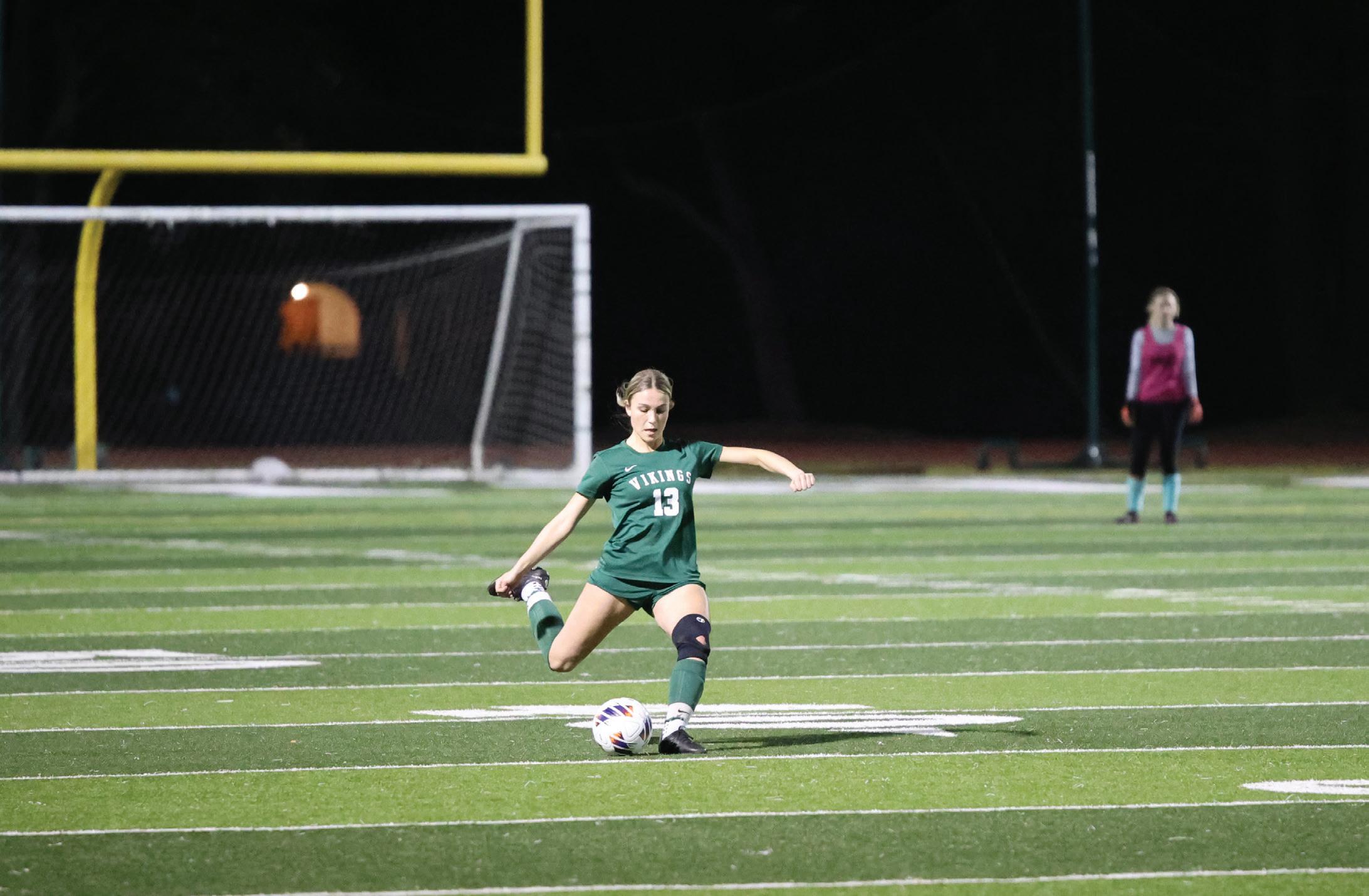




Alexa Gwyn’s vision — building a thriving field hockey program at Paly — turned her passion into reality. — Page 22


would
Thieman Family
Wang Family
Schoebel Family
Cheung Family
Tung Family
Ginwalla Family
Telyaz Family
Weiner Family
Lee Family
Salvatierra Family
Bharat Family
Cho Family
Dogan Family
Scott Joachim
Steele Family
Liu Family
Pashalidis Family
Junowicz Family
Jonathan Levav
Kivett Family
Editors-in-Chief
Claire Cho, Ethan Wang, Roan Haney, Emil Bothe
Creative Director
Nathan Lee
Photo Editor
Lucas Tung
Business Manager
Sarah Thieman
Copy Editor
Scarlett Frick
Head Columnist
Tyler Cheung
Social Media Manager
Amanda Goody
Online Editors-In-Chief
Arjun Bharat, Luke Joachim
Staff Writers
Adi Weiner, Elena Salvatierra, Dylan Robinson, Isaac Telyaz, Evin Steele, Jonathan Yuan, Natalya Kaposhilin, Zoe Pashalidis, Malcolm Ginwalla, Max Merkel, Jake Liu, Elif Dogan, Carter Burnett, Ben Levav, Finn Schoebel
Adviser
Brian Wilson
This cover, with the photo on the left courtesy of Alexa Gwyn, features Alexa Gwyn playing Field Hockey and the 2024-25 season senior night on the right. This feature story on the rise of the Field Hockey team can be read on page 22.
Hey Vikes! We are so excited to release the first issue of 2025!
We’re starting the year off strong, covering the historic Paly vs. Gunn rivalry on page 18.
We then explore the incredible rise of the Paly field hockey team on page 22, documenting how one driven student started a program that continues to grow year in and year out.
On page 12 you will discover the role that statistics play in sports.
Next, on page 14, we look at the impact of a pregame pep talk.
On page 16, we dive into how the student section supports our Paly athletes.
We then look into another aspect of athlete support, looking at how the se-
nior poster tradition has developed at Paly on page 26.
In Flipping the Script on page 28, we explore the variety of options that athletes have to balance their academics and athletic commitments.
The Elements of Victory on page 36 looks at the impact of weather on Paly sports, and how even in a more mild-weathered place like the Bay Area the elements can severely affect athletes.
We also cover the risk of skiing on page 34, and how athletes can practice safety on the ski mountain.
An underappreicated aspect of sports, plyometrics, is documented on page 38.
athlete spotlight, Max Newman, and his journey as a boxer.
Within the Walls on page 42 highlights a less common sport for Paly athletes: squash.
We also look into the impact of an athlete’s “lucky items”, and how that can affect their performance on page 32.
Lastly, the Final Word for this issue on page 45, Beyond the Arc, looks at ways the NBA can increase viewership and revitalize the sport of basketball after a decrease in popularity in recent years.
We hope you are having a wonderful new year, and are excited for you to dive into this Viking issue!
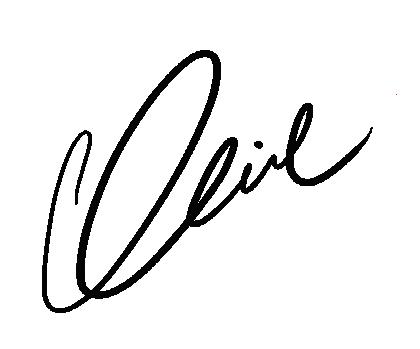
On page 40, we focus in on this issue’s
Roan Haney
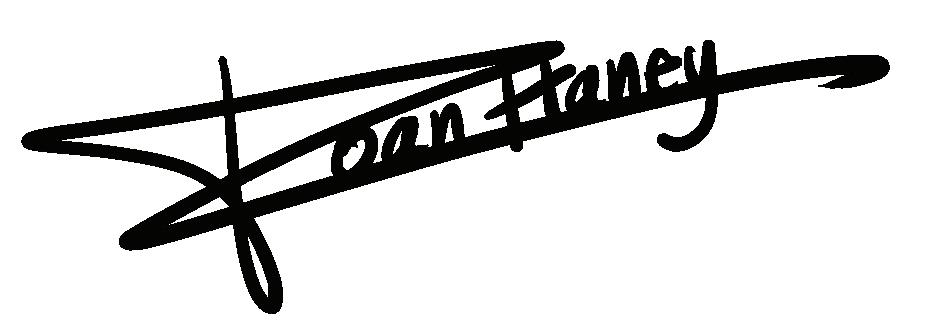
Golf has always been a game of strict tradition, slow play and pensive strategy. However, not all traditions are meant to last forever, and with other slow paced sports on the decline, the slow flow of golf needs to change. The recent development of Tomorrow’s Golf League, or TGL, has revolutionized how golf is played. By bringing a tech-driven approach that combines real-life play with a large simulator screen technology, it creates a fast-paced environment that engages and appeals to old and new audiences. Based on this growing success of TGL, the PGA tour should begin taking notes of TGL in order to improve.
TGL is a matched based 3v3 league that plays their holes on a 64 by 53 foot simulator. It incorporates a lot of futuristic features like a rotating green, and radar based ball tracking technology. Most importantly, TGL enforces a 40 second shot clock that forces players to speed up their approach to shots.
For the PGA tour, pace of play has been a growing issue and taken a toll on viewership. From 2023 to 2024, the PGA tour experienced a 20% decrease in viewership. Although the PGA has many rules
Emil Bothe


in place to speed up the pace of play, this rule is rarely enforced. Players sometimes use up to four minutes per shot, especially in high stress situations or when looking for the best angle for putting. Reading the green is important, but over analyzing each shot disrupts the flow of golf and fails to keep fans engaged.
Slow play has widespread effects. Like a traffic jam, one slow player delays everyone behind them. Rounds are sometimes cut short by darkness, as most golf courses don’t have additional night lighting. At a 2024 PGA tournament, players were forced to finish in near-darkness due to slow play. The TGL, however, avoids issues like this by using the 40-second shot clock. The PGA tour should take note of this and implement their own shot clock system. A 40-60 second shot clock can be added to traditional PGA tour play, which could be enforced by officials or a scoreboard. This would drastically improve pace without disregarding strategy and gameplay. The shot clock would start after the players are given a reasonable amount of time to walk to their ball. Additionally, the PGA tour has had issues with enhancing their spectator ex-
perience at tournaments, especially for less frequent fans. TGL combats these problems by creating a stadium-like environment, with lights, music and live interviews, where all fans can get the most out of their experience. The PGA tour has tapped into this idea, but not fully incorporated it in most of their iconic courses. Hole 16 at TPC Scottsdale is a perfect example of what the PGA golf-viewing experience should look like. At this short Par 3, grand stands were built surrounding the entire hole, creating an electric stadium feel during the Phoenix Open this year. This unique aspect added excitement to the otherwise normal tournament.
Ultimately, instead of living in the past, the PGA tour needs to address their issues with pace of play and the spectator experience by taking inspiration from TGL. Incorporating a shot clock will speed up the overall flow of the game, and focusing more on big grandstand setups can modernise the golf viewing experience for all. While yes, many still watch and appreciate the traditions of golf, it is important to move forward towards the future.

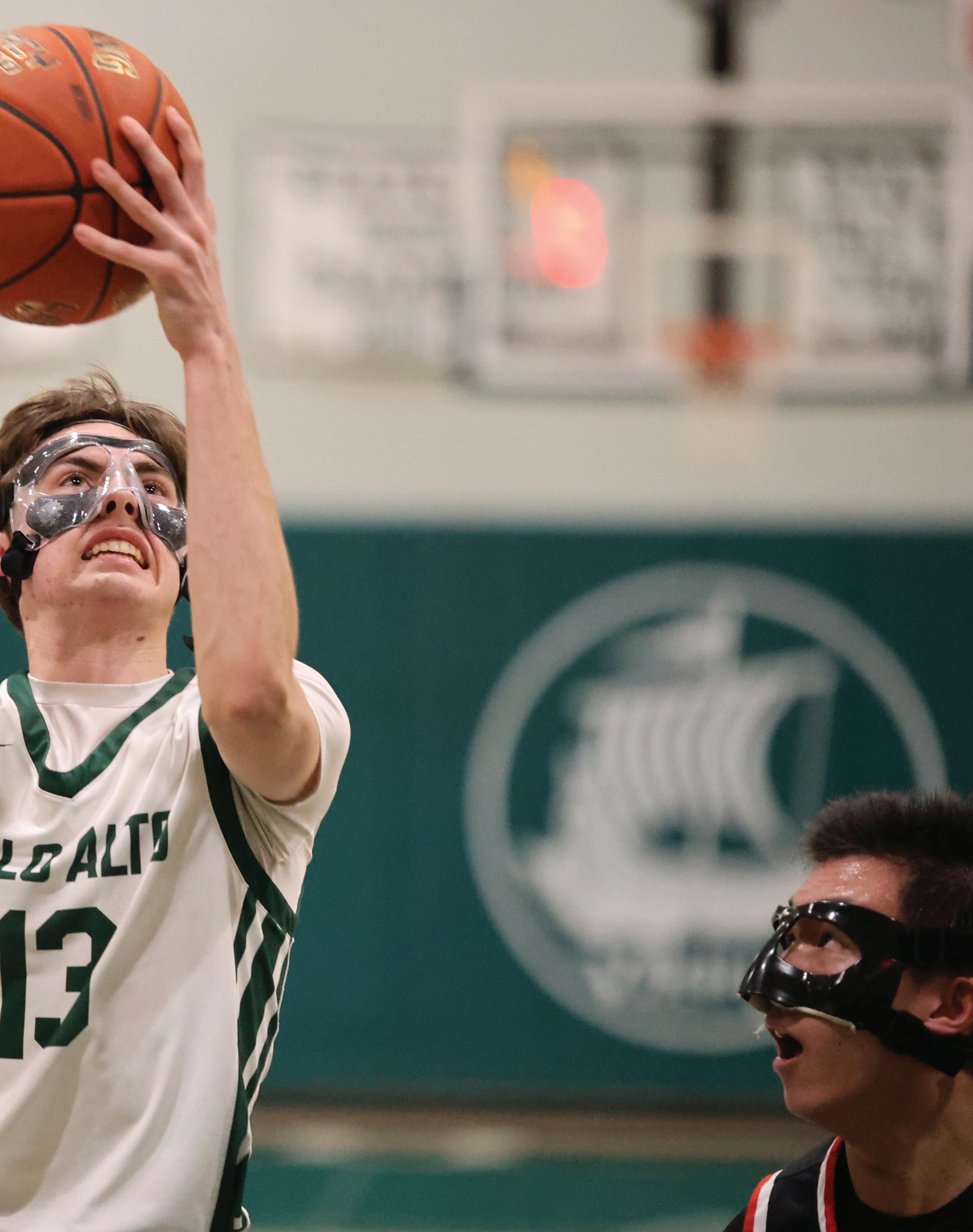
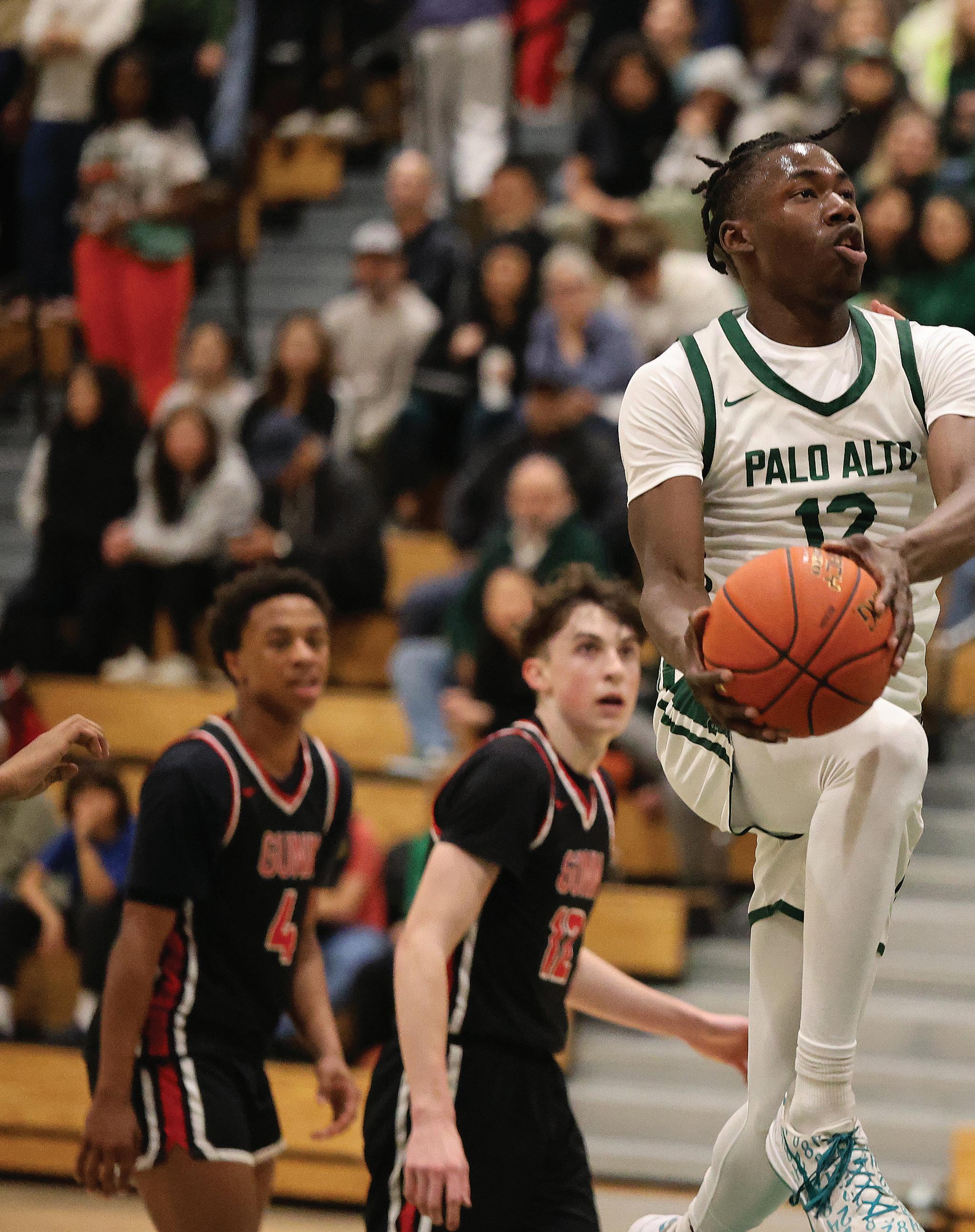
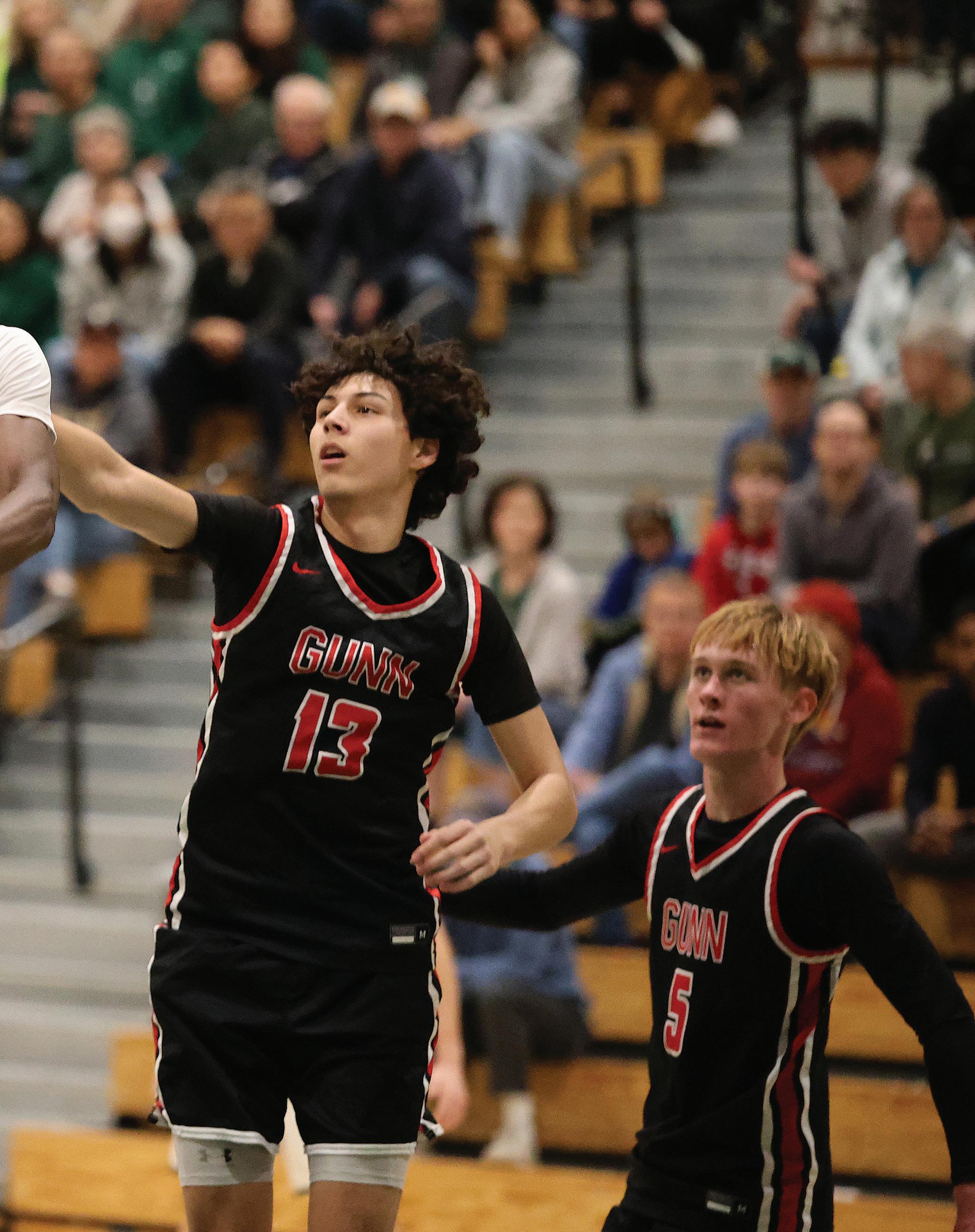

Wilson Ernst (‘25) takes a clutch-time corner during a 2-1 loss to Santa Clara.

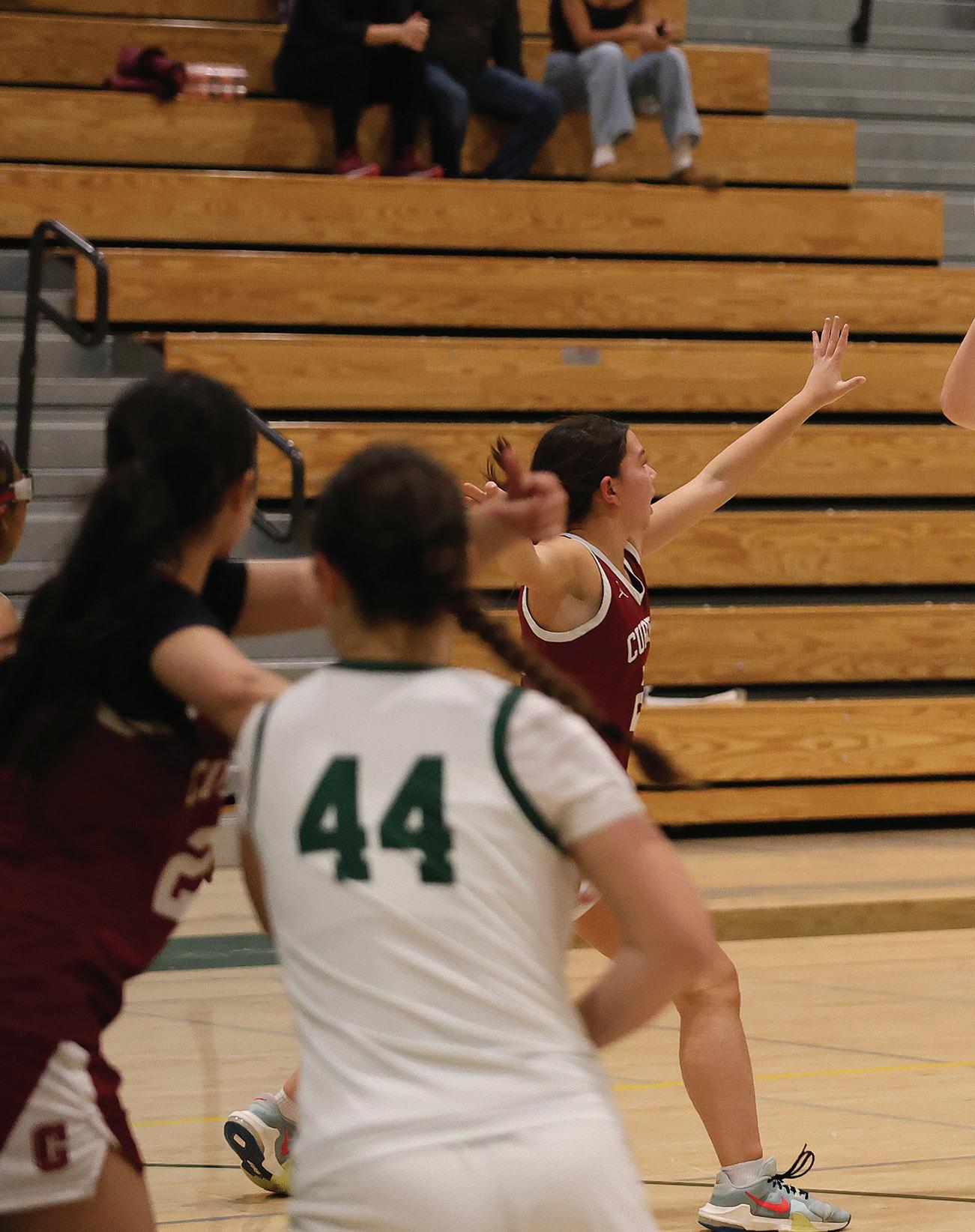
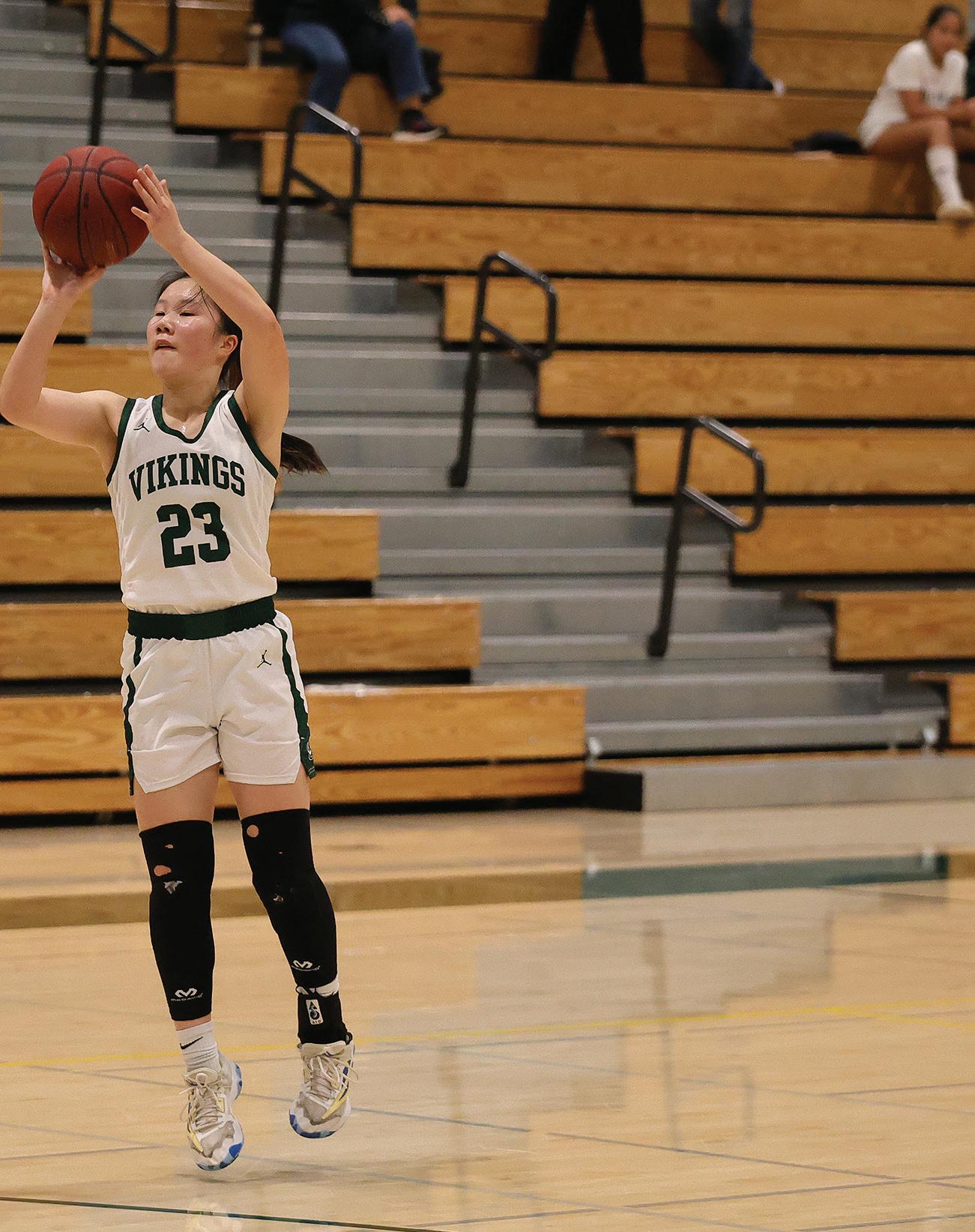
Sophie Li (‘28) shoots a contested 3-point shot against Cupertino in a 35-25 win.
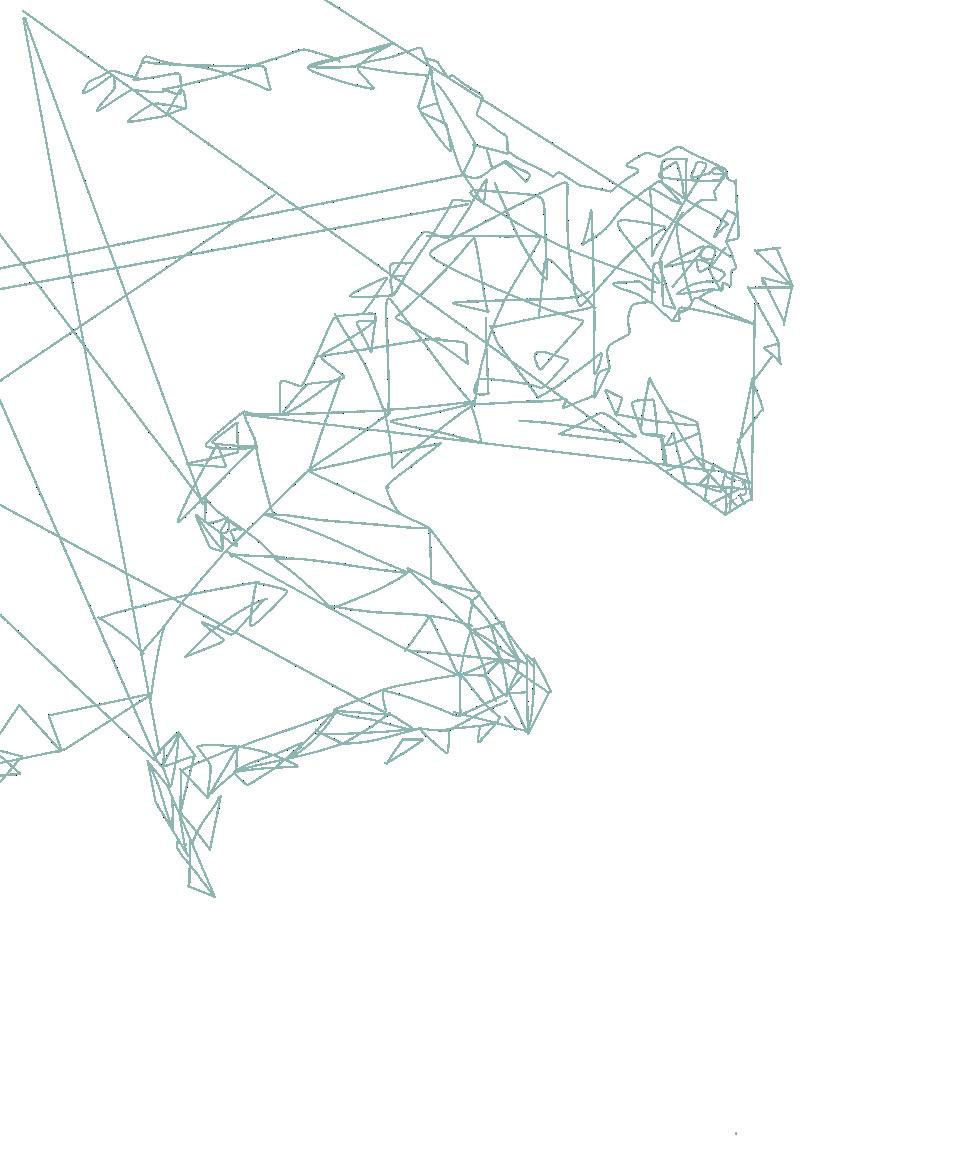
By NATHAN LEE, JAKE LIU and ZOE PASHALIDIS
Statistics have been increasingly more popular with the increase in technology, but what role does it play in sports?
With spring sports just beginning, we’re looking to see what each sport is hoping to achieve this season.

“As a team, the goal is to win as many meets as we can this season while having fun throughout.”
— Yuka Hara (‘26)
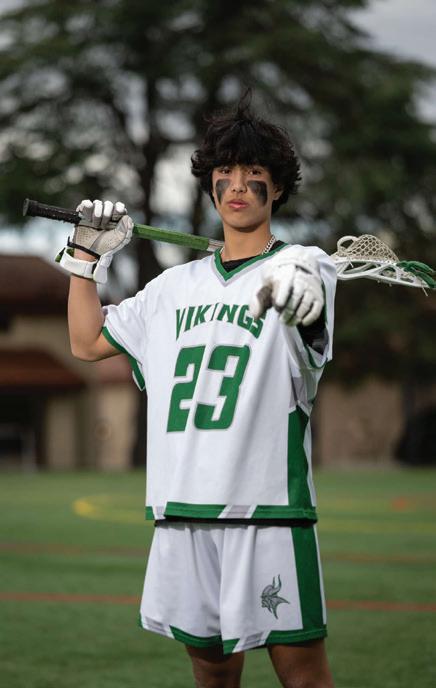
“This season we hope to win league and compete for the CCS championship.”
— Kane Do (‘27)
We spoke with Joshua Yuen, Paly alumnus and sports analyst for the Mariners to talk about how he uses statistics, as well as how it is implemented in sports.
Q: What are some of the ways that analytics have been used beyond the traditional counting stats, such as points or batting average?
Q: How can high school sports teams use data to improve team development?
A:“We’re able to make it a little bit more granular in the form of athletic testing or player development.”
A:“High school sports can use a surface level of statistics in sports, being able to look past data and look at success rates.”
Sue La Fetra, art teacher

“I have always been a 49ers fan, even back when Joe Montana and Steve Young were playing. I knew some people that played for Niners back then.”
Rod Satterwaite, journalism adviser

“My favorite sport is baseball, because it is the great American pass time. I find it very soothing to watch a baseball game.”
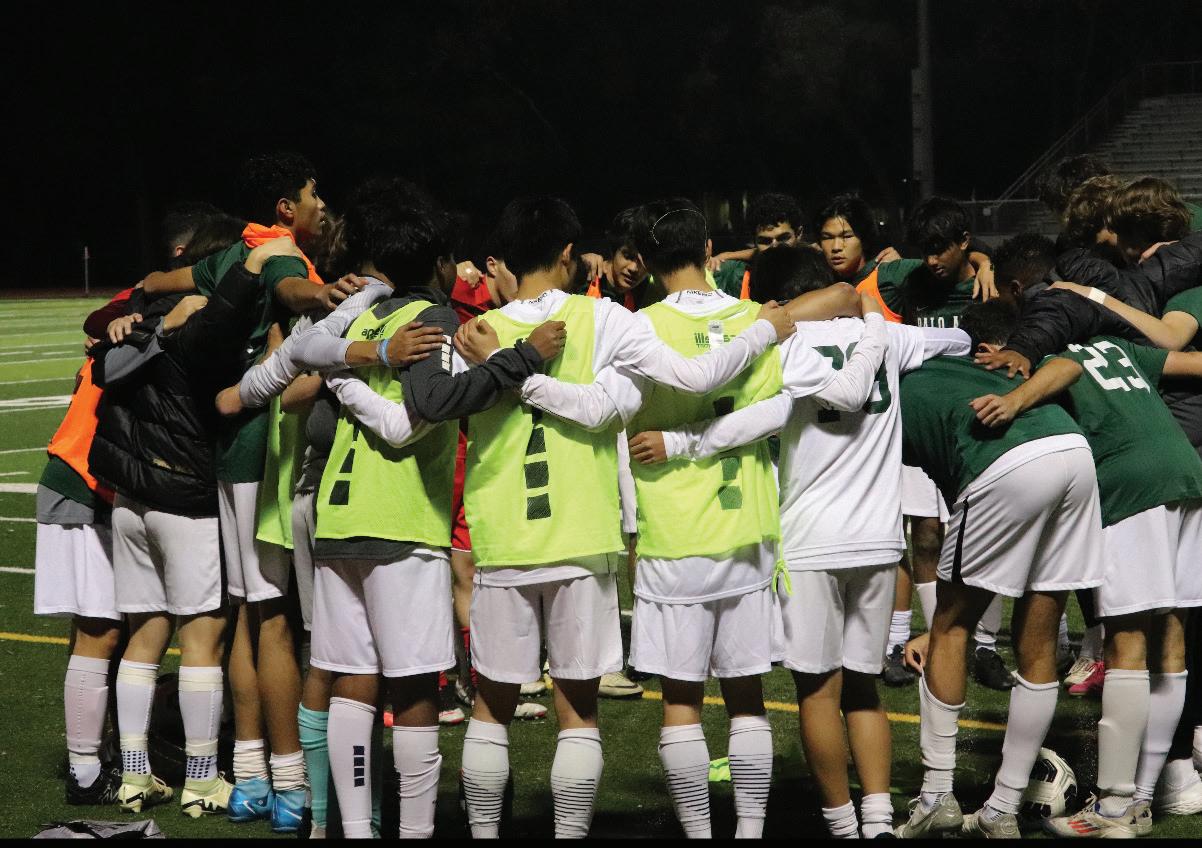
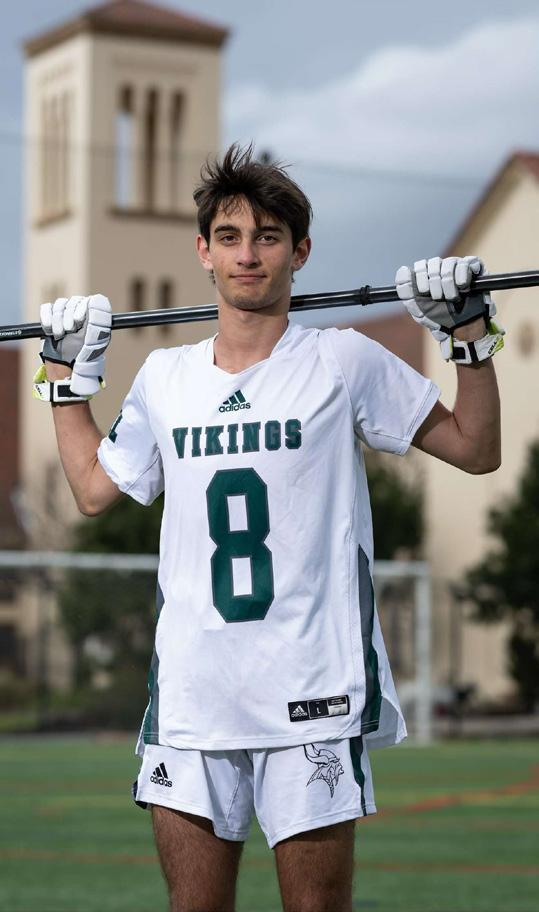
“Hearing motivational words as a team helps us play better. Motivational speeches get us hyped up for the game.”
— Lucas Grodnitzky (‘26)
Recently, more and more athletes are putting more effort and care into how they look during their games.

“I wear wrist tape on one of my fingers because when playing soccer, perception is a big part of the game.”
— James Park (‘26)
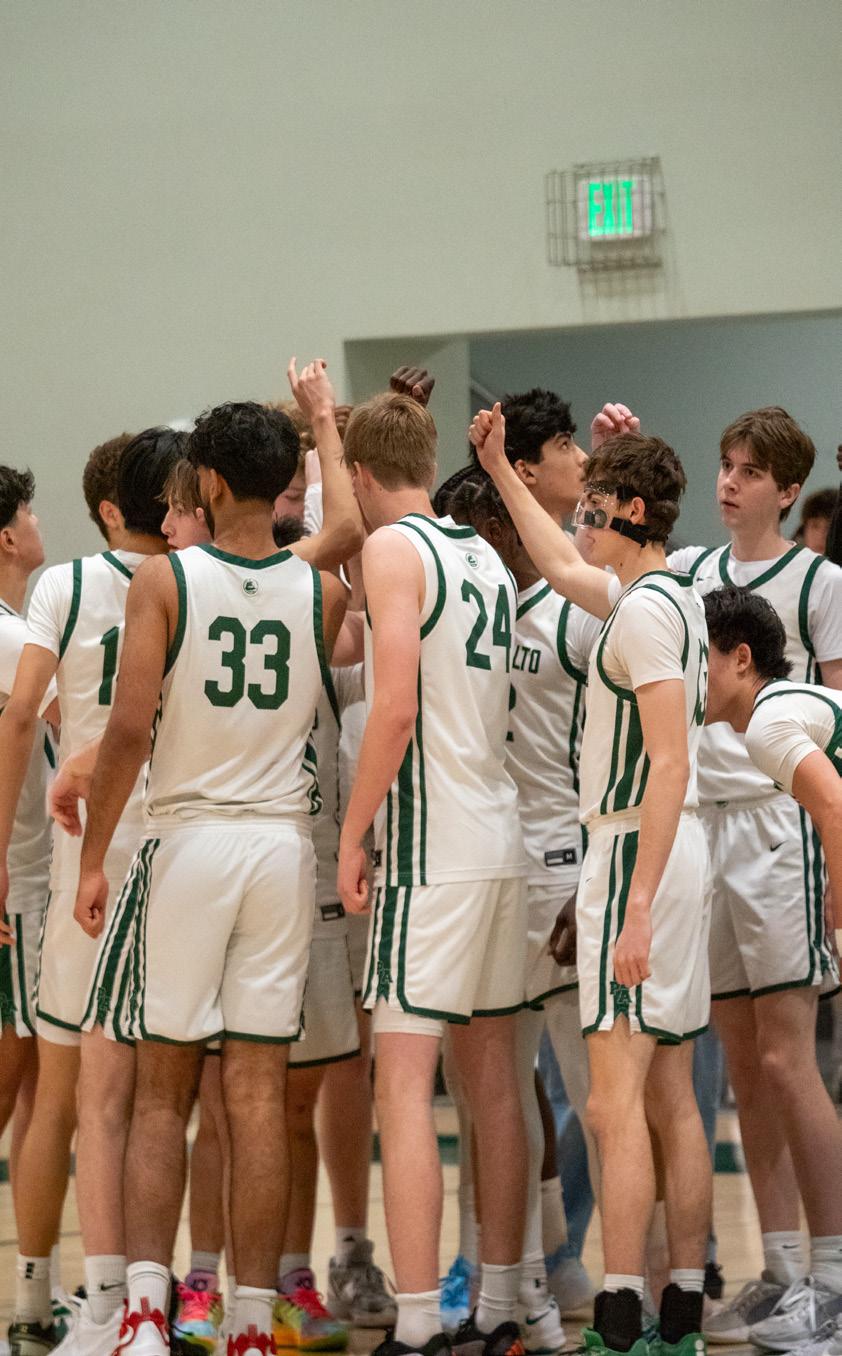
“I mainly carry my dance shoes. I always carry a water bottle to stay hydrated and hair ties for keeping my hair out of my face while I dance.”
— Audrey Erikson (‘27)
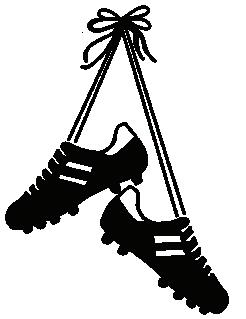
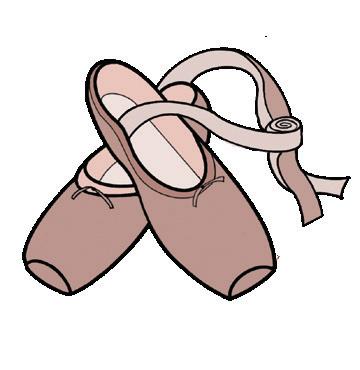
“I keep my hoop shoes, my speaker that boosts the team’s energy with pregame music, and my practice jersey.”
— Thomas Groden (‘27)
“The most important things that I have in my bag are gloves and turf shoes.”
— Nate Robinson (‘26)

“I wear a ninja headband because it looks cool and in honor of Richie Ogawa, to keep his legacy alive.”
— Taishi Liu (‘25)
“I like my cleats to match with my jersey and the Paly colors, as well as my stick which is white and green.”
— Richard Zhang (‘27)

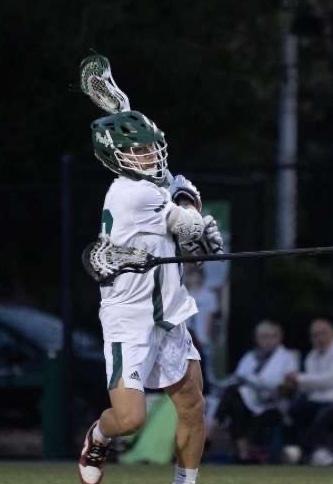
by ELIF DOGAN and NATALYA KAPOSHILIN
Paly students have supported their athletes for decades by showing up and cheering them on with many spirited Paly-themed chants, as well as more traditional sports chants. With all eyes on these athletes, does the support from the student section make or break Paly Athletes’ performances?



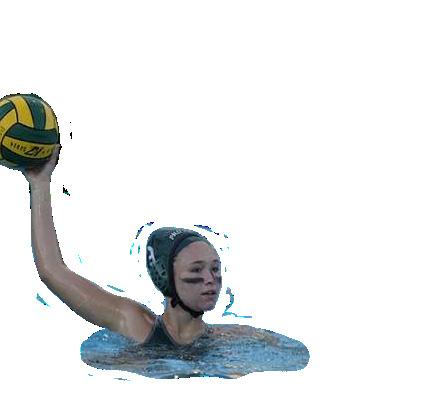
The energy from the student section and having a crowd generally puts put on a player to perform well — [it can] either increase my performance and drive in a game or alternatively make me play worse. It’s hard to differentiate between the voices of my teammates, coach, and the crowd. However, knowing that people come to raises our spirit and gives us more motivation
The student section is cial to a game’s atmo sphere crowd and seeing all of your friends makes you want to perform well and show them that you’re capable. It gives me more energy because I don’t want to let down the fans that are supporting our team.
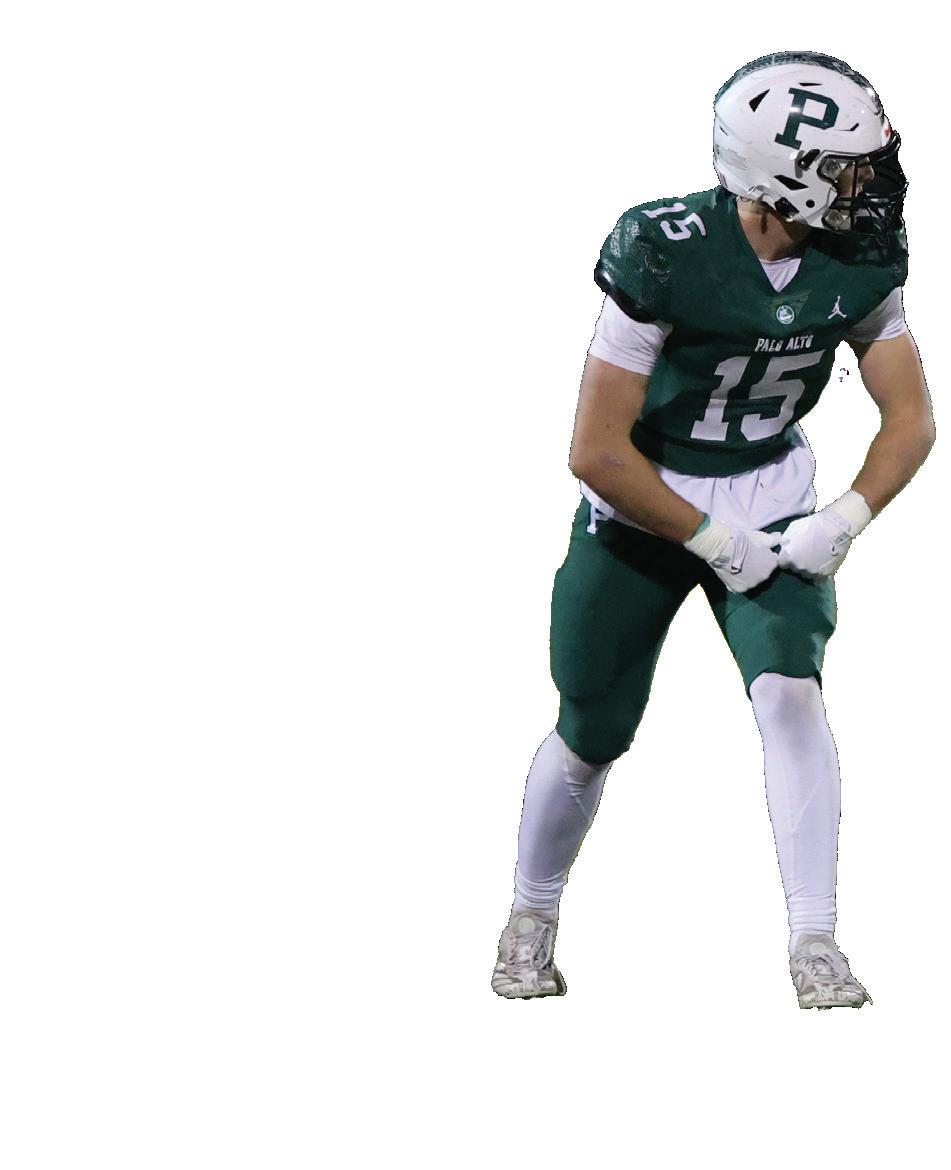



Loud crowd chants just uplift our team and gives us that exeven when we’re tired ... They provide energy after a big play, like during one of the dunks I had in the Gunn game, there was a lot of energy going through the building and it forced Gunn to call a time out and helped us ultimately win the game. The student section’s energy is really important to the overall team atmosphere, but besides rivalry games, there isn’t much of a crowd providing us with energy and momentum.
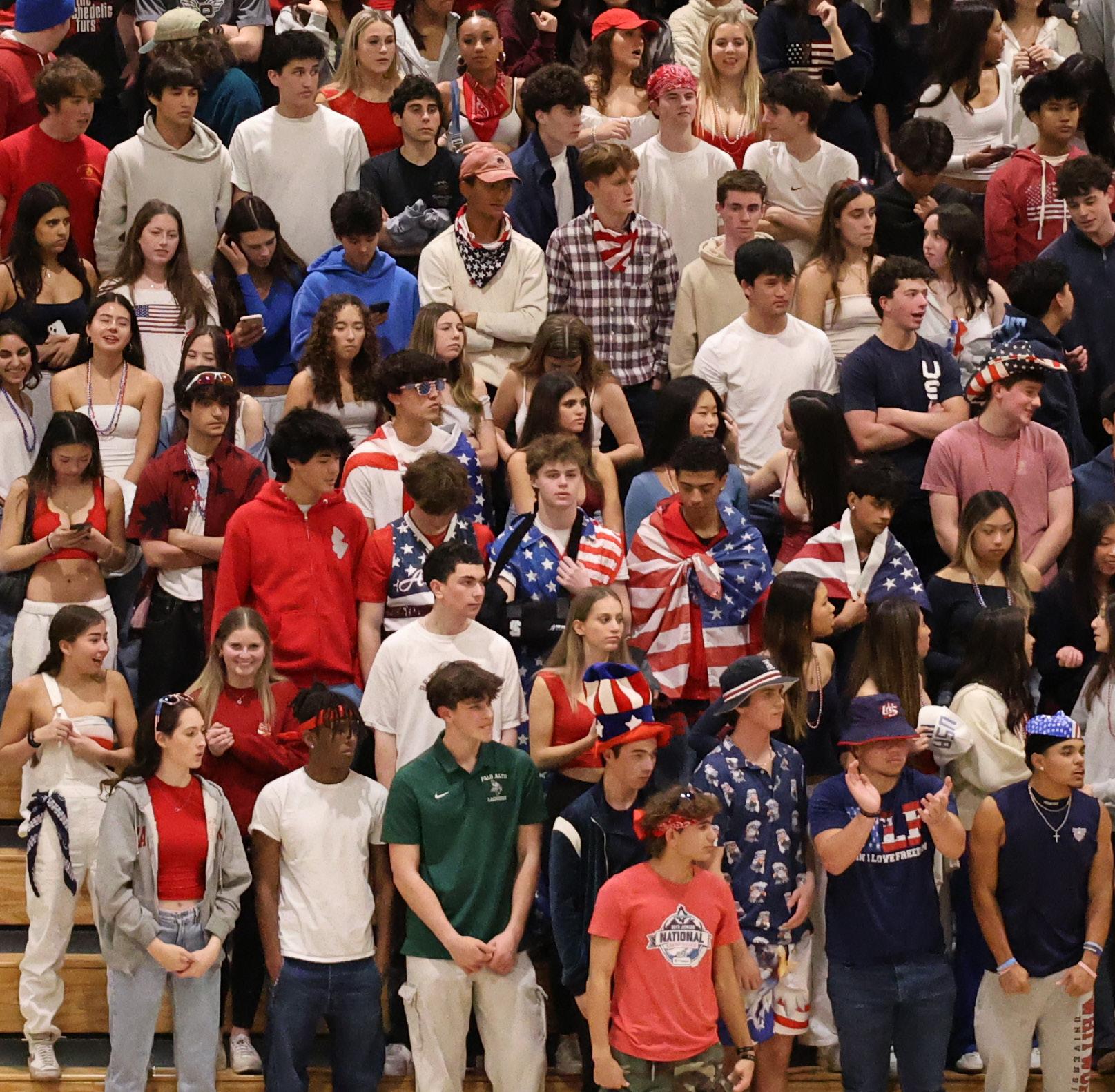

Paly sports would not be the same without the spirt of the student body eminating from the stands in the form of cheers and chants. Viking polled students at Paly (athletes and non-athletes alike) to see which chants or cheers were their favorites.







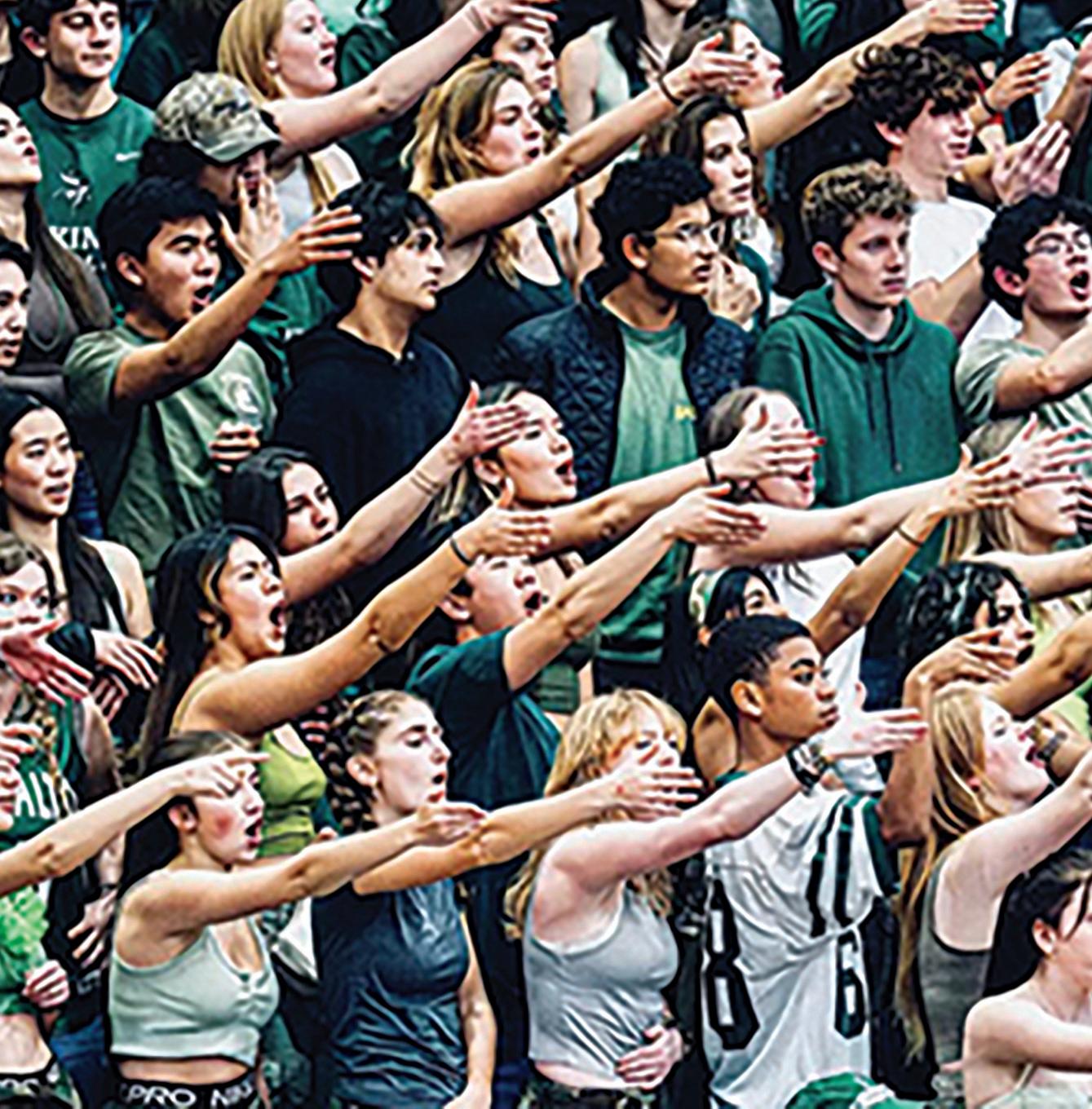

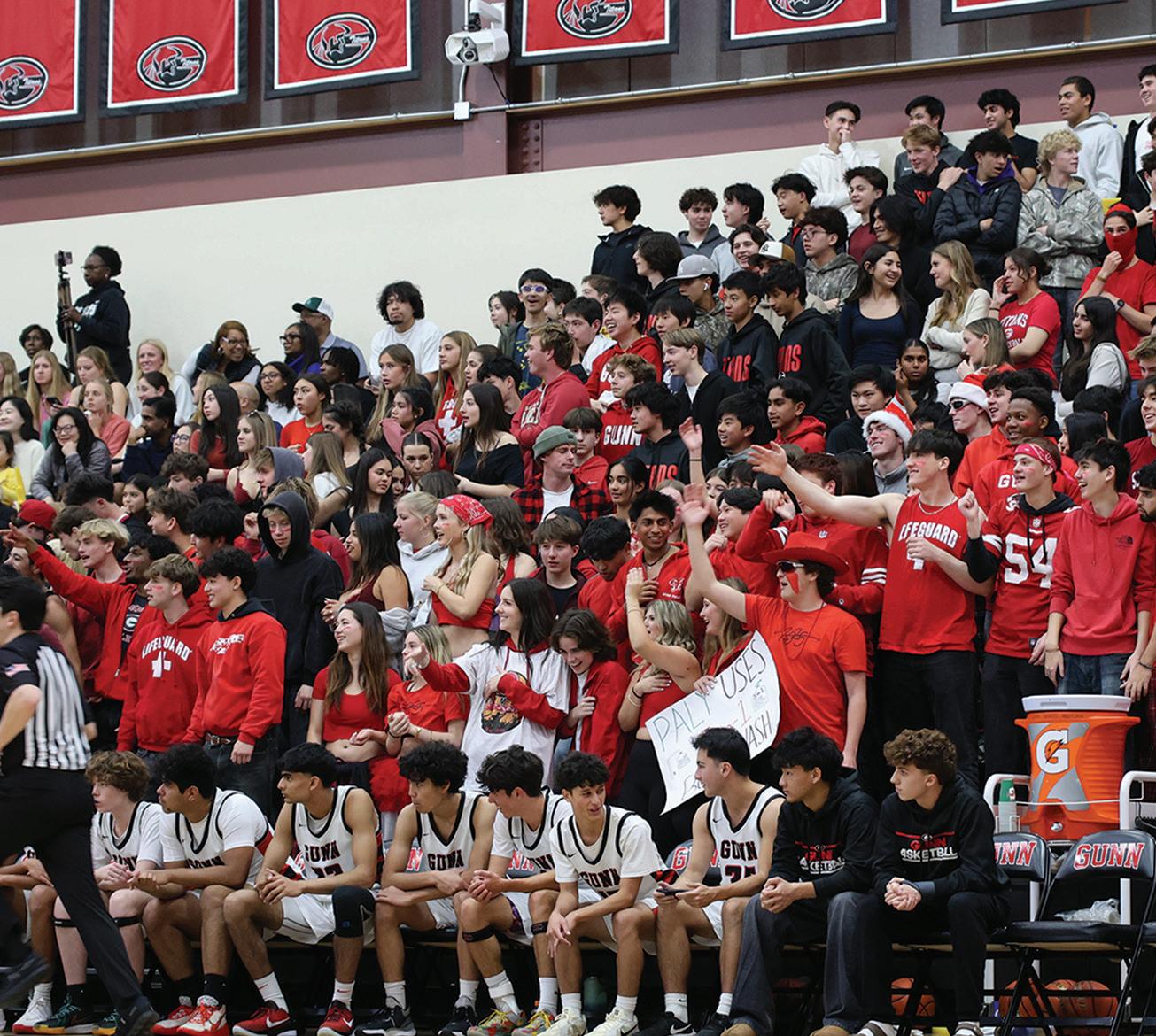
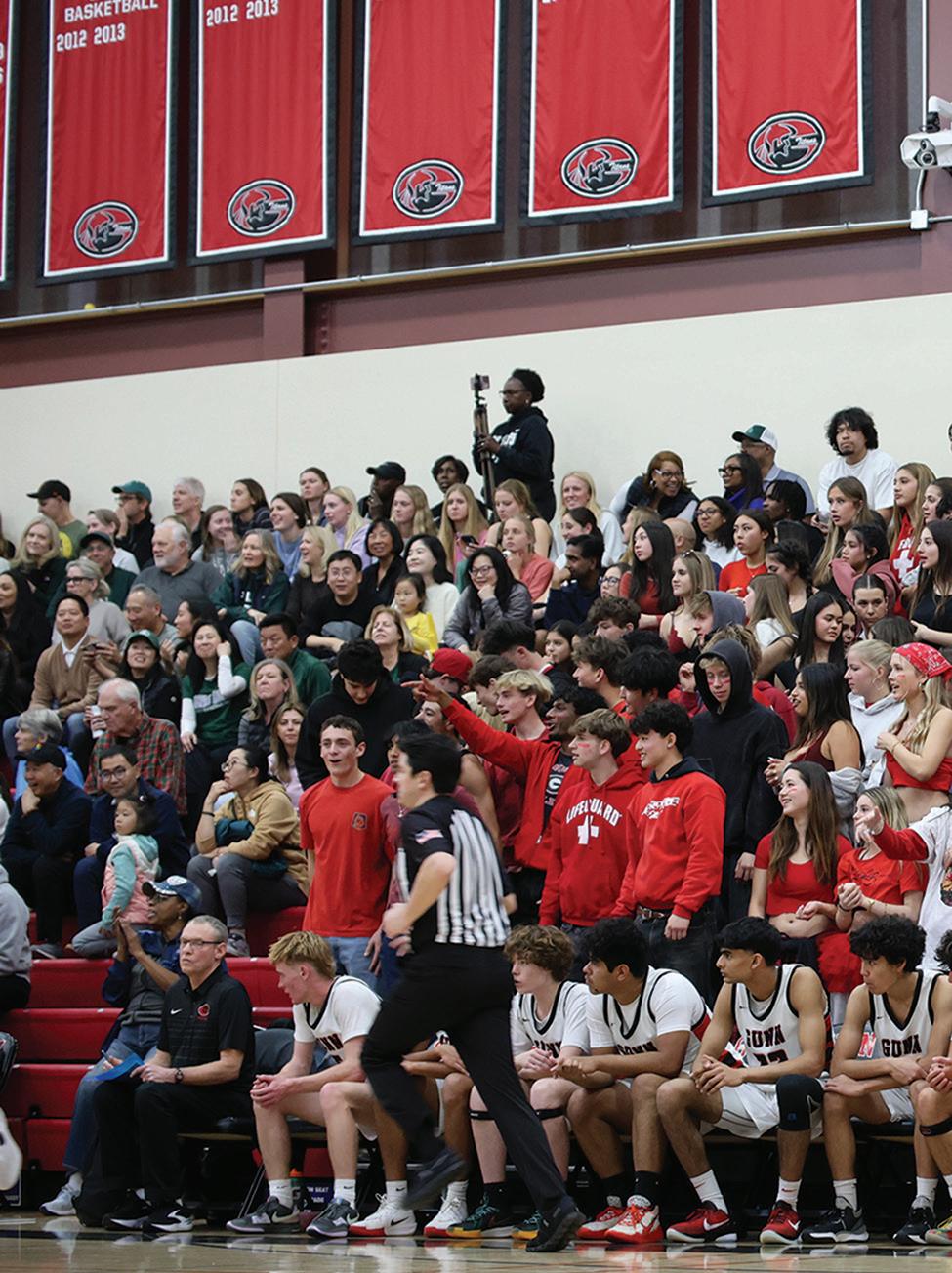
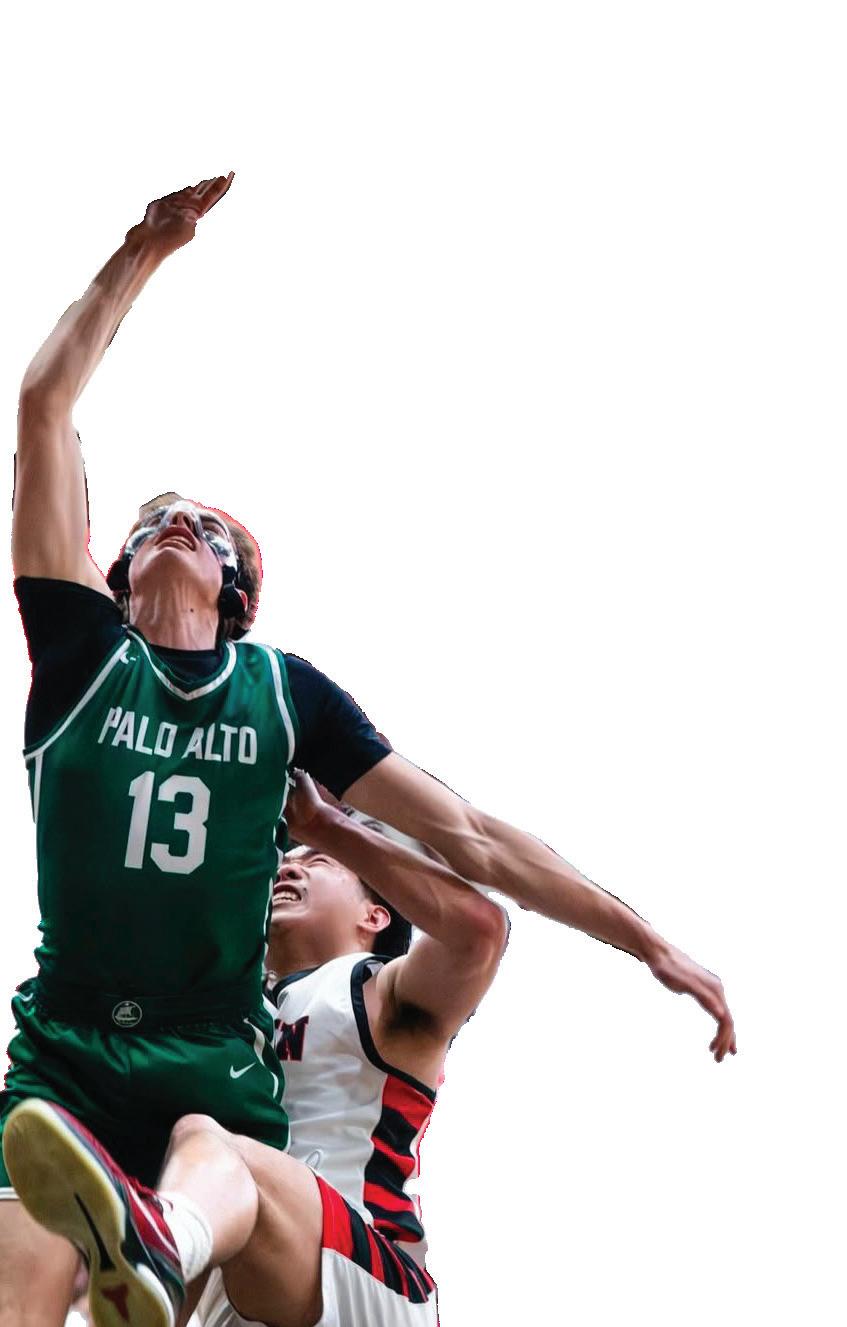

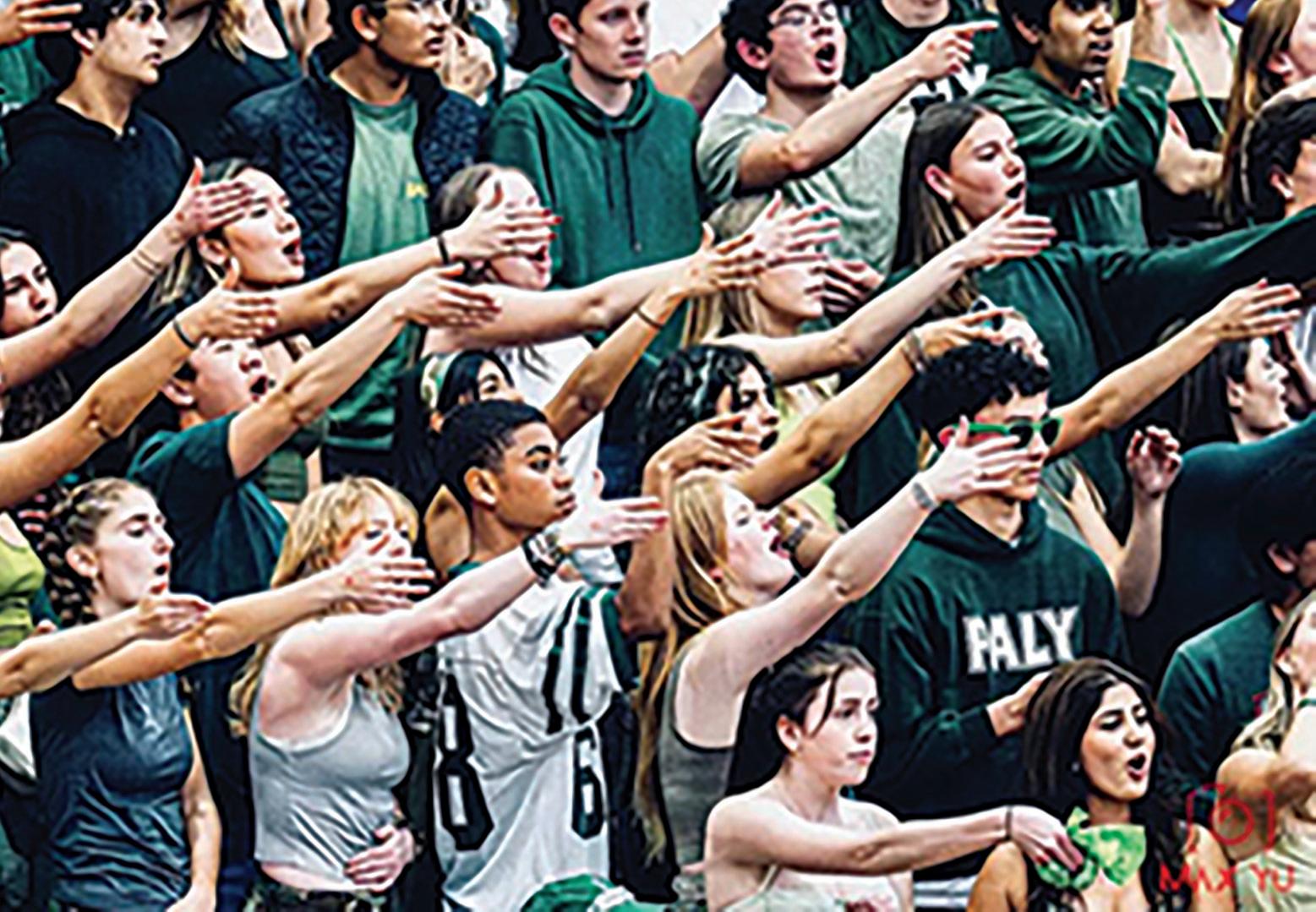
For decades, the fierce competition between Paly and Gunn has ignited students, creating legendary moments and uniting the community. But as matchups shift and dynamics change, what does the future hold for the historic rivalry.
R“To this day, I just remember, in the moment going, ‘I can’t remember ever hearing anything that loud before’” — Peter Diepenbrock, former Paly coach
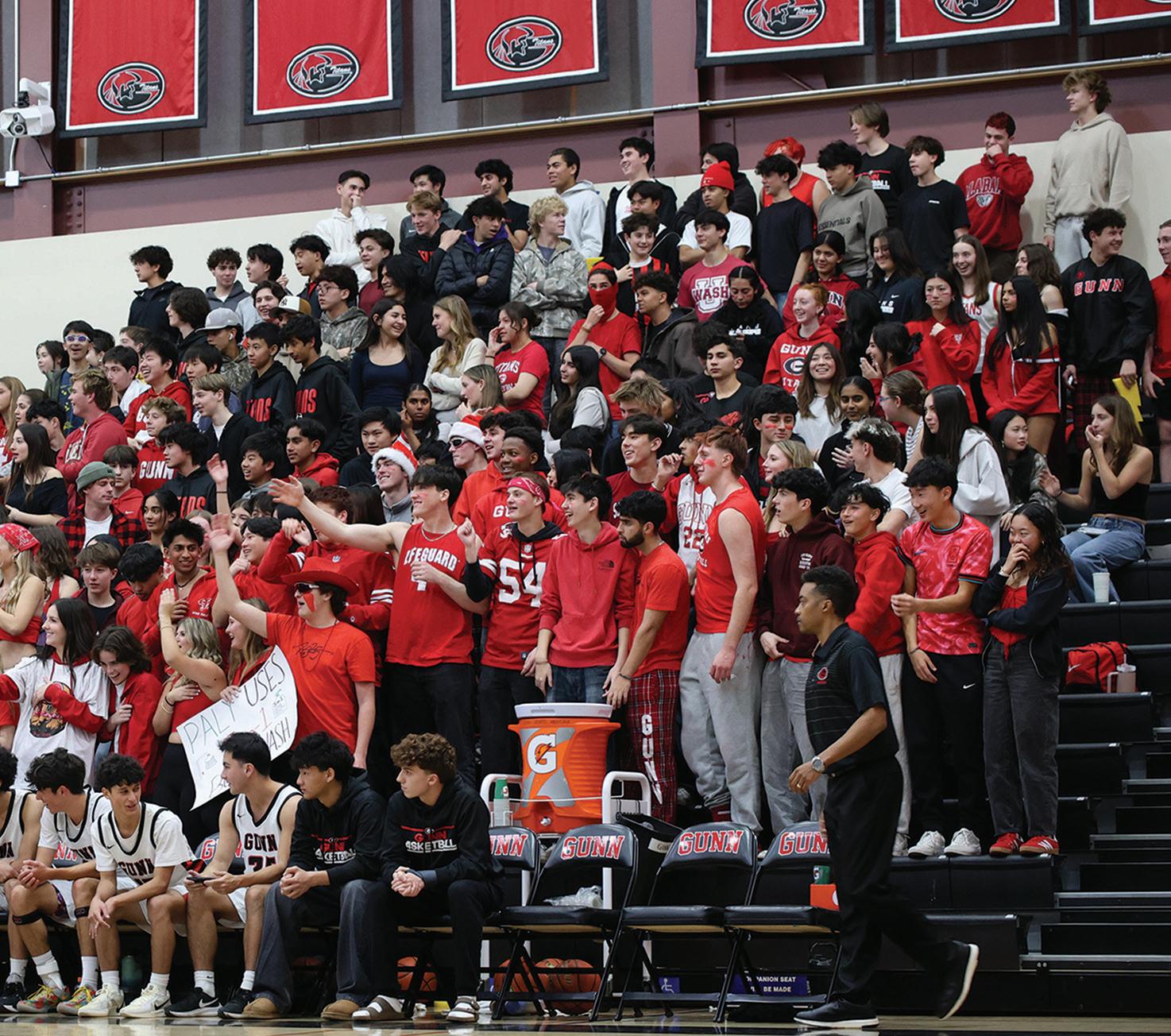

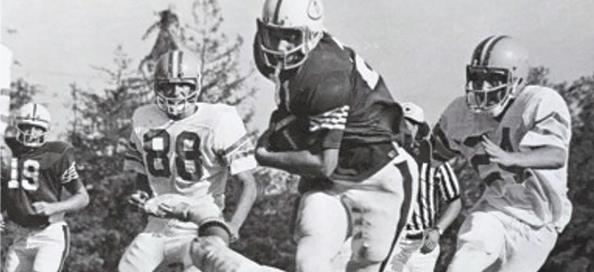
casing signs to repre sent their schools. The two schools go headto-head in fiery matchups in many sports, yet even within the competition, they still stand by shared values and traditions that help maintain the Palo Alto community.
“Although the teenagers in the city are split into their own schools, the students from Gunn and Paly
Photocourtesyof Madrono
portant part of Paly’s history. Peter Diepenbrock, current P.E. instructional lead, began working at Paly in 1997. During his 14-year tenure coaching boys’ varsity basketball, Diepenbrock led the team-featuring Paly alum and former NBA star Jeremy Lin to a 2006 state Division II championship win and two consecutive Norcal Division I
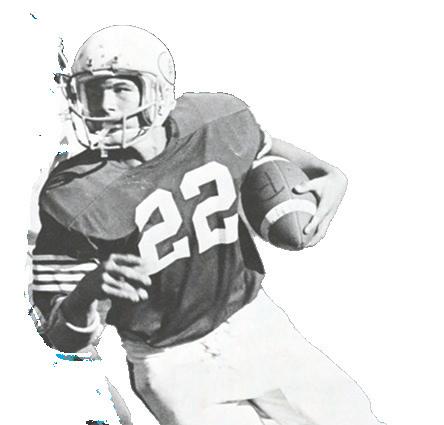
both played on and later coached the Paly football team, remembers the intensity of the match-ups during his time.
“When I was a student, there was only one middle school, so everyone went to JLS and then split to the two high schools, so the student bodies knew each other more, which definitely impacted the rivalry,” Foug said. “Football at that time — both teams were pretty bad since the schools were small. They were undisciplined, and there was an unfortunate incident in 1990 between the two teams, when I was on the team.”
In that infamous 1990 rivalry game, a late hit on the Paly quarterback sparked a bench-clearing fight between Paly and Gunn, with physical altercations between

“This cross-town rivalry fuels my desire to perform my best during games and meets against Paly.”

that traditionally is the centerpiece for high turnouts and spirit. After 1965, the two schools kept the rivalry spirit alive, playing each annually for 47 years, with Paly holding a series record of 34-13. However, after Paly’s 48-0 victory in 2012, the teams stopped playing each other for the ensuing decade.
“To be honest, I think it’s embarrassing that they don’t play us in football… it’s really a shame, in my opinion, that we don’t play them in football,” Diepenbrock said.
— Eda Ertas, Gunn student (‘26)

out was significant, with both coaches being fired, and remains a legendary moment between the two schools. Afterward, Earl Hansen was then hired as head football coach, whom the Viking Stadium was
The two schools stopped playing each other due to disparities in league standings and level of play. Assistant Principal Jerry Berkson elaborates on the reason the two schools no longer meet on the
Paly section didn’t have any idea what was going on — it was a mob mentality — everyone just kind of ex citedly followed people that were run ning, so most the students that ran did it for no reason,” a Paly student who chose to stay anonymous said. “I think there were discrepancies between how the students and the players view the situation because multiple people at Gunn didn’t think it was that big of a deal…everyone kind of thought it was funny besides
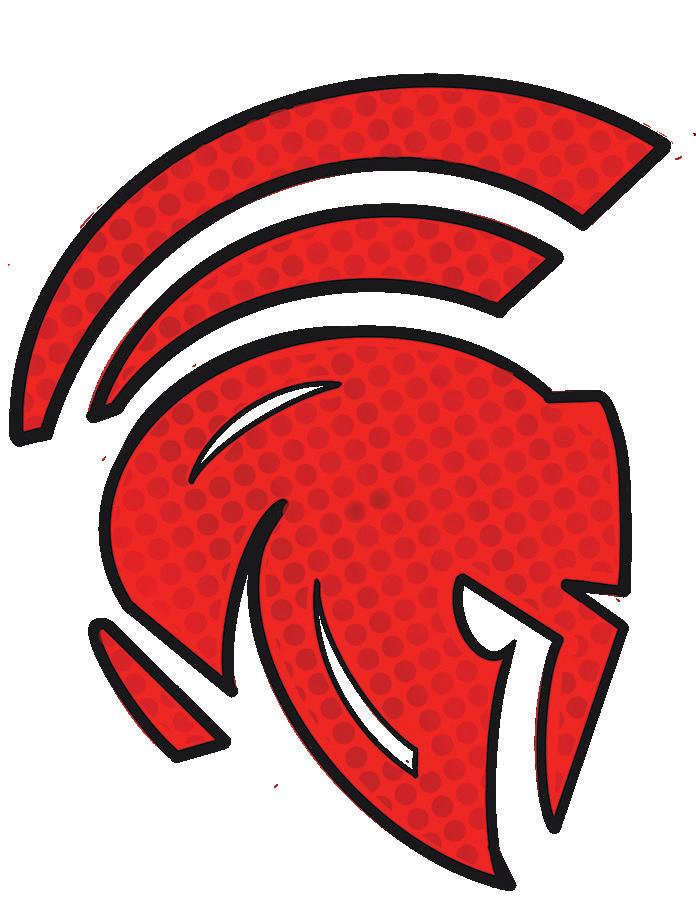
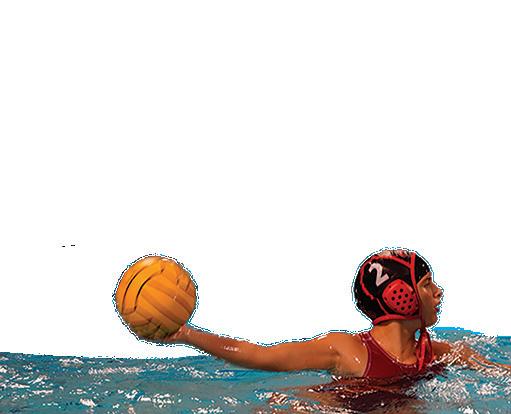
“This rivalry is something that has become personal so we’re prepared and ready for their [Gunn basketball] spike in effort.” — Jorell Clark (‘25)
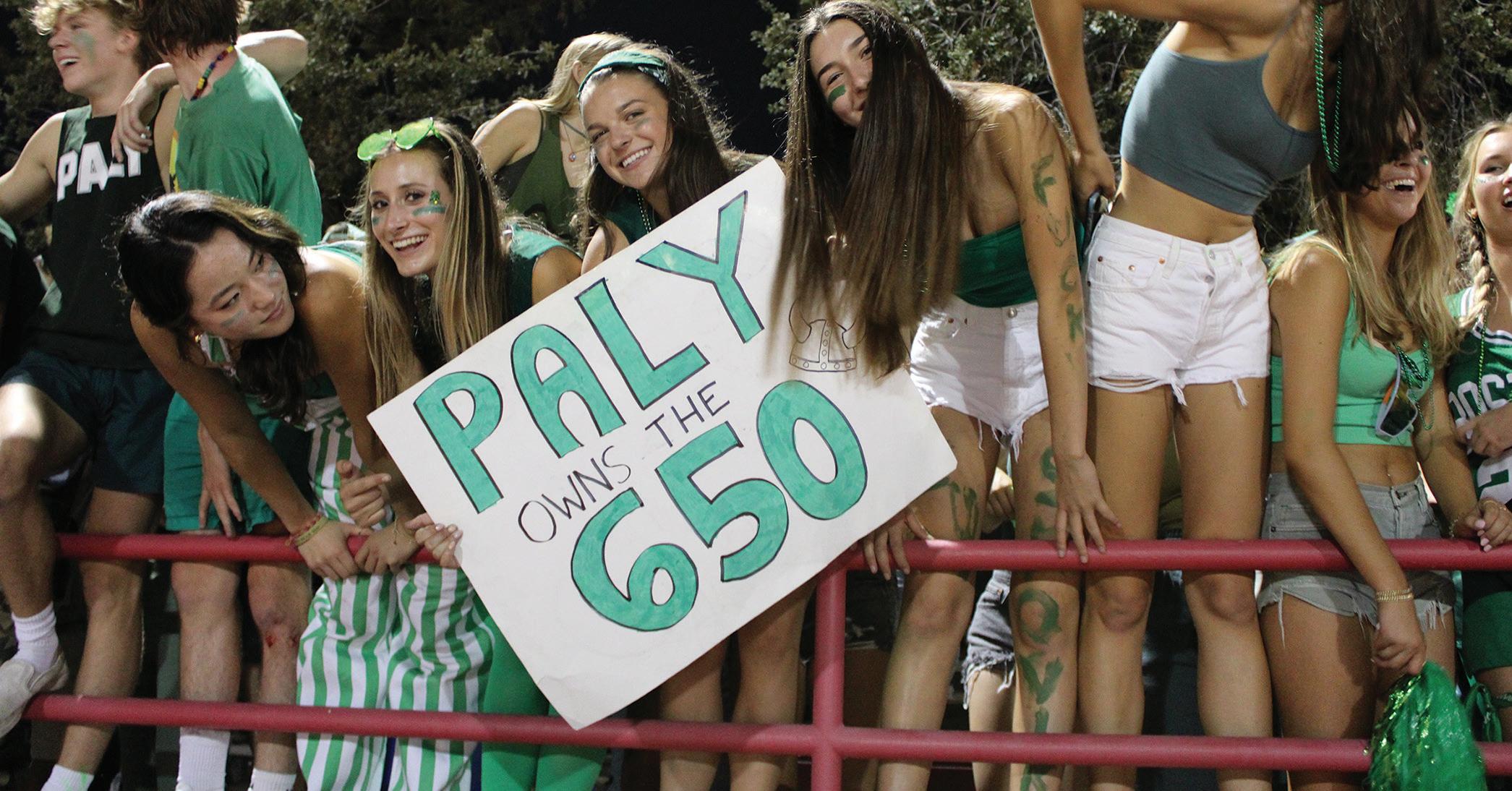


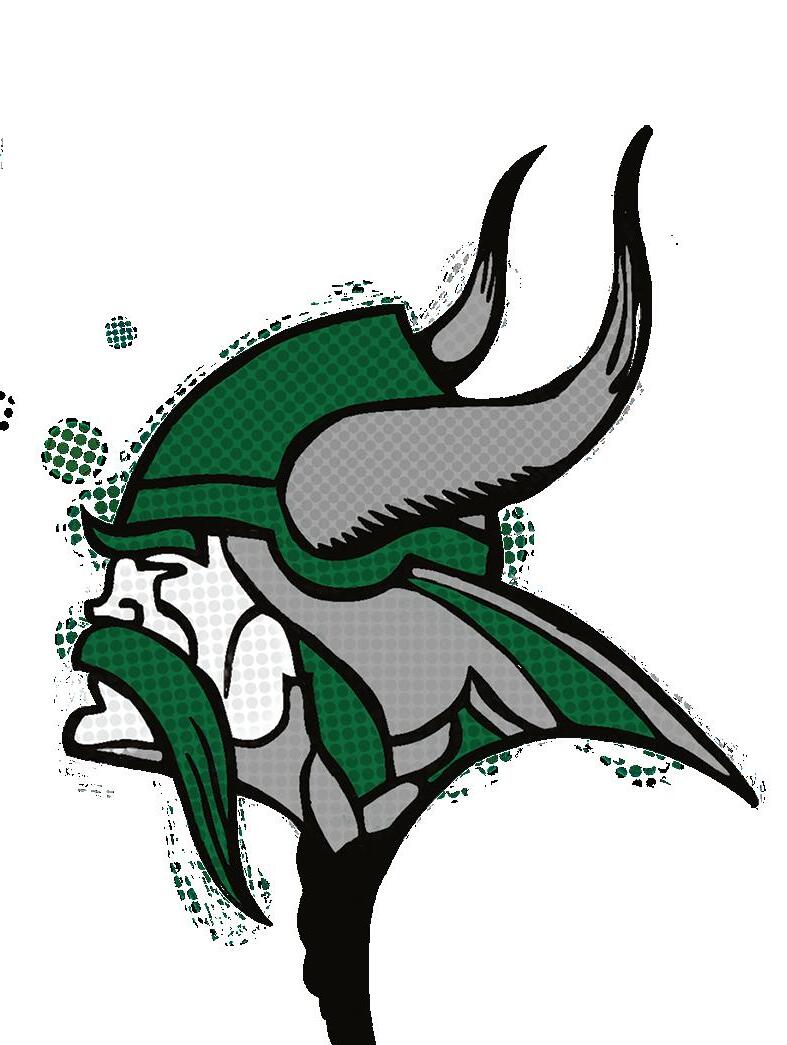
lective effort to encourage sportsmanship while maintaining entertainment. Gunn and Paly administration collaborate on expectations and behavior. Jenny Crane, Athletic Director, has been in the position
“It’s a delicate balance between fostering an electric atmosphere and ensuring everyone feels welcome and respected, but with proper planning and communication, we aim to make each event positive for all involved,” Crane said. “We also increase the presence of staff and administrators at these events to monitor and be proactive with addressing any potential
Crane highlights how rivalry games attract large crowds, not only students and parents, but also alumni and members of
“These events are often seen as marquee moments in the athletic calendar, and the energy and support from fans re-
Paly and Gunn have had their fair share of conflicts, but that conflict and tension is what brings excitement and fire to any notable rivalry. At the end of the day, within the chants and ridicule, it seems these opposing schools bring the community together with their competition. Students that are on complete opposite sides of the city during the school day, come together on game nights to enjoy an exciting display of athletics, passionately root-

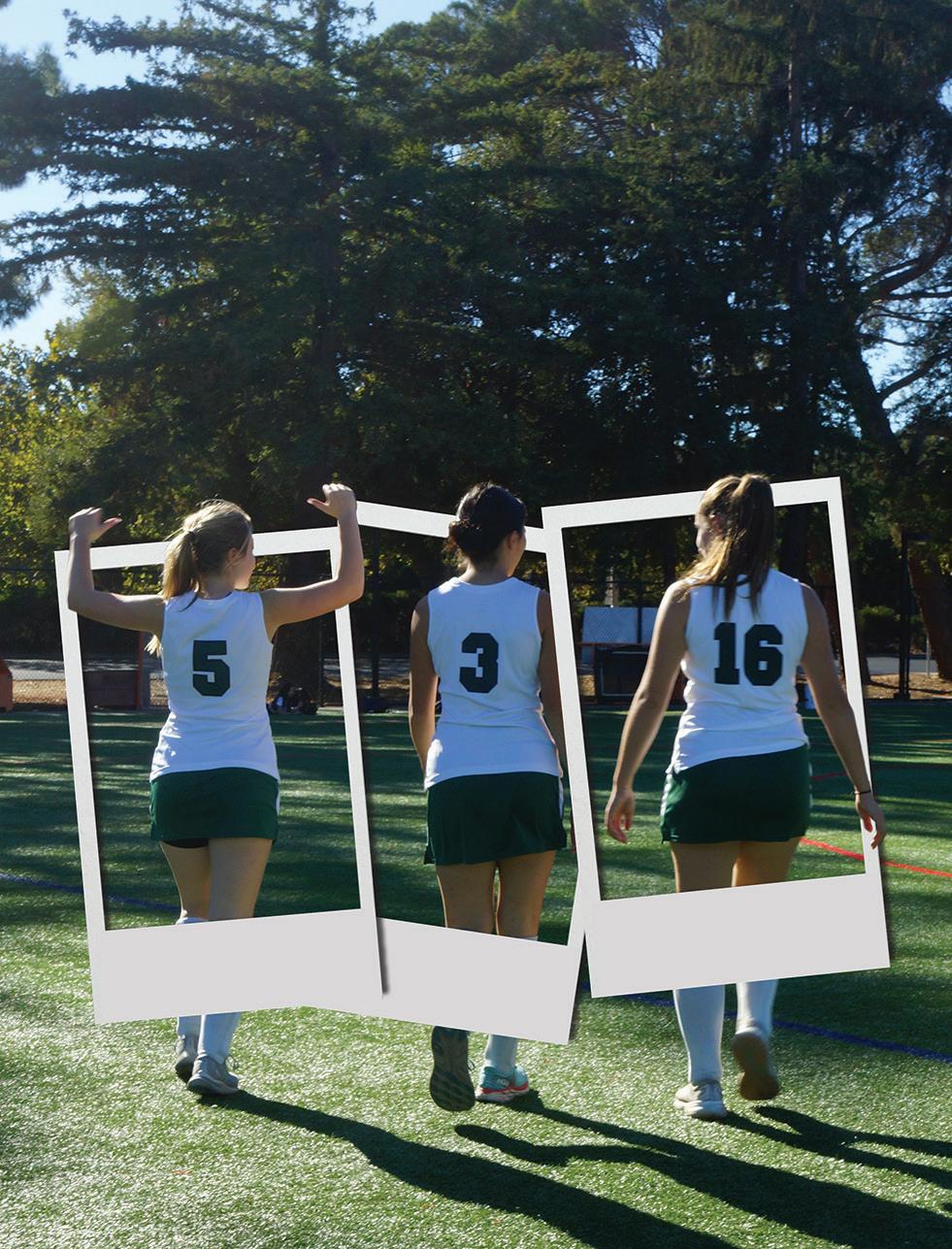
By SCARLETT FRICK, MAX MERKEL and ADI WEINER
When 14-year-old Alexa Gwyn moved to Palo Alto, she realized there was no field hockey program, so she took matters into her own hands to create one.
When eighth-grader Alexa
Gwyn moved from Sydney, Australia to Palo Alto in 2015, she had one condition: she wanted to continue playing field hockey, her childhood passion. Upon arrival, she was discouraged to learn that while she could join a club team, Paly offered no field hockey program, meaning she would eventually fall behind when her teammates started their respective high school seasons. Refusing to accept this, Gwyn decided to tackle the issue headon. With the support of her family, club coaches, USA Field Hockey, and Athletic Director Jenny Crane — a former Division I field hockey player — she established a program that would double in size in just six years.
Field hockey is one of the most popular sports on the planet, with more than two billion fans and 30 million players worldwide. However, field hockey has historically struggled to gain traction in California, due to a lack of media coverage and competition from other popular sports. Prior to 2018, a field hockey team had never touched the fields of Palo Alto High School. Today, thanks to Gwyn’s vision, Paly’s field hockey program has become a formidable presence with a thriving community.
Establishing this program was no easy task for Gwyn.
“The whole process took about two years,” Gwyn said. “I started planning in eighth grade, and began my first season sophomore year.”
In order to institute an athletic program, Gwyn was informed that she would need a substantial amount of resources, including equipment for players, a league to join, individuals willing to participate and a coach.
community of people who would help push this team forward,” Gwyn said.
Crane, a special education teacher at Paly at the time, also noticed the potential value of establishing a field hockey program.
“As a former Division I field hockey player at UC Berkeley, I recognized an opportunity to introduce the sport to the school when I joined Paly in 2014 and discovered there was no existing team,” Crane said. “Given that California has only three Division I field hockey programs — Berkeley, UC Davis and Stanford — and with Stanford located just across the street, it seemed like the perfect chance to bring this exciting sport to our high school community.”

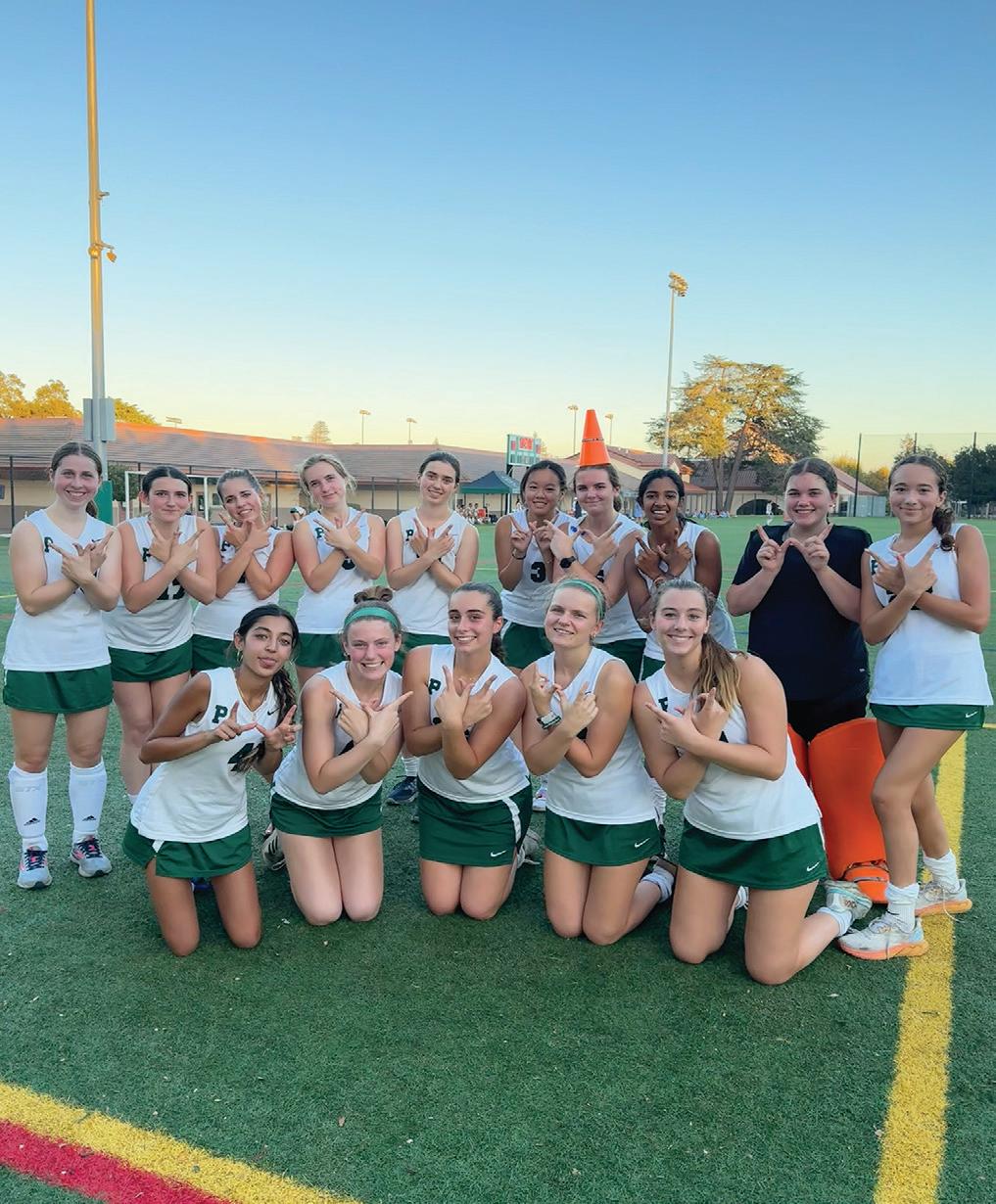

Alexa Gwyn (‘21)
“It seemed like I had some pretty large hurdles to get over, but with my family, my club, other parents at Paly, Jenny Crane and even USA Field Hockey, we found a
Once Gwyn and Crane joined forces, things began to fall into place.
“After [finding Crane] I started a petition which I spread around school my freshman year, and my mom also posted it on the Paly parent’s Facebook page,” Gwyn said. “We surprisingly found many parents who had played field hockey growing up and were very supportive of this team.”
With demonstrated interest in the program from both parents and students, Crane and Gwyn proceeded towards their next goal: acquiring equipment.
“At the time, Athletic Director Therren
Wilburn facilitated securing donations from USA Field Hockey through their grant program, which supports schools launching new field hockey programs,” Crane said. “This grant provided us with enough sticks and balls to equip our varsity team. Additionally, we ensured the acquisition of essential items like goalie equipment and goals.”
While expanding the team’s resources, the two also focused on fostering a sense of community among aspiring players, which included founding the Field Hockey Club prior to the team’s official establishment.
“[At the club] I would teach skills at lunch time and we would hit around,” Gwyn said. “Jenny was my club adviser and would come to help coach.”
Approval for the team was ultimately granted under Title IX following the addition of a men’s volleyball team at Paly. Consequently, the Palo Alto field hockey program could officially begin.
“There were many times when I wanted to give up because it seemed like everyone with the power to [create] this team didn’t know or care about field hockey like I did,” Gwyn said. “But little by little, with lots of people helping and supporting, we got it done.”
After two years of dedicated effort, the program finally became a reality. However, the team faced a significant challenge: competing against well-established and
experienced programs in the area. As the only player with prior experience, Gwyn grappled with finding her appropriate role.
“The first season was a crazy mix of emotions,” Gwyn said. “On one hand I was so excited to have this dream of mine come to fruition, and to be playing for my school. But on the other hand I had completely overlooked the challenge that would come with being one of the only experienced players on a team of 19 girls. I had to learn to empower other players instead of letting frustrations take over.”
The girls’ opening season consisted of two wins and 15 losses, placing them sixth out of seven teams in the El Camino League. Despite the record, the team maintained a positive outlook.
“One thing [Crane] did really well our first season was to take winning out of our main team goals,” Gwyn said. “Our goals became more about developing the basic skills, building chemistry as a team and having good character as teammates and people. We looked at small wins: could we connect three passes, could we make a good block tackle in the game, could we score a goal?”
With the help of Coach Crane, the girls were able to focus on the things they could control, including team chemistry
and group support.
“Sure losing was tough, but since we hadn’t expected to win, we could walk away feeling proud of ourselves,” Gwyn said. “I think that idea helped grow the program. No one wants to join a team, especially as a beginner, if you feel like your teammates won’t love you or support you if you mess up.”
These core values remain integral to the team today. Current varsity Coach Clare Doyle has continued to uphold and expand the fundamentals that Director Crane introduced.


“We have thisamazing communityof players,coaches andlifelong friendships.”
“[Today] we have cultureclose-knita of growthand support.” —CharlotteBarclay(‘26)
“[Today] we have a close-knit culture of growth and support, where players come in generally with little to no experience but a strong desire to work hard, improve and cheer on their teammates who are doing the same,” Doyle said. “It’s a testament to the roots of our program that we continue to hold beginner friendly, minimalcut tryouts with high levels of interest from incoming freshmen — and we care a lot about
now play field hockey in the off-season with local clubs and understand the game prior to trying out in the fall.”

Paly Girls Field Hockey players pose with their senior posters.

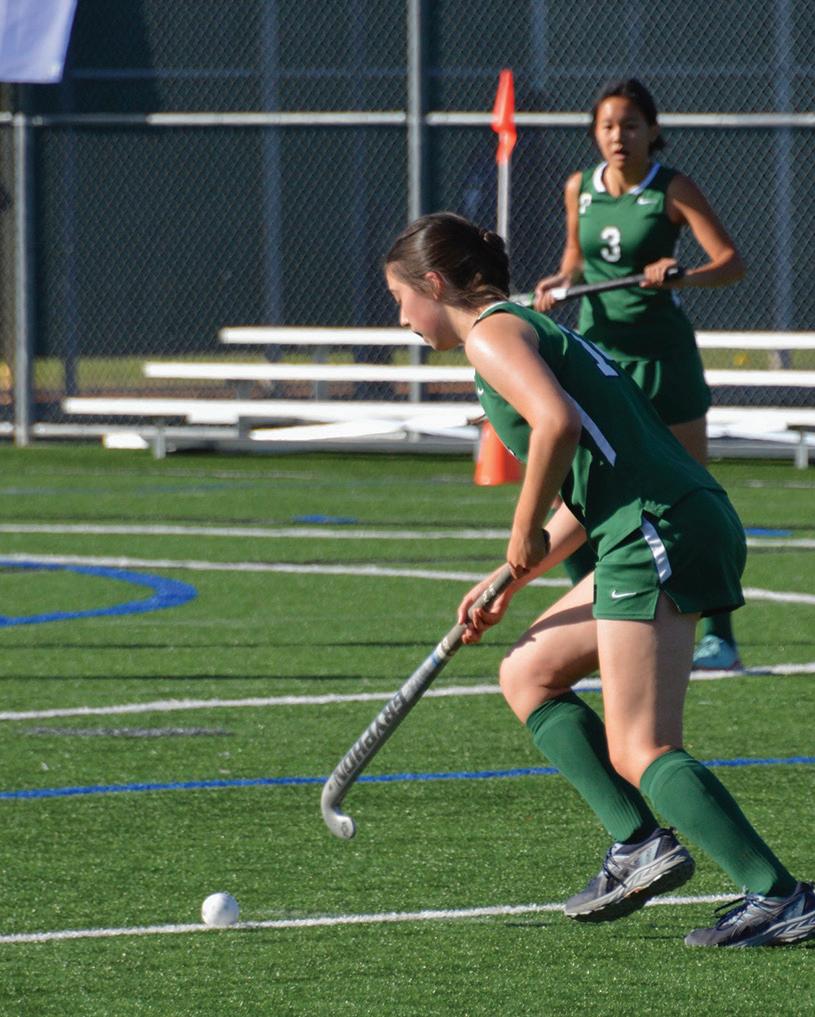
current—ClareDoyle, varsitycoach Annelise Sailer down the field.
maintaining this culture even as our team’s performance in the rankings continues to improve.”
The program has come a long way since its formation. Team size, skills and interest have all made strides since their opening season. “When the program was first launched, we started with a single Varsity team of 19 players, only one of whom had prior field hockey experience,” Crane said. “Today, the program has grown significantly, now comprising both Junior Varsity and Varsity teams with a combined roster of approximately 40 athletes. Many athletes

As the program continued to improve, Coach Doyle looked to expand the program’s goals beyond what the early team used to strive for.
“The players’ and former coaches’ hard work over past seasons has put the program in a really exciting place where we are becoming competitive with the top schools in SCVA. This season, as a coach, I wanted to put us in the best possible position to compete with any team in SCVAL: this involved not only making sure our fitness level, preseason involvement, and team equipment matched that of other competitive programs, but also working to change our program’s self-image and to instill confidence in Paly players that we have the skill and drive to compete with any school we play,” Doyle said.
In the 2024 season, the Vikings placed sixth out of eight teams, falling short of fifth place by only one point in the De Anza league. This league includes formidable opponents such as CCS champions St. Ignatius.
“In previous years, Paly has been in a loop of promotion and relegation between the two divisions: we finished with zero wins in De Anza two years ago
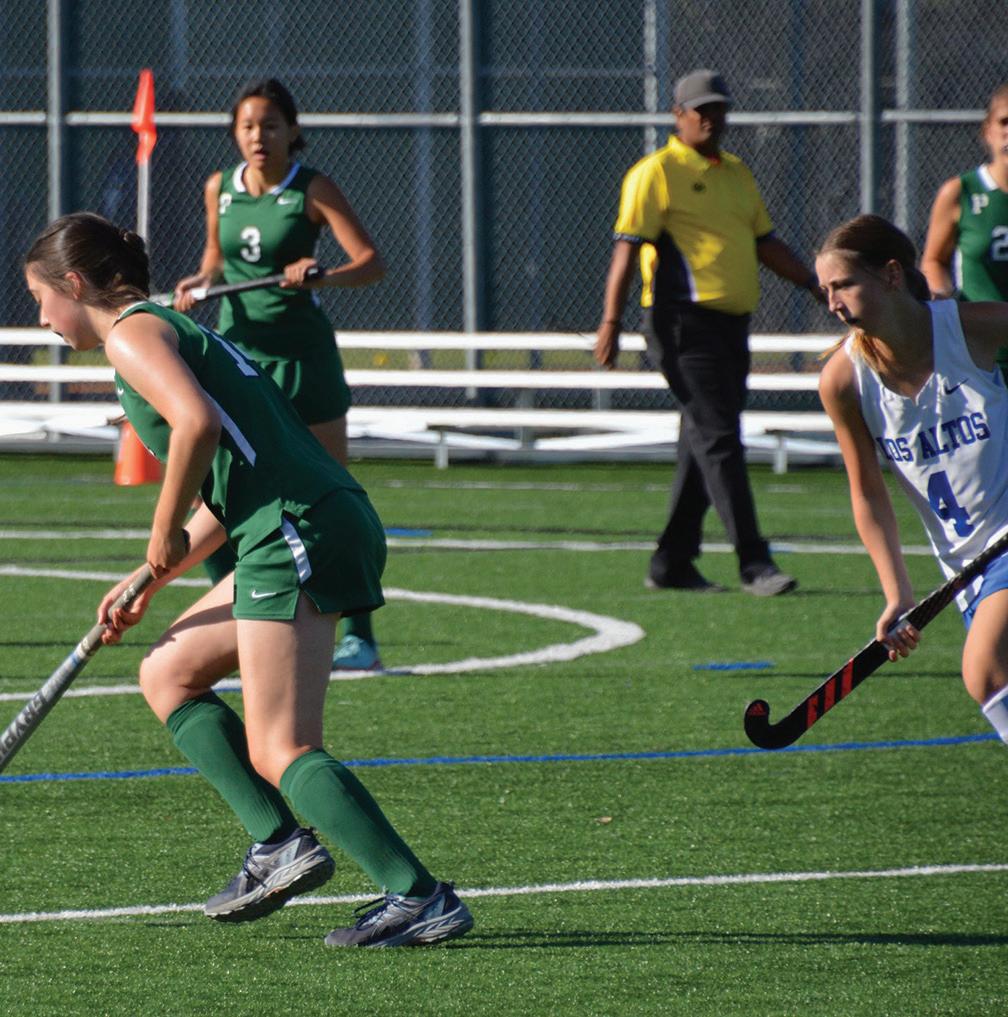
field.

able to end my senior year off so strong as the first Paly field hockey te-am to make it to the CCS playoffs was incredibly exciting,” senior and cocaptain Polina Van Hulsen said. “It made the season all that more fun and fulfilling.”
Crane credits the program’s success to its strong values. “Over the years, Paly Field Hockey has consistently advanced, establishing itself as an increasingly competitive program with each passing season,” Crane said. “I believe this success is largely due to the program’s emphasis on fostering meaningful relationships and building a strong sense of community among its athletes.”
This sense of community is shared with players and coaches alike. Junior Charlotte Barclay expressed her appreciation for the strong bonds she has formed through the program.
“My favorite thing about the sport honestly has nothing to do with the sport itself, but with the amazing community of players and coaches that we have and the lifelong friendships I’ve formed with some of my teammates,” Barclay said.
Van Hulsen reaffirmed this idea, emphasizing the team’s supportive ways.
“We have an incredibly welcoming environment that fosters growth, hard work, and friendship which has truly made me enjoy field hockey,” Van Hulsen said.
Next season, Gwyn plans to return to the program she helped establish, taking on a
new role as a coach for the team after her graduation. Reflecting on the program’s journey, she expressed her excitement to contribute further and hopefully continue on the path of success.
“Jenny and I both watched [the program] grow from barely one varsity team into this full fledged program with JV and varsity teams which is incredible,” Gwyn said. “To come back is an opportunity to give back to the program that gave me so much when I was in high school.”
Gwyn credits much of her personal and leadership growth during high school to the guidance of Crane.
“Jenny [Director Crane] really taught me a lot about being a leader during my time on the Paly Field Hockey team. I had a lot of growing to do. She has been one of my most influential coaches, and to come back to coach with [Director Crane] as the athletic director makes me feel so proud,” Gwyn said.
As a program born out of determination and fueled by a passion for the sport, Paly
“I just have so much love for this sport and this program.”
Field Hockey has proven itself to be a powerful force amongst other teams, as well as a rewarding experience for coaches and players within the community.
“I just have so much love for this sport and this program. Watching it grow has been one of the biggest joys for me,” Gwyn said.
The program has attracted new players every year with their increasing success and their strong sense of community, support, relationships, and a willingness to grow.
“It is incredibly rewarding getting to introduce [new players] to the game and watching them grow in skill and confidence — I have been amazed how fast beginner players pick up the sport over the course of a single season,” Doyle said. “I am excited for what future

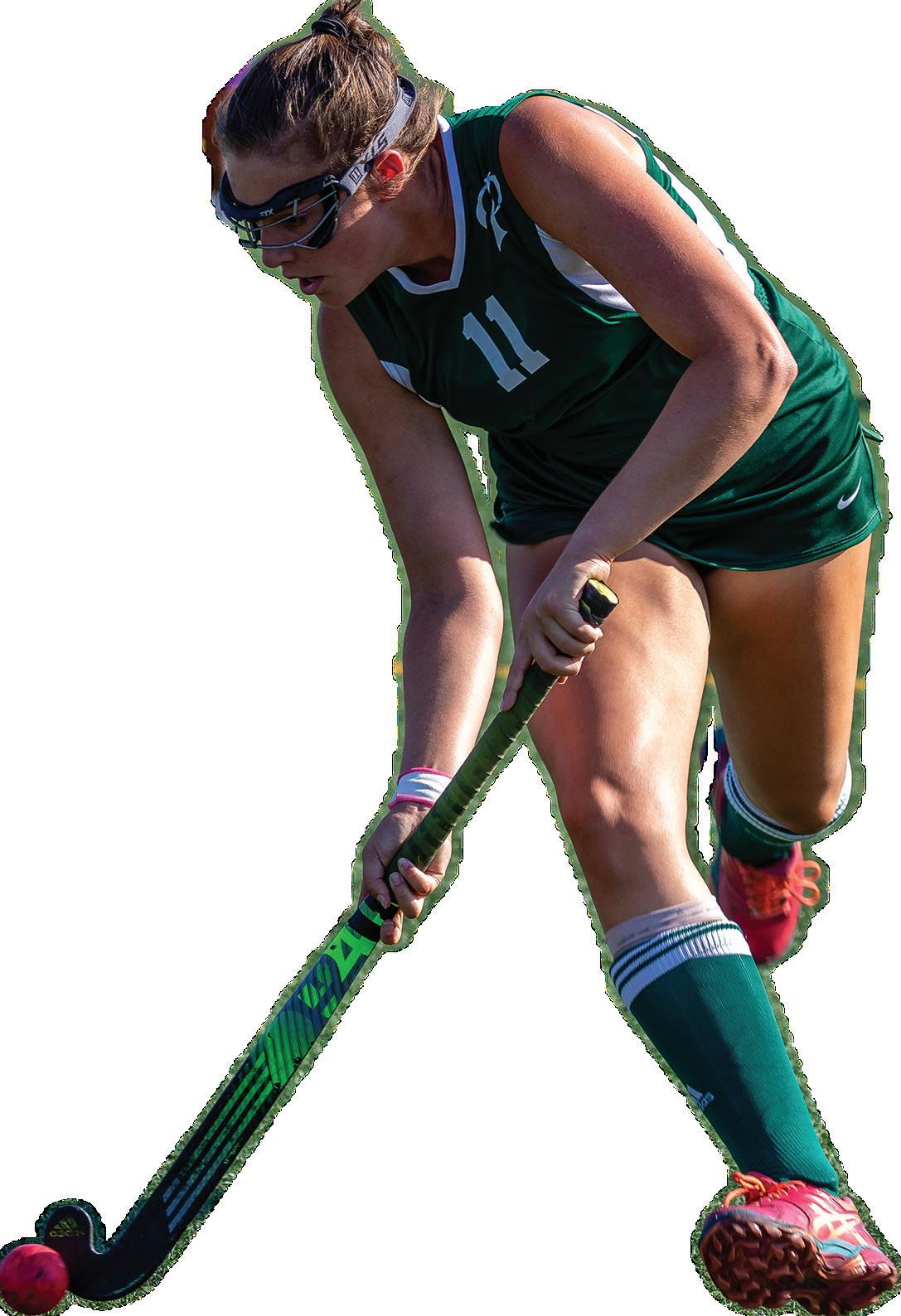
Seniornightpostersareahugepartofcommemoratinganathlete’s dedicationtotheirsport.Buthowhasthistradition evolved
Under the bright stadium lights, cheering fans filling the air, high school seniors step onto the field one last time. But beyond the scores and spotlight, the handcrafted posters with vibrant memories and messages capture the heart of their high school journey, turning a simple sporting event into an emotional farewell. What about these colorful creations make them a cherished part of the high school experience?
For many Paly athletes, senior night is a significant milestone that commemorates their last home game on their Paly sports team. Oftentimes, seniors get posters to celebrate this important occasion. These posters help recognize the athlete’s contributions and dedication to the sport through a ceremony where fans, teammates and coaches acknowledge them during their final home game of the season. When honored, a teammate, friend or family member will hand them a homemade poster in memory of their high school career.
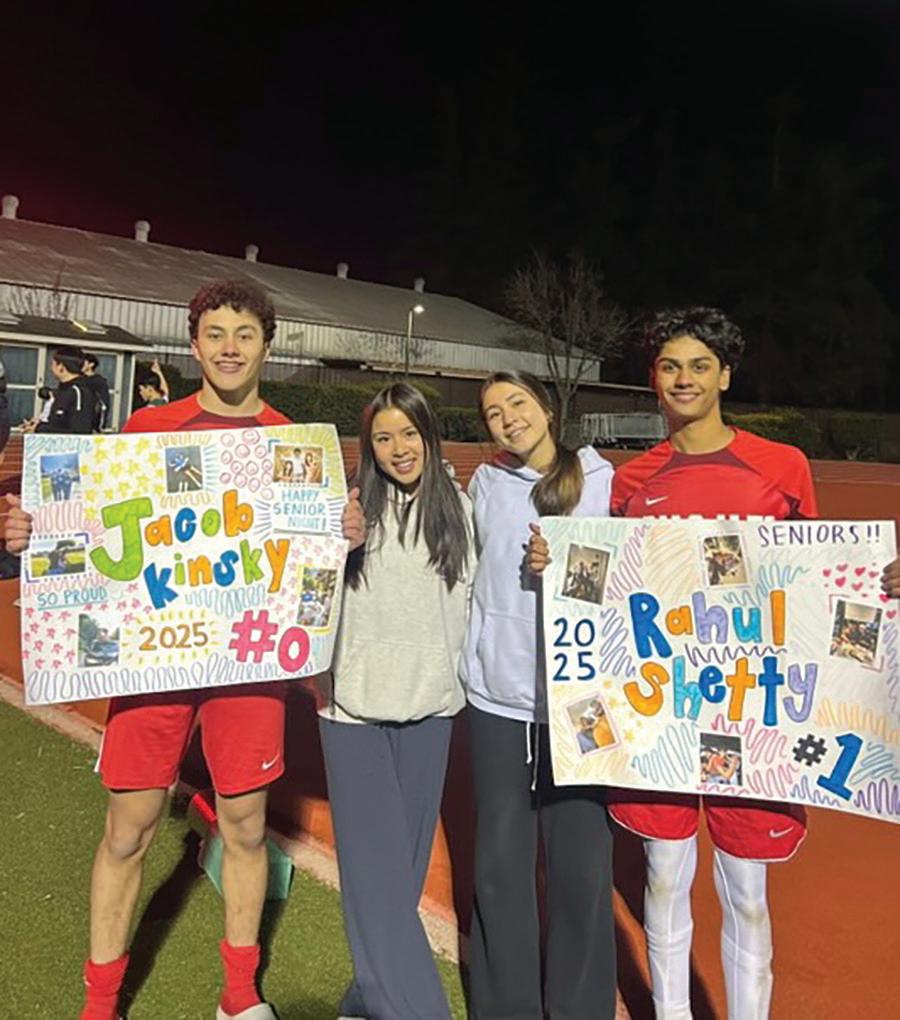
Allegedly originated in the mid-20th century, senior nights have been a long-standing tradition for high schools and colleges. However, senior night posters arrived later, with the first documented senior night posters at Paly in 2014.
As the tradition of senior nights continues to grow, many schools are incorporating a digital aspect to improve the celebration. These digital displays and videos are becoming a popular addition in the commemoration of the athlete and their final game.
Digital displays such as dynamic presentations can include high lights of the ath lete’s career, mes sages from coaches and teammates and even clips of memorable games. This refine ment not only integrates a modern twist to the ceremony but also provides a last ing digital keepsake for the athletes.
By JULIET FRICK and NATHAN LEE
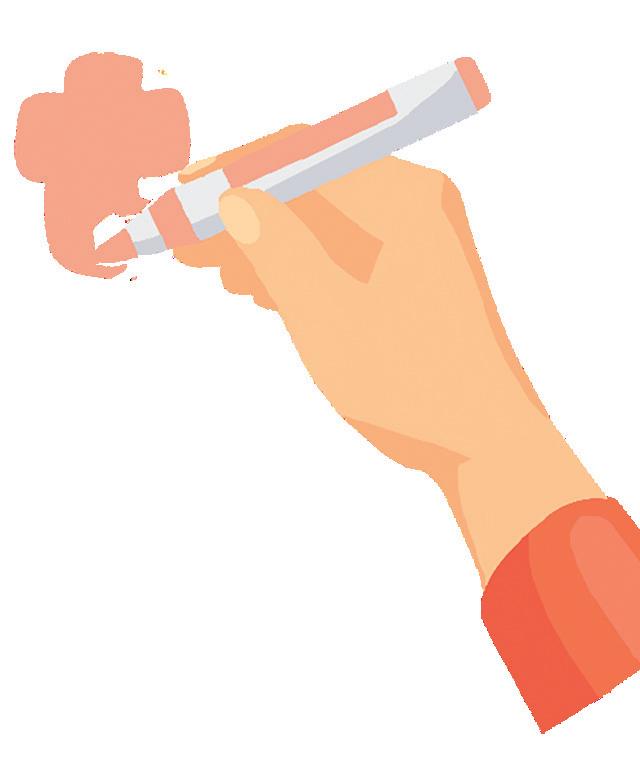
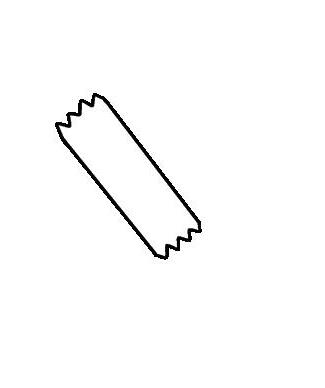


mates they really know you as a player, from your friends, they took time out of their day to make the poster and come to your game and they know you in a different way,” Green
“It was great getting poster from someone who’s a constant figure in my workouts and meets throughout my highschool athletics career.”
—
Kinga Czajkowskya (‘25)
Senior night posters can’t just be bought, oftentimes, they are created by family and friends of the athlete, who individualize the poster in priceless ways. However, in some sports, the teammates of the athlete are the ones who show their support and gratitude by making the poster.
Senior night posters are more than just signs with photos and nice words. These posters hold years of memories and connections athletes have with their teammates and the sport. The result of countless wins and losses, team dinners and daily practices, senior night posters are emotionally invaluable and often mean more than they look.
Senior volleyball player Naama Green can attest to the meaningfulness of a senior night poster. Green was given a poster by her friends at the end of the fall season.
In the case of senior Kinga Czajkowskya, her teammate in cross country, junior Amaya Bhadawaj, pushed her to improve, further strengthening their bond. Competing hard and always placing together, the two of them were called “one of Californias best duos” by Milesplit.
“We’ve actually been interviewed together a lot over the last season because we would finish together during a lot of top meets,” Czajkowska said. “It was great getting a poster from someone who’s been a constant figure in my workouts and meets throughout my highschool athletics career — especially because she really pushed me to be a better athlete.”

These senior night posters have different meanings when they are given by different people, which can often change the sentimental val- ue and significance of the poster. Senior and softball player Riannah Soliman made a poster for her teammate and friend Anabelen Yanez (‘24) last year. According to Soliman, making the poster was time consuming but ultimately rewarding in the end.
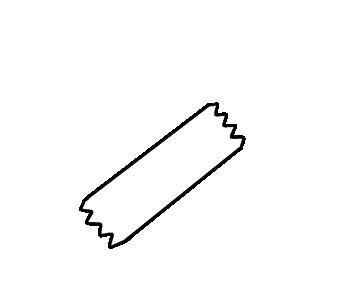
“They’re very worth the time spent, especially seeing their reaction and how happy the small gesture makes someone feel.”
think they’re very worth the time spent, especially seeing their reaction and how happy the small gesture makes someone feel,” Lee said. “I used a white poster, markers, glitter, and printed-out pictures. Most of the material was either from Michaels or I had the material at home already from making past prom posters.”
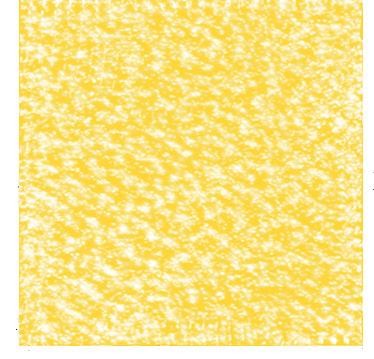
— Emma Lee (‘25)
“It took me around two-and-a-half hours to make, [but] it was so worth it because Anabelen really liked it,” Soliman said.
Senior Emma Lee is well versed in making senior night posters. After preparing three posters, she has streamlined the process, compiling many different materials to make the poster.
“[The posters] take about an hour. I

In an effort to come up with creative ideas for the posters, Lee spends time browsing through many different websites.
By exploring different sources of inspiration, Lee hopes to find the perfect addition that will resonate on a deeper level.
“I came up with inspiration from Pinterest and pictures of other senior night posters I’ve seen on Instagram,” Lee said. “The posters were personal — I put the name of my friend or a phrase using
their name, funny pictures of us together, something that represented their sport, and their jersey number.”
Ultimately, in the case of these senior athletes, whether the kind of senior night poster is digital or physical, the commemoration of a senior athlete’s last moment in their sport is an unforgettable experience. The posters have flourished since their introduction in 2014, and have not only served as a reminder of the dedication, teamwork, and memories these athletes have created throughout their Paly experience, but they are a celebration of everything these players have given and gained along the way.
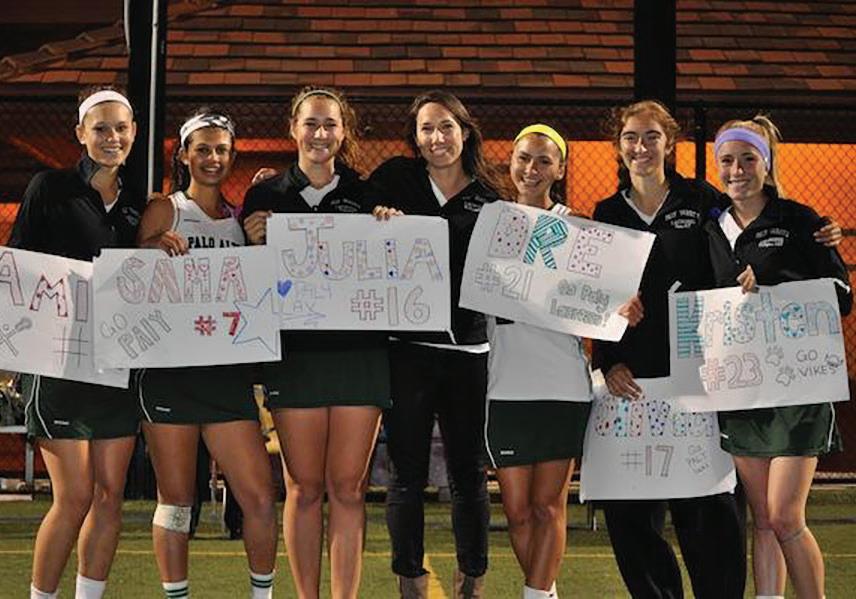
- Player names and numbers - Simple drawings - Smaller poster
- Made with marker & paper - Designs in letters - Encouraging sayings
- Large picture of player - Graduation year - Player’s names and number - Flowers - Stickers

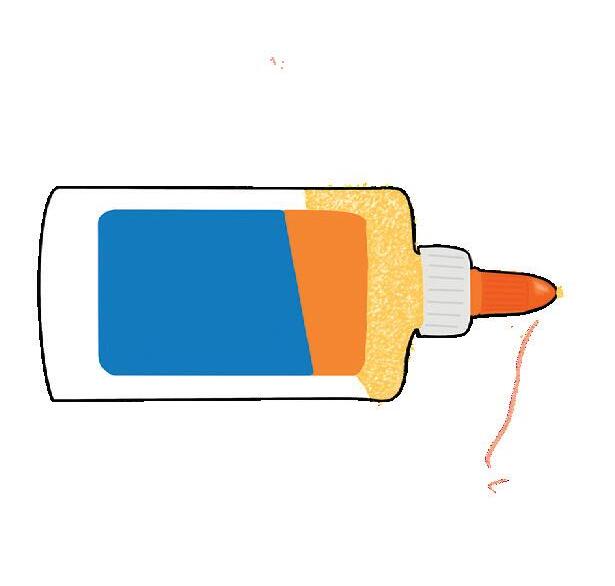


- Player name and number
- Simple drawings
- Larger
- Made with posterboard, glue, glitter, and stickers
- Graduation year
- Baby pictures
The lives of student-athletes often revolve around their sports, with school playing a significant role. Today, they have various educational options, including online, remote, and flexible individual programs, allowing them to balance academics with athletic commitments.

By Luke Joachim, Isaac Telyaz, and Lucas Tung
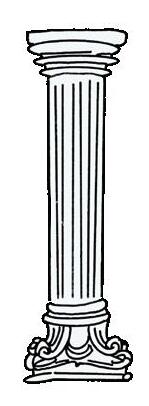
For most athletes, the youth sports journey involves following a conventional route. While students in elementary school are beginning their educational journey and learning fundamental skills that will serve them for a lifetime, athletes are simultaneously learning the basics of their sport — building the foundation for their future athletic careers. By the time athletes get to high school, balancing academics and athletics becomes a top priority.


The traditional student-athlete pathway includes going to a local high school in person, from morning -to-afternoon, and balancing school life with their sport. However, for the exceptional few aiming to excel at the highest levels of their sport, the traditional high school pathway can be limiting. To unlock their full potential, many of these athletes search for alternative routes, such as an online education or private schools that cater to their schedules. These unique pathways are not just reshaping the world of youth athletics, but also redefining what it means to pursue excellence in both sports and education.

at Paly for a limited amount of hours per week.”
Sims is a player on the Paly baseball team, but it has not always been this way. Before Paly, he went to Serra High School, a private academy known for its outstanding athletic program. Serra provides athletes with more lenient policies, particularly on game days. Sims compares the academic and athletic differences between Paly and Serra.
“Athletes at Serra are excused from attending school on game days, additionally, they can turn in their homework delayed due to games,” Sims said. “In my experience, the schoolwork was much easier at Serra than at Paly, I had less homework and generally less to do after school, but at Paly, I have to be more strict on my time management.”
For student-athletes, performance at practices can take a hit after rigorous school work.
“It is much more difficult to go to practice after finishing two hours of homework,” Sims said.
inclusive and I face less athletic pressure.”
Last year, PAUSD introduced a new pathway for students searching for a more flexible schedule for academics. Middle College has allowed PAUSD students to choose their school hours to cater to their ideal schedule. Athletes, in particular, have found the promises of Middle College to be very intriguing. Junior tennis player Oscar Barillas Otsby is among the athletes to attend Middle College.



“With Middle College, you are only required to take three hours of high school classes in person,” Barillas Otsby said. “So, my schedule is a lot more flexible.”

Otsby’s ideal schedule is one that clears out his mornings, enabling him to practice before attending school.

One student-athlete who took the conventional route regarding athletics in high school is senior Henry Harding, a pitcher for the Palo Alto Vikings baseball team. Harding emphasizes the difficulty of managing his time between sports and classes at Paly, particularly during his freshman and sophomore years.

“Balancing academics, school athletics, and club athletics in high school has been extremely challenging,” Harding said. “During my early years, my schedule was packed with seven classes, Paly baseball and hockey, as well as club baseball and hockey. It often felt like there wasn’t enough time in the day to fully prepare for tests or complete homework, which caused my GPA to take a hit, despite my efforts.”
That being said, Sims remembers that going to a private school has its drawbacks that swayed him towards Paly. Like many other athletes at private schools, Sims had to take a longer commute to get to class than if he went to his local public school.
“While attending Serra, I had to take about a half-hour drive daily to school,” Sims said. “This was a major setback for my parents because they had to drive two hours daily to drop me off and pick me up from school, and now that I am at Paly, it is significantly easier to get to school because I live very close.”
“On two days of the week, I have Middle College classes starting at 10 a.m,” Otsby said. “Even more conveniently, these are



However, Harding took some of the weight off his shoulders later on in his high school career.
“By my junior and senior years, I had a lighter course load and fewer sports to manage, which allowed me to focus more on academics and improve my grades,” Harding said.
Most conventional high schools have long hours of homework every week. This schedule restricts the time they have to practice during the day.

Being the athletically successful school it is, Serra naturally has a competitive nature that put Sims under pressure during his time as an athlete there.

“Athletes who go to school online get more training time and there are minimal regulations on practice hours,” Paly junior Jackson Sims said. “We can only practice
“The pressure of playing a sport at such an athletic school made it harder to tackle expectations,” Sims said. “At Paly, my teammates and peers are more
“When I build my schedule, I get to tailor it in a nonconflicting way that gives me time to focus on everything, strengthening my performance in both school and soccer.”
- Miko Oppenheim (‘25)






in the morning or even sleep in before a tournament to get rest. This schedule gives me much more flexibility and choice.”
Junior Kiane Saad, on the other hand, finds that attending Middle College has its complications.
Saad used to be a student and cheerleader at Menlo-Atherton High School. Although she still cheers for Menlo-Atherton, Saad now attends Cañada Middle College, balancing her sport with school.

mute from Cañada Middle College to Menlo-Atherton,” Saad said. “In addition, on game days that aren’t scheduled for evenings, I have to miss some of my classes to get to Menlo-Atherton and be punctual for our meeting time.”
Saad followed in her sister’s footsteps by enrolling in Middle College. Through her sister’s initiative, she was introduced to the program’s generally unsung advantages.

“I believe the academy has a new honest training schedule where I feel that I am improving every day. If I was at a traditional school, I would not be able to spend as much time training.”
“Through [my sister’s] experience, I learned the academic benefits of Middle College,” Saad said. “I was drawn to the independence of the program, and I thoroughly enjoyed the idea of having late starts and a more flexible schedule, including online classes and periodic classes that are not every day.”
-Roman Woolfolk (‘28)
In addition to independence, Saad appreciates the differences in classes at Middle College, which offer her a new perspective on learning.
“I decided to do the Middle College program because I realized that I could pick my schedule for classes that only lasted a semester-long, while garnering college credit and boosting my GPA,” Saad said. “I also get to participate in niche classes that wouldn’t have been regularly offered in high school, such as Radio Broadcasting and Podcast Creation.”
Just as Middle College provides students with unique academic opportunities tailored to their interests, specialized sports academies offer athletes the training environments they need to reach the highest levels of competition.
Many top athletes strive for the top train at specialized academies that can maximize their ability and provide the best competition. The best of the best are scattered around the country, forcing these athletes to travel long distances to join their practices. To best support these traveling athletes, most of these top acade-
mies, such as the IMG Academy in Florida and the SPIRE Academy in Ohio, host private boarding schools on-site to house their athletes yearround.
Roman Woolfolk, a soccer player who was set to start as a freshman at Paly, had his life take a dramatic turn. After receiving an offer to join the New En gland Revolution, he embraced the op portunity to compete, train and contin ue his education with the team, marking a pivotal moment in his journey.
“This academy is a better path to go pro, but it also gives you a better sup port system,” Woolfolk said. “If I went to a normal high school, training and matches would interfere with my schedule, [but] at the academy, the schedule is 100% based around my training schedule, which makes it easier for me to improve and manage school.”
Not only does the academy route allow more time for stu dent-athletes to train, but it also provides them with personalized paths for learning.

“I believe the academy has a new honest training schedule where I feel that I am improving every day,” Wool folk said. “If I was at a traditional school, I would not be able to spend as much time training.”
With high athletic expectations exist ing at this specialized academy, players are given more flexible policies regard ing schoolwork.
“If there is a game far away, such as in Texas or Orlando, and we can not turn in an assignment, we are given tutors or extended due dates because every body is on the same page. Such proce dure helps me balance school and soccer,” Woolfolk said.
Having personalized tutoring has helped Woolfolk with his grades a lot, ensuring that he stays on track academically while pursu ing his athletic goals. The flexibil ity in scheduling allows him to fo cus on his soccer commitments without falling behind in the classroom.
“The teachers understand what we expe-
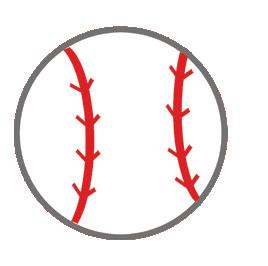





rience as student-athletes,” Woolfolk said. “They make sure we are supported, whether it’s extra help on assignments or adjusting deadlines when we travel for tournaments.”
Although life at the academy is helping Woolfolk greatly improve his game and academics, he believes his social life has taken a toll.
“I have always loved school events, and now I feel that I am missing a big part of that,” Woolfolk said. “Going into this academy, we do not get proms, homecomings or school events. In the athletic process, I miss out on lots of the high school experience.”
When comparing the most significant difference between traditional high school and his academy, Woolfolk addressed the difference in community.

“I miss the atmosphere of the traditional school environment,” Woolfolk said. “Many people don’t like school but enjoy it for its social aspect. At the academy, the mood feels muted compared to when I visit Paly.”
On the other hand, junior Miko Oppenheim attends Laurel Springs Online School while playing club soccer for Breakers FC. Prior to this school year. Oppenheim attended Gunn High School, a top-ranked public school
demanding high school and competitive soccer team were not easily compatible. Sometimes, Oppenheim would even find himself conflicted between test days and tournaments, forced to skip one for the other.
“This [Online School] is beneficial because it lets me prioritize my sport without sacrificing my grades or the classes I take,” Oppenheim said. “When I build my schedule, I get to tailor it in a non-conflicting way that gives me time to focus on everything, strengthening my performance in both school and soccer.”
“This schedule gives me much more flexibility and choice... morning or even sleep in beofre
-Oscar Barillas Otsby (‘26)
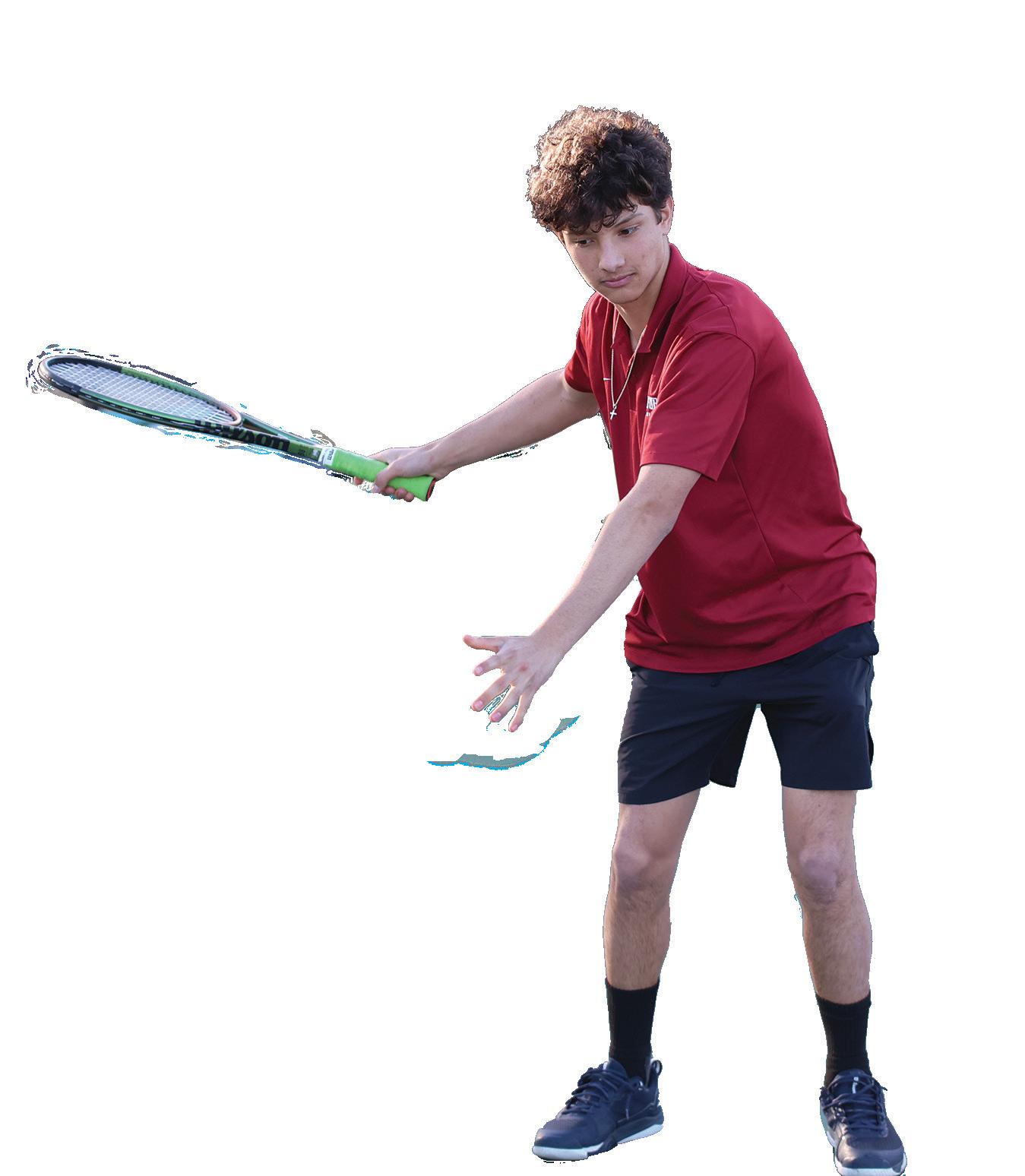
This new path has allowed Oppenheim to excel further in both fields, through added freedom.
“With more flexibility, I can work out more and travel for tournaments without missing school,” Oppenheim said. “Generally, I plan my day around soccer, because those hours are out of my control. My schoolwork and tests can be completed as I please, so I study whenever I am not working out. Since I gained more power over my routine, my grades have enhanced and I have been improving drastically in my sport.”
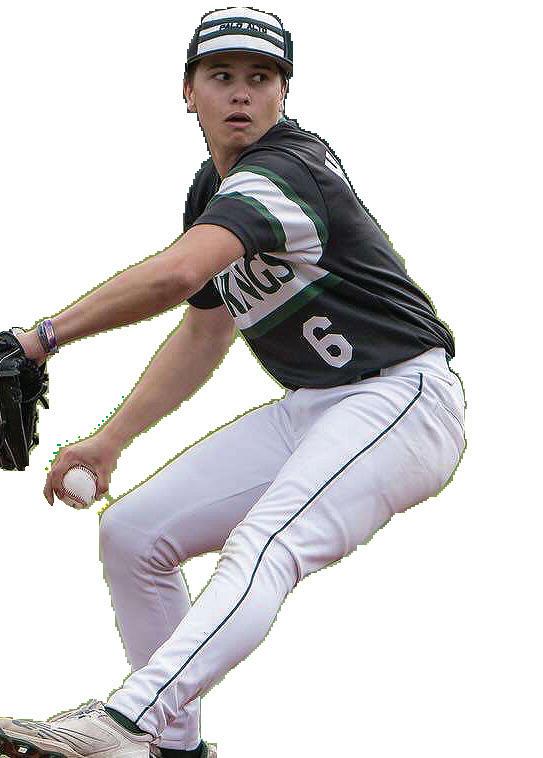
However, the online education pathway

“It often felt like there wasn’t enough time in the day to fully prepare for tests or complete homework.”
- Henry Harding (‘25)

is not exactly perfect. Oppenheim believes he missed out on social outlets that come with being a student at a traditional high school, such as spirit rallies and sports games. With online school alienating him at times, Oppenheim’s social life has taken a hit as a trade-off to advance in academics and soccer.

“I spend my free time hanging out with friends who also attend various online schools,” Oppenheim said. “These are friends I already knew when I was at Gunn, and we have grown closer since joining online school and slightly drifting from our previous peers.”



As student-athletes navigate the delicate balance between academics and athletics, alternative education pathways have emerged as vital tools to support their ambitions. Whether through specialized sports academies, online schooling or flexible programs like Middle College, these options provide the necessary structure for athletes to pursue excellence in both fields. While each path comes with trade-offs — such as missing traditional high school experiences or facing social isolation — these athletes make sacrifices in pursuit of their long-term goals. Ultimately, their journeys highlight the evolving landscape of youth sports and education, proving that success is not confined to a single, conventional route but can be achieved through a variety of tailored approaches.

by GREGORY GOODY and JONATHAN YUAN
Many athletes at Paly use or wear a lucky item during competitions. How can they affect an athlete’s performance?
As sophomore Richard Zhang walks out to the lacrosse field, he anticipates his second season on varsity. Zhang looks to physically and mentally better himself to prepare for his sophomore campaign this spring. The program is relying on Zhang this season as many key players graduated after his freshman year, and he doesn’t want to let them down. To prepare for the season, Zhang has made one key purchase, his brand new custom lucky gloves.
Lucky items have a prominent presence in athletics spanning every level of competition, from little league games to the professional level. Nevertheless, most athletes have something they use when they need to perform well, whether to help them focus or purely for luck. It is similar to how students will use a specific pen or have a specific trinket on them for an important test. These items can be anything, whether sports-related or not. Some examples are mouthguards, wristbands or just something as simple as a necklace or shirt. For some, these items that they hold on

“I needed something to keep my head in the game.”
— Richard zhang (‘27)
to have become something to symbolize hope and perseverance. A great example of this is famous women’s tennis player Serena Williams. She always uses the same pair of socks for every match and “to Serena, it has become a symbol of routine and perseverance,” (Wilson 2013). Another example is Minnesota Timberwolves superstar Anthony Edwards, after dropping a career-high 53 points. Edwards met with a six-year-old fan, Luca, who has leukemia. Edwards signed the boys jersey and poster while also having a conversation with Luca and his family. At the end of the interaction, Luca handed Edwards an orange bracelet that wrote “Love Like Luca.” Edwards vowed to wear this bracelet for the rest of his career, in honor of Luca and his battle with leukemia. In the very next game, Edwards followed up his career high performance with another astonishing one, tallying 37 points, seven rebounds, and eight assists in a win over the Clippers. Edwards has continued his dominance and is looking forward to joining the
2025
West All Stars this February, and it’s safe to say Lu ca’s gift to him had a positive impact on his game.
An example of someone at Paly who relies on an item is sophomore and lacrosse player Richard Zhang, who wears his lucky gloves for every lacrosse game. The gloves are special to him, as they have a custom smiley face design on the cuff of the glove.
“I needed something to keep my head in the game,” Zhang said. “It helps me forget about my mistakes quickly, and helps remind me to hype up my team.”
For Zhang, in order to succeed, you need to keep your head in the game at all times.
“Our coach always mentions that lacrosse is considered the fastest sport on two feet,” Zhang said. As a Freshman on varsity, Zhang found the back of the net 17 times, while also assisting other goals 10 times, playing a key role in the program’s two CCS playoff wins against Carmel and Live Oak. Zhang led all freshmen in goals in the Peninsula Bay League last year, and is current-
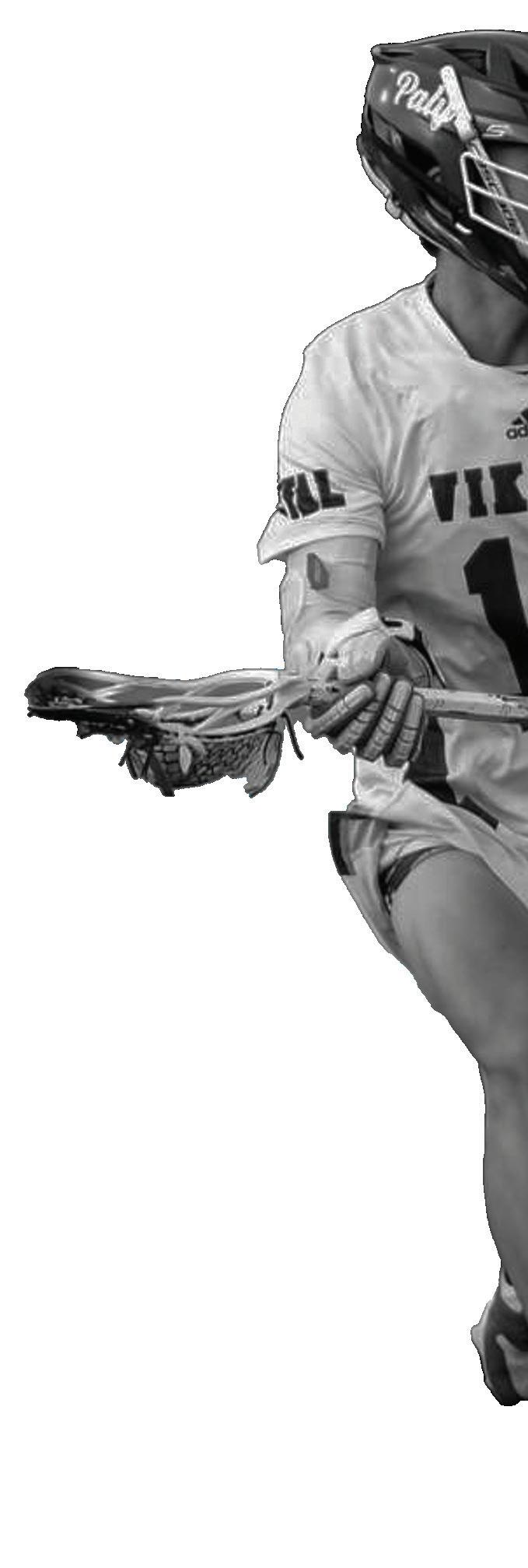
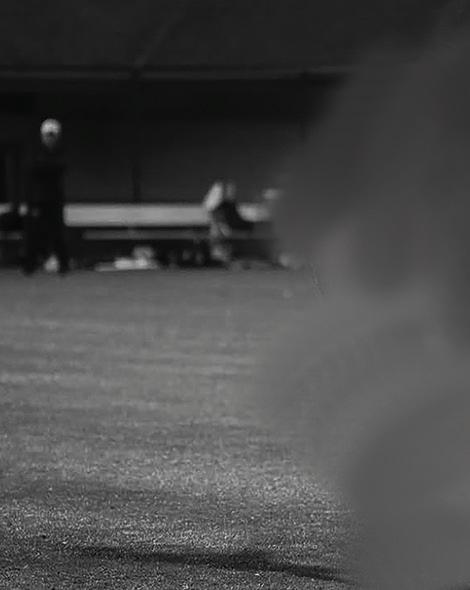
ly striving to have a larger role in the offense for his sophomore campaign.
Zhang’s biggest goal for this upcoming season is to beat Menlo Atherton as well as Los Gatos, as they are two of Paly’s biggest rivals who beat the boys lacrosse team last year.
Another example is freshman Kaleb Osotonu, who wears a special back plate dedicated to his friend and teammate for every football game and practice. A backplate is an extra pad some football players wear that hangs off the back of their shoulder pads, and can often have flags or inspirational quotes written on it. “I wanted to honor my friend, who was on the football team at the start of the season,

but had to leave for personal reasons,” Osotonu said. “The backplate had number 23 on it to honor him since he wore number 23 at the start of the season.”
As a freshman on junior varsity, Osotonu racked up 62 total tackles, seven of them being for loss, along with 303 rushing yards and seven total touchdowns, all while repping his lucky backplate. Osotonu is looking to make varsity as a sophomore and improve from his successful freshman campaign.
Another example of an athlete who utilizes a lucky item is senior and varsity swimmer Nicolas Ogawa. At meets where he is expected to perform, he likes to wear his racing-specific goggles.
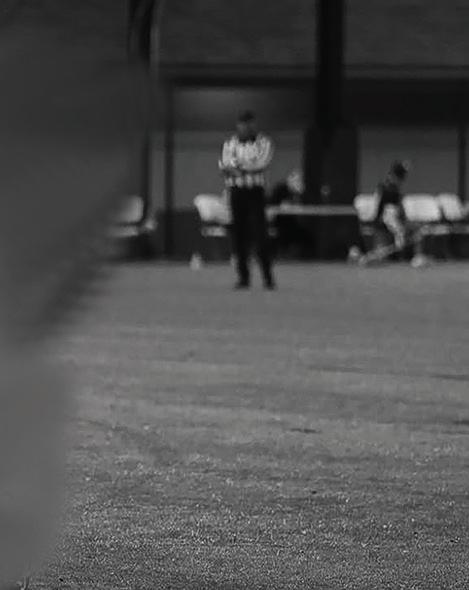
in his confidence levels. His racing goggles have become both a lucky charm and a symbol of confidence.
“When I’m racing without my better goggles, I subconsciously feel less confident with myself,” Ogawa said. “On average, I can cut between half a second and a full second from my best event, the 100-yard back, with my racing goggles.”
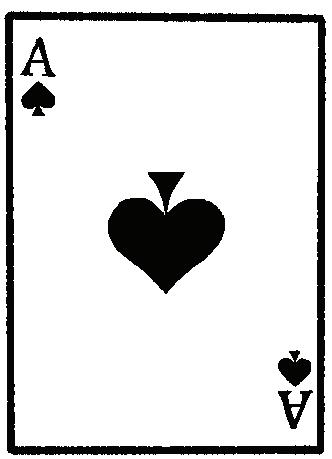
“WHENEVER I’M NOT WEARING my racing gogGles, I FEEL LIKE I’M NOT READY TO GO FAST.” — NICO OGAWA (‘25)
“I think of it as a good luck charm that helps me do well in races,” Ogawa said. “Whenever I’m not wearing it, I feel like I’m not ready to go fast.”
Unlike his practice goggles, which tend to create drag and resistance in the water, his racing goggles ensure that he feels sleek and comfortable during a race.
“I chose it specifically for how it looks and how it feels when I am racing,” Ogawa said.
At less important meets, Ogawa sometimes uses his practice goggles and immediately feels a difference
With Ogawa, it is clear that his racing goggles have an impact on his performance and show the impact that a charm like his can have on an athlete’s performance. From back plates to goggles, there are many examples of people using or wearing a trinket in Paly athletes and, whether it helps or not, people have them either for their sentimental value, personal significance or as a simple source of superstition. Whatever the reason may be, we can see that trinkets can give a mental boost to the athlete from the examples we see at Paly. After constant use, a lucky charm can become a symbol of routine and perseverance. Ultimately, whether they truly bring luck or not, these items reflect the hard work and dedication that an athlete puts into a sport, the aspects that define the heart of competition.
PhotocourtesyofIanJohnston
PhotoillustrationbyArjunBharat


Every winter, Paly students find an escape from their stressful schedules on the slopes. But with the risk of injury, safety on the mountain requires just as much awareness as skill
he sun glints off the fresh powder as junior Maeva Herbert-Paz carves her way down the slope, the sharp wind biting her cheeks. But one wrong move — a patch of unstable snow — and she could find herself tumbling into a season-long injury. There’s nothing quite like the feeling of skiing. Each turn is a mix of exhilaration and anticipation — an experience that brings millions flocking to the mountains every year.
For Paly students, weekend trips to Lake Tahoe, Park City and other destinations offer an

escape from the stress of high school. However, skiing offers a paradoxical blend of freedom and fragility: one moment you’re gliding weightlessly across fresh snow; the next, you’re bracing against an unexpected mogul that sends you sprawling. This element of unpredictability in conditions makes skiing and snowboarding inherently dangerous activities, and injuries remain a common part of the sport.
“All athletes can absolutely enjoy skiing while staying safe, but it requires being mindful of precautions,” Don Habibi, seasoned ski instructor at Northstar Resort, said. Aside from the traditional skiing attire, athletes also wear protective gear to shield themselves from casualties, including wrist guards, helmets, chest and back plates and various padding.
Junior Ian Johnston is an avid skier as well as a baseball player. Johnston wears protective gear to not only keep him safe on the mountain, but also to keep himself in the best condition for the upcoming baseball season.
“I wear a helmet to protect my-


self from head injuries, and I also wear a back brace to protect my back, which I started to wear around three years ago,” Johnston said. “I have never been injured skiing, which is in-part due to the protection I wear.”
Mountain activities can be extremely risky thanks to the challenging terrain mixed with unpredictable weather conditions. Whether it’s the icy patches hidden in a mogul field, sudden drops on unpaved runs or hazardous obstacles combined with poor visibility, the mountain can be both beautiful and dangerous.
You never know where a rock or a tree could be, they can just throw you off and seriously injure you. “ — Ian Johnston (‘26)
“Whenever I’m going down complicated terrain I always have to be really careful,” Johnston said. “You never know where a rock or a tree could be, they can just throw you off and seriously injure you.”
Ski resorts like Palisades, Heavenly and Vail are extremely popular for skiers and snowboarders with a wide range of skills, meaning that advanced rid ers are cruising down the same runs as first-timers. As a result, specific terrain may require extra precautions for the most safe and enjoyable experience.
According to Mass General Brigham, knee injuries make up around half of all ski injuries, predominantly with ACL tears, MCL tears and meniscus injuries. Maeva Herbert-Paz is a year-round water polo player, who also enjoys spending her free time on the mountain, snowboarding.
Herbert-Paz has been subject to multi ple injuries during her snowboard ing career, including an MCL sprain and an elbow fracture. Both of these injuries took her out of practice circulation for many months, caus ing issues for both her team and coaching staff.
“Recovery obviously var ies from injury to injury,” Herbert-Paz said. “For my elbow injury, it was three months before I could play water polo again, and my knee injury was reoccur ring for two seasons of play. I had to spend a lot of time in physical therapy to fix it.”
Even though injuries can stem from a main sport such as water polo, ski injuries can be even more dangerous than other injuries because of the high impact forces involved in falling from significant heights at high speeds.
“With snowboarding, the injuries can definitely be a lot more severe, because you can get impact injuries, such as broken bones and you really can’t control the environment around you,” Herbert-Paz said.
Severe injuries also have the added effect of impacting athletes’ regular high school season, leading many coaches to enforce policies against winter sports to avoid jeopardizing their teams’ season.
In spite of this, senior Kaitlyn Gonza-
think they should be stopping you.”
With all the dangers and risks associated with skiing, taking important precautions becomes imperative to ensure safety on the slopes. Due to the isolated nature of mountains, quick and direct medical care is not a guarantee. Thus there is great importance of knowing your limits.
“The [Ski resorts] should really emphasize that there are levels of skiing,” Gonzalez-Areco said. “There are greens, blues and blacks. Don’t push yourself until you’re a hundred percent certain that you can go to a higher rank without getting injured, because that’s the mistake I made.”
Another less obvious but equally important precaution is staying hydrated. Skiers may not realize they’re dehydrated due to the cold weather, but the combination of physical exertion, altitude, and dry mountain air can lead to fluid loss.
“Sometimes I notice when snowboarding, especially in Colorado, because of its high altitude, I get more fatigued because it’s difficult to stay hydrated throughout the day,” Herbert-Paz said. “This can stunt my judgement on occasion, causing me to do reckless

Don’t push yourself until you’re a hundred percent certain that you can go to a higher level without getting

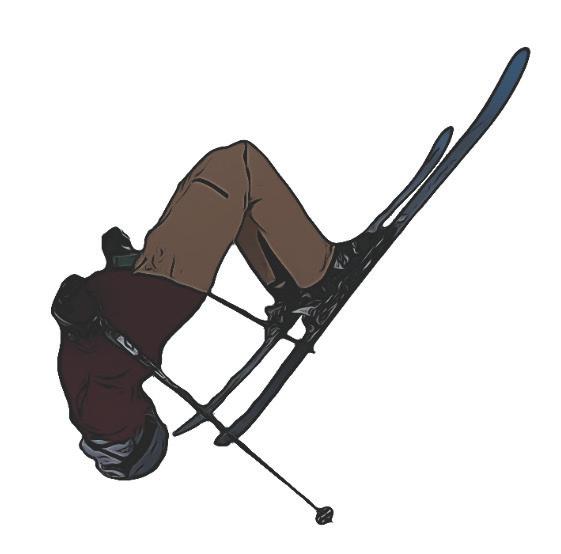

By TYLER CHEUNG, MALCOLM GINWALLA, and SHO NEWMAN
All Paly athletes have been challenged by harsh weather at some point in their career, but their responses can make or break performances.
Under the dark grey sky, senior punt returner Isaiah Phillips digs his feet into the damp ground as the ball speeds towards him. He struggles to locate the ball in the heavy rain, but secures it tightly as the wind blows in his face. With the opposing team honing in on his position, he squints through the rain, and starts to run.
weather can make or break their performance. Although Palo Alto typically features mild weather, the occasional rainy afternoon or unusually cold evening can certainly run its course on any game. Let’s take a deep dive into how Paly athletes are affected by the aspects of weather.
around 1 p.m. in the winter in order to remain in the daylight. This limits the amount of tee time available at courses.
“It also gets dark around 5 [p.m.] which makes it very hard to get full rounds in,” Liao said. “This makes it more difficult to practice and improve my game.”

“Between the rain in my eyes, guys running at me and both the ball and the
Courtesy of Tyler Wong

Sports like golf can be negatively impacted by poor weather conditions. Golf is a unique sport in that the match is decided by comparing scores with that of the opponents,

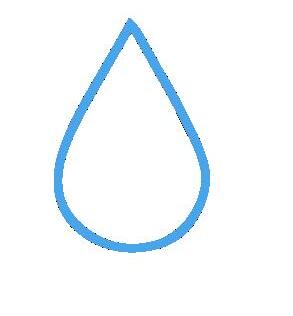
“Things
like gripping the baseball, gripping the bat, all become difficult because baseball is very fast-twitch, so you kind of want to be quick.”
To combat this, the development of ball-tracking technology, indoor/simulator golf has been an up-and-coming industry. Golfers willing to pay the high price can experience an accurate represention at home during the winter when it is impractical to play outside.


— Coco Vonderhaar (‘25)
ter, the quality of these things often de-
“We’re lucky it doesn’t snow here, but it still gets wet and cold which makes it hard to play in the winter,” junior and golfer Dylan Liao said.
Having grass can often make putting on greens less predictable in addition to worsening the lie of balls. The short days in the winter often make it difficult to practice on the course. A typical game takes four to five hours to play 18 holes, meaning you have to start the latest by
Rowing takes place on the water, where rain, wind and fog can be an additional battle athletes need to face. Furthermore, each location comes with unique currents and water levels, each reacting differently to tough weather conditions.
Wind and rain are catalysts for water current changes, making it harder, or easier, to row in a straight path, whereas fog can create visibility issues.
“If the weathers really bad, like 20 mph winds, then we won’t go out,” sophomore and rower Harper Skey said. “We in stead do rowing machines and weights on land.”

game routines and rituals.
“When the weather is bad we do more warmups on land,” Skey said. Athletes turn to workouts on rowing machines and the weightroom, utilizing treadmills for when the conditions are poor. Having on land equipment becomes an important factor for rowers, as some teams don’t have access to indoor devices, handicapping those who live in rougher condi tions, regard less of the season.

ups and pregame stretching. Athletes can face an increased risk of cramping and don’t have the same amount of flexibility as in a warmer weather game. For baseball player and senior Coco Vonderhaar, playing in the cold substantially hinders the level of play.
“75, 80 degrees is perfect weather for running, because you run faster when it’s hotter.”

good [skiing] conditions around once every three weeks during the winter,” junior and skier Hadrien De Martel said. “Last week it was just super icy so it just wasn’t very fun, you couldn’t go off terrain, and it was a big danger as well because you can slip and hit other people.”

— Kailia Leming (‘26)

Similar to rowing, wind tremendously affects tennis matches, and thus a player’s strategy and mentality. Fierce winds can affect how the ball carries, making it harder to control serves and rallies. Rain dampens the ball, affecting how the ball comes off the racket. Players have to play with more margin for error and ball spin, or else the wind can take over quickly. This intensifies the mental battle along with the physical.
“Playing in bad weather primarily affects the mental side of my game, “ sophomore and tennis player Thomas Li said. “It is easy to get caught up with what you can’t control instead of focusing on the things you can control.”
Hard, clay and grass courts each present quite the challenge when the ground is wet. Grass and clay courts become the most slippery under the rain, causing limited mobility, increasing the margin of error when hitting the ball and placing athletes at a higher risk of injury.
Not all weather factors have direct negative consequences, as conditions such as air humidity can positively impact aspects of the game. On clay courts, the extra moisture in the air keeps the surface soft and cohesive, allowing athletes to be more mobile within the court. Additionally, the air will make the ball heavier, slowing the ball down and forcing players to emphasize ball placement
“Especially in the colder weather, you have to stretch better as a lot of athletes will get injured during this time,” Vonderhaar said. “Things like gripping the baseball, gripping the bat, because baseball is a fast-twitch sport, so you kind of want to be very quick.”
Runner and junior Kailia Leming also notices the downsides of cold weather in fast-twitch sports like track and field. “You cramp more when you’re in the cold because your muscles aren’t properly warmed up and ready to go,” Leming said. “75, 80 degrees is perfect weather for running, because you run faster when it’s hotter.”
Many sports are limited to playing in certain seasons; this causes an imbalance in the amount of sports spread across different seasons. Paly hosts eight sports in the fall, four sports in the winter, and 10 sports in the spring. The poor conditions in the win ter cause a large amount of sports to move to the springtime, which results in different sports having to compete for practice space, creating less playing time for athletes who have to share facilities.
Weather can play a key role in the availability of snow sports, specifically ski ing. Living in the Bay Area makes it difficult to make regular trips to a ski loca tion. Finding good condi tions doesn’t only affect the enjoyment of skiing, it also
Even when conditions are optimal, crowds can often make the skiing experience less appealing.
“Sometimes places like Heavenly had really long lines; long lines can definitely ruin the experience,” De Martel said.
With the effects of global warming in recent years, many outdoor practices and games in the summer have to face extreme heat.
“There was one or two weeks last summer where it was extremely hot, I think it was over 100 degrees at some point,” junior and football player Jake Wang said. “We had to bring tons of water out and limit our reps outside.”
The team had to shorten their practices a lot during the heatwave, which slowed down players’ development.
Weather isn’t just a backdrop for sports. It plays an integral role in how each athlete performs. Athletes constantly have to adapt to the elements that they face. For athletes, they aren’t just preparing for their opponents, but for Mother Nature as well.
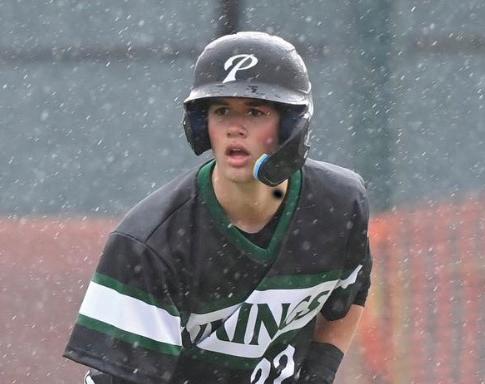

By DYLAN ROBINSON
Plyometrics are a well documented way to improve an athletes strength and sports-specific skills, yet aren’t a commonly used option among Paly students.
Junior Ian Johnston swipes through his Instagram reels page. Not for the first time, he sees a self-proclaimed guru deeply engrossed in exercise, engaging in a crazy series of jumps and poses while professing the positive benefits of so-called “plyometrics”. For athletes like Johnston, It’s difficult to avoid influencers deep in these unorthodox exercises.
Plyometrics are a type of exercise revolving around rapid and explosive movements, usually involving squatting, jumping and change of direction. Although invented in the 70s by Russian sports scientists, plyometrics failed to break into mainstream media and training programs until recently.
The most likely explanation for plyometrics becoming increasing involved and accepted in mainstream fitness and sports is due to the rise of exercise types such as crossfit or other High-Intensity-Interval-Training (HIIT) classes. These types of training involve many similar philos-

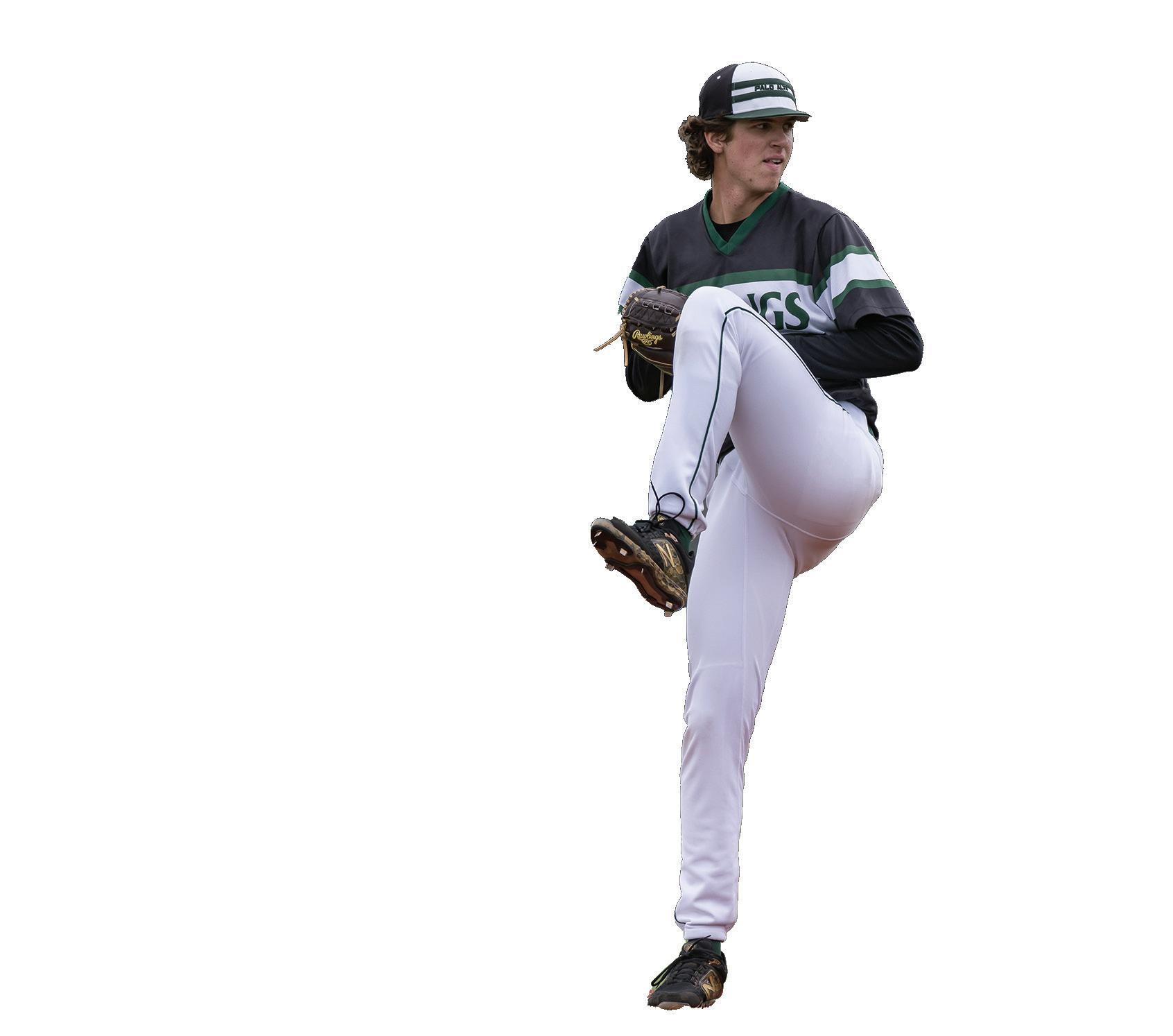
ophies and movements to plyometrics, such as crossfit’s frog jumps and HIIT’s rapid explosive movements.
These classes, although often focusing less on athletes and more on people trying to get into shape, led to plyometrics becoming more easily accepted and accessible in the fitness world.
“It’s important that plyometrics are goal or sportspecific.”
Plyometrics present a way for athletes to train their bodies with sport specific exercises, making it far easier for athletes to improve strength in motions that will actually occur in their sports rather than just increasing overall strength through gym work. In fact, sport-specific plyometric

have been shown repeatedly through studies to significantly improve muscle mass, strength and coordination. “Plyometric training induces increased muscle maximal strength and neural adaptation and is an effective method for improving lower limb explosive strength,” Lunxin Chen said in his 2023 study from the Journal of Environmental Research and Public Health. “...Adolescents at different maturity levels can benefit from plyometric training.”
Tyler Vinson, PT
Going beyond the lab, Paly students commonly report the positive effects of adding plyometrics to their routines. For baseball pitcher Johnston, the effects were not only noticeable, but overwhelmingly positive.

“Not only have I seen an increase in the main muscle groups, but also an increase of strength in smaller muscles that help me with baseball,” Johnston said. “Adding these exercises to my routine have also helped with a lot of arm pain that I have had in the past.”
Additionally, physical therapists and doctors are increasingly recommending plyometrics to their charges as an alternative to traditional gym work and ther-
Along with this rise, sports injury prevention strategies recommend plyometrics as part of everyday movement and agility training for athletes. For example, the FIFA 11+ Pro Warmup, a standard soccer warmup released by the sport’s governing body for injury prevention, recommends squat jumps and other plyometrics as part of an athlete’s every-
However, similar to other training or fitness strategy, it’s important to understand how to properly use plyometrics, as incorrect use can lead to ineffective training or even injury. One of the easiest ways to misuse plyometrics is to engage in exercises that don’t apply to your spe-
Tyler Vinson, a physical therapist at local Palo Alto clinic Agile Physical Therapy, has spent years implementing various plyometric workouts into the recovery process for athletes and nonathletes alike. For Vinson, the best plyometric workouts are those done with a specific improvement in mind.
“It’s important that plyometrics are goal or sport-specific,” Vinson said. “For example, plyometrics for a baseball pitcher will look different from a soccer player’s.”
Iverson Lee, a junior point guard for Paly’s basketball team, focuses on plyometrics designed to improve his jumping and lateral agility, two of the most important and common movements in basketball.
“I use box jumps for height and landing drills for improving my jumping,” Lee said. “And I work on lateral bounds to get faster side to side.”
On the other hand, a baseball player such as Paly senior Cormac White would engage in plyometrics focused around throwing, acceleration and agility reaction training meant to improve baseball-specific skills. These exercises could include movements like medicine ball twists to improve rotational strength for throwing, broad jumps for explosive power or cone and ladder drills for im-
proving quick movements and speed.
“There are so many different muscles that need to be trained for baseball that some of the exercises can be a little unorthodox,” White said. “An exercise that I personally enjoy that helps with core stability and movement control is a water bag ‘ghost’ throw.”
Despite the easyto-assume belief that plyometrics are relatively similar across different sports and using different sports’ exercises would have littleto-no effect on the actual quality of output, this is not the case at all. Since many exercises may look similar, athletes interested in implement ing plyometrics into their home workouts will need to be discerning when they are choosing exercises online or from uncertain sources.
rics lack obvious aid. One such example is Paly’s water polo team, whose athletes report a lack of jumping and band training as part of their workouts, despite the fact that research has indicated that plyometrics could effectively strengthen athletes.

“Adding these exercises to my routine have also helped with a lot of arm pain that I have had in the past.”
Ian Johnston (‘26)
In fact, multiple Paly student-athletes interviewed for the purpose of this article didn’t know what plyometrics were, highlighting the lack of information that still surrounds plyometrics for Paly students.
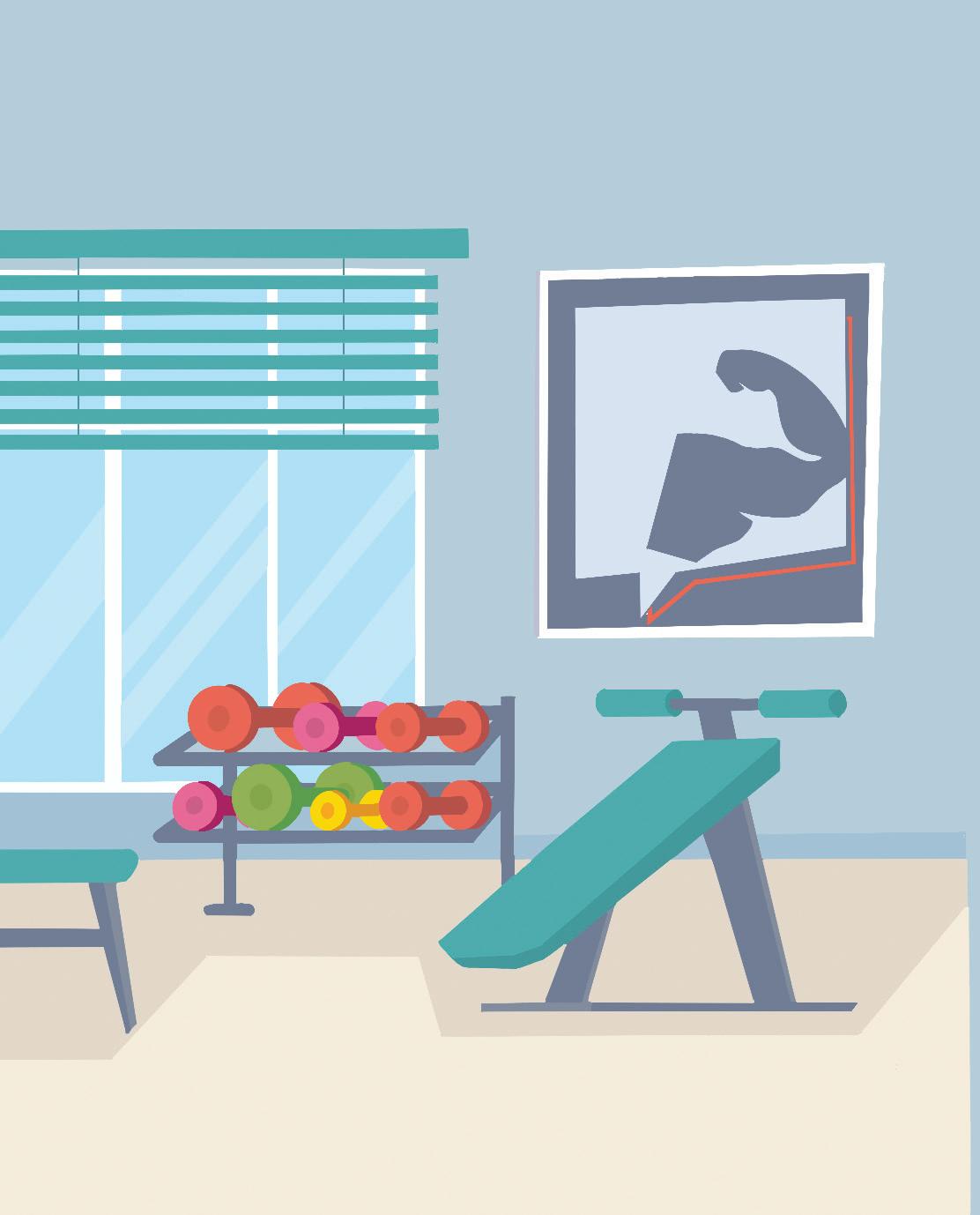
Just like anything else, however, plyometrics are not always safe. The questionable decision of attempting to engage in exercises while injured or during recovery could likely result in exacerbation of injuries, making problems worse than they had been before.
“Plyometrics should not be utilized while one is still getting over an acute injury,” Vinson said. “If one persists in completing plyometrics while injured, this could lead to painful bone injuries or early and mid stage tendonitis.”
Despite these positives, many people remain unaware of the benefits plyos can provide, and not all coaches implement them into their team’s training schedules. In fact, a Viking poll found that only 47% percent of Paly athletes reported doing plyometrics during their regular practice schedules, if they did them at all.
This means that a large portion of athletes are missing out on the potential gains and benefits of implementing plyometrics into their training schedules, as well as the ability to reduce the risk of injury that plyometric workouts can bring.
This gap is even more clear in less explosive-focused sports where plyomet-
“I believe that all athletes can benefit from different types of training, plyometrics included,” Johnston said. “It’s a simple way for athletes to get an upper hand on opponents.”
Plyometrics are not exercises that are reserved solely for high performance athletes. Although non-athletes and students engaged in recreational sports should adjust the intensity, level and duration of their plyometric training according to their skill proficiency, plyometrics can still provide a huge boost to performance, skill and overall fitness in sports and everyday life.
The positives that plyometrics deliver for any athlete looking to up their game make them a powerful tool to have in one’s arsenal. Despite the risks and learning curve necessary to properly utilize plyometrics, the positives they can have on performance and safety are undeniable.
For many Paly athletes, plyometrics are known in passing if not with familiarity, meaning that they may be missing out on reaching their true potential.
Armed with the necessary information on the positives, risks and strategies behind implementation of plyometric training, Paly’s athletes and nonathletes alike can improve their fitness and overall strength.
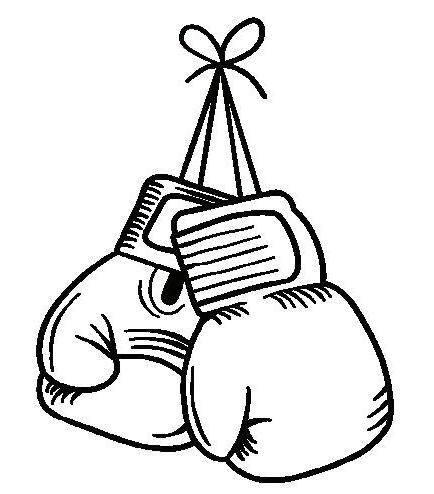
SBEN LEVAV and EVIN STEELE
Senior Max Newman is carving his own path in boxing and MMA, inspired by his father’s legacy in the sport. He balances intense training with academics, pushing himself to grow both physically and mentally.
school athlete — he’s carving out a future for himself in the world of fighting, with no clear path to follow but his own.
Newman’s fighting journey is not unusu al for his family, an important reason as to why his parents are so open-minded about his MMA/Boxing career.
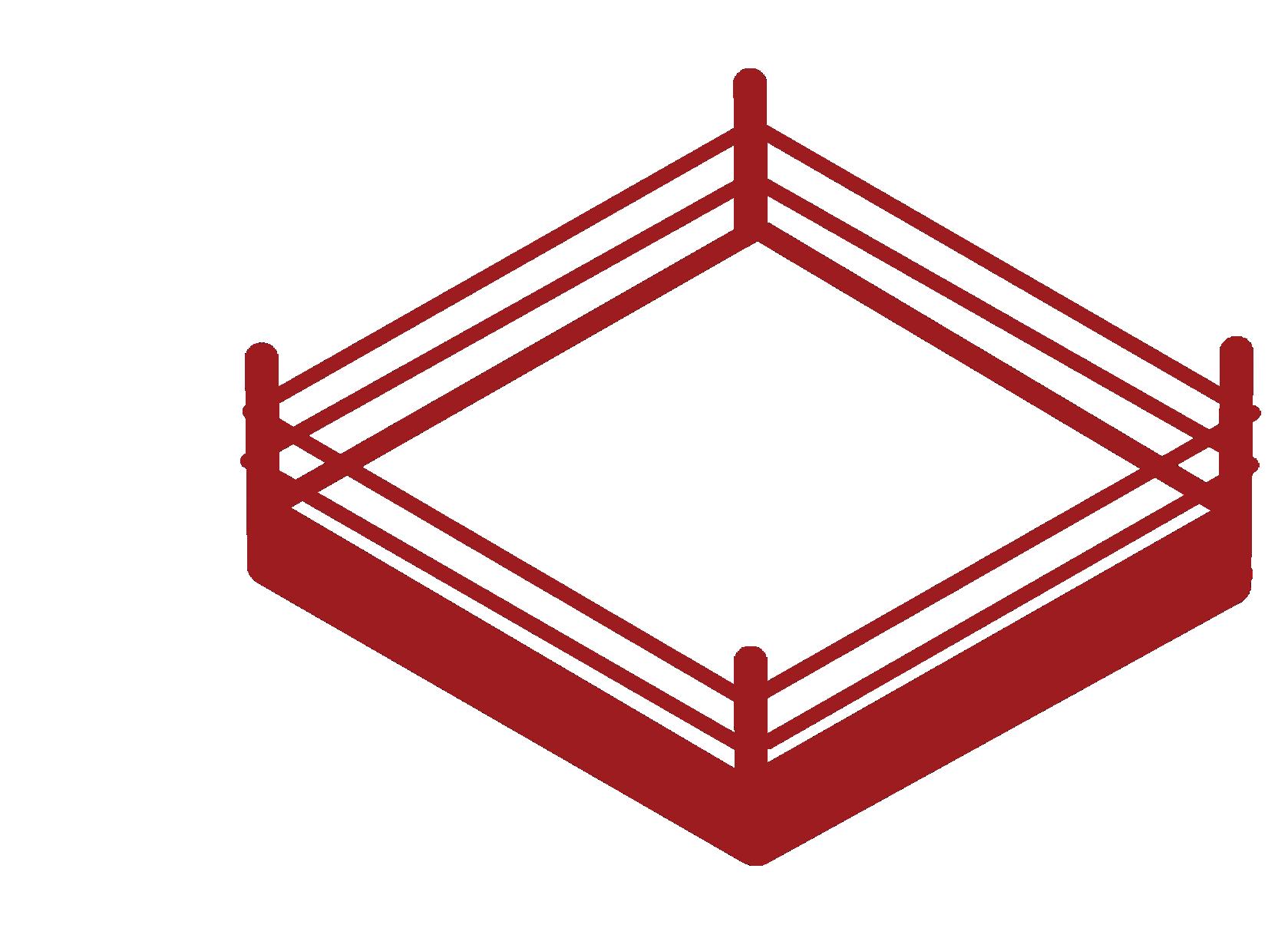
econds tick by as senior Max Newman waits for the final round to begin. His head, ribs and arms ache as sweat pools on the back of his neck. Newman’s hands guard his chin, his mus cular physique pronounced yet relaxed. He stares across the ring, trying to locate his opponent’s weak spot. With only one remaining round, Newman knows he needs a strong performance to win. Years of dedi cation and intense training have pre pared him for this mo ment. He looks to his left, and sees his father ringside, nervously sur veying the scene. Newman readjusts his gaze back to his op ponent, takes a deep breath and mentally prepares himself for the two minute battle on the verge of commencing. The bell rings, signifying the start of the final round.
“Ihavetodoitallonmy own,butthat’s partofthe challengethatI enjoy.” —MaxNewman(‘25)
“My dad did a lot of boxing, MMA, and all that stuff when he was younger,” New man said. “That was pretty normal for my dad, so he’s not surprised that I got into it. My mom, on the other hand, she’s supportive of it, obviously, but she doesn’t really love it — she’s not excited about it, but still sup ports me.”
father brought him to watch his first professional boxing match, sparking Newman’s interest in the sport. “When I was
In the world of high school athletics, students often gravitate toward the same traditional sports: football, basketball, soccer, etc.
Newman, a senior at Palo Alto High School, has chosen a different path. While his Viking peers dominate in the field and on the court, Newman steps into the ring. Training in boxing and MMA, he pushes both his body and mind to their absolute limits. With a career fueled by a passion for combat sports that was ignited at an early age, Newman isn’t just another high
Newman’s father was a key influence in his decision to pursue the sport. Newman started boxing at the age of 12, and tran sitioned into MMA at the age of 14. As someone who grew up understanding the discipline, hard work and mental toughness that comes with fighting, the martial arts background Newman’s dad brought into the family wasn’t a foreign concept to him. Though his mother may have reservations about the risks involved, she remains supportive, offering a balance of caution and encouragement that’s important to Newman’s journey. At just eight years old, Newman’s
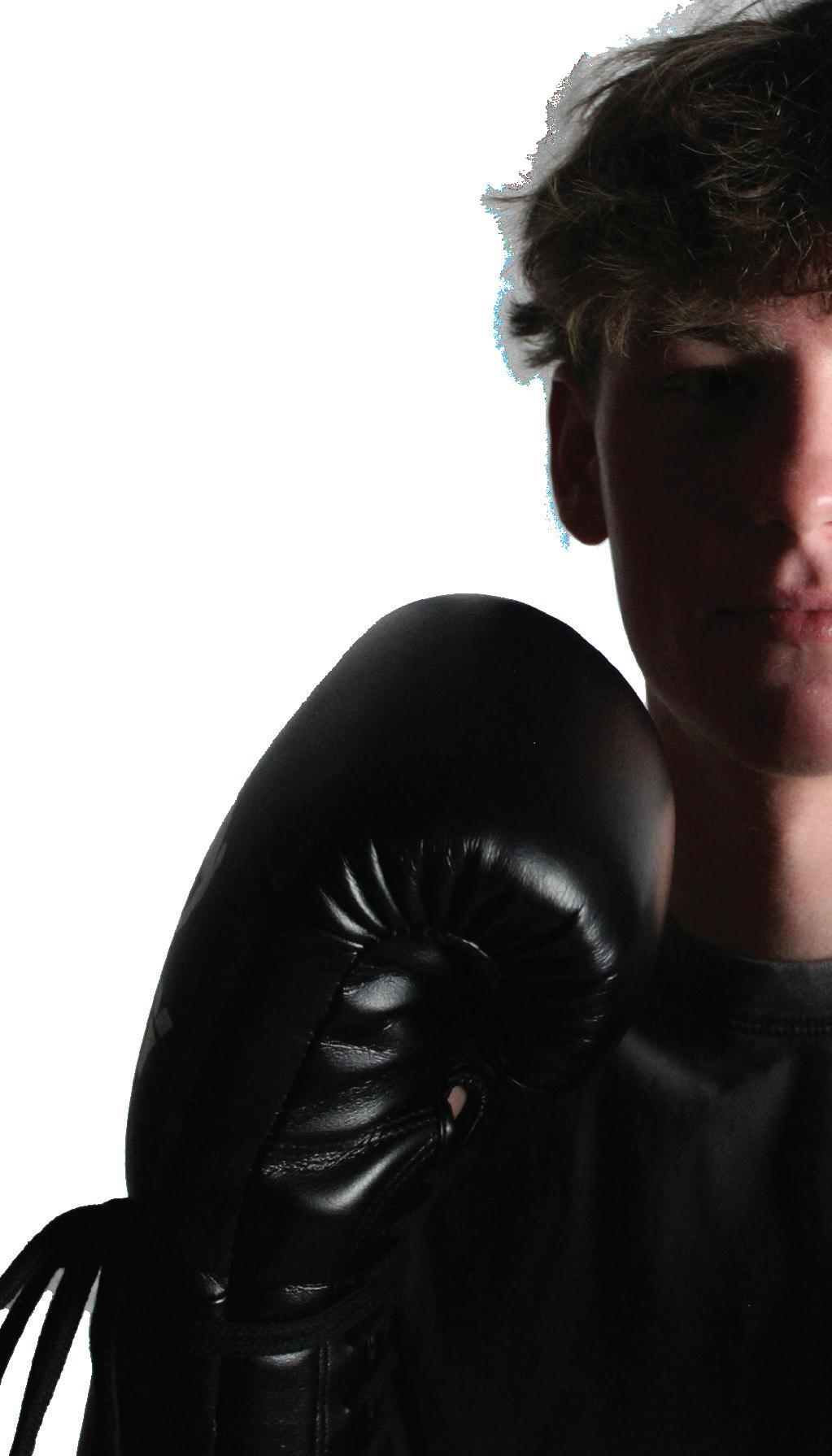
facility, yet neither are offered at Paly. Newman trains at local gyms, where he hones his skills, preparing for local competitions and matches. Balancing this with schoolwork, friends and everything else that comes with being a high school senior is no easy feat, but Newman has found a rhythm.
“It’s tough sometimes,” Newman said. “But it’s all about time management. I make sure to set aside time to train, and I have a good support system to keep me focused. It’s definitely different from a regular sport at school because I have to do it all on my own, but that’s part of the challenge that I enjoy.”
Like any combat sport, boxing and MMA come with their fair share of physical risks. Newman has been fortunate so far, avoiding any serious injuries, but that doesn’t mean he’s walked away unscathed.
“Luckily, I haven’t gotten anything too bad, but I’ve had some injuries. The two big ones I’ve had so far are pretty bad muscle strains in my neck just from getting whiplash, and I get minor headaches sometimes after sparring or a heavy workout,” Newman said. These injuries are a reality for anyone in combat sports, where the physical toll on the body is inevitable; but Newman doesn’t let the minor setbacks deter him.
He approaches recovery with the same discipline he applies to his training, understanding that proper care and rest are key to
maintaining a long-term career in boxing and MMA.
To prevent long-term damage from the sport, it’s important to wear the proper attire. This consists of protective gear: such as headgear, mouthguards and gloves. Ameteur boxers wear growing gears; this protects boxers from low blows and kidney shots.
Newman’s favorite part of boxing is the tournaments he regularly competes in. Tournaments are in a bracket style format, organized by weight class. Boxers have to make sure they meet the eligibility and registration. This includes the age, weight and experience requirements under the amateur boxing organization, which is the main organization people use in USA boxing.
“Another thing is most tournaments that you’ll find level are just single elimination, so you can pretty much just box until you lose a match,” Newman said. “Other things like advancing is if you win, you move on to the next round and you progress, and once you advance high enough, there are quarterfinals, semifinals and finals to determine who’s the winner.”
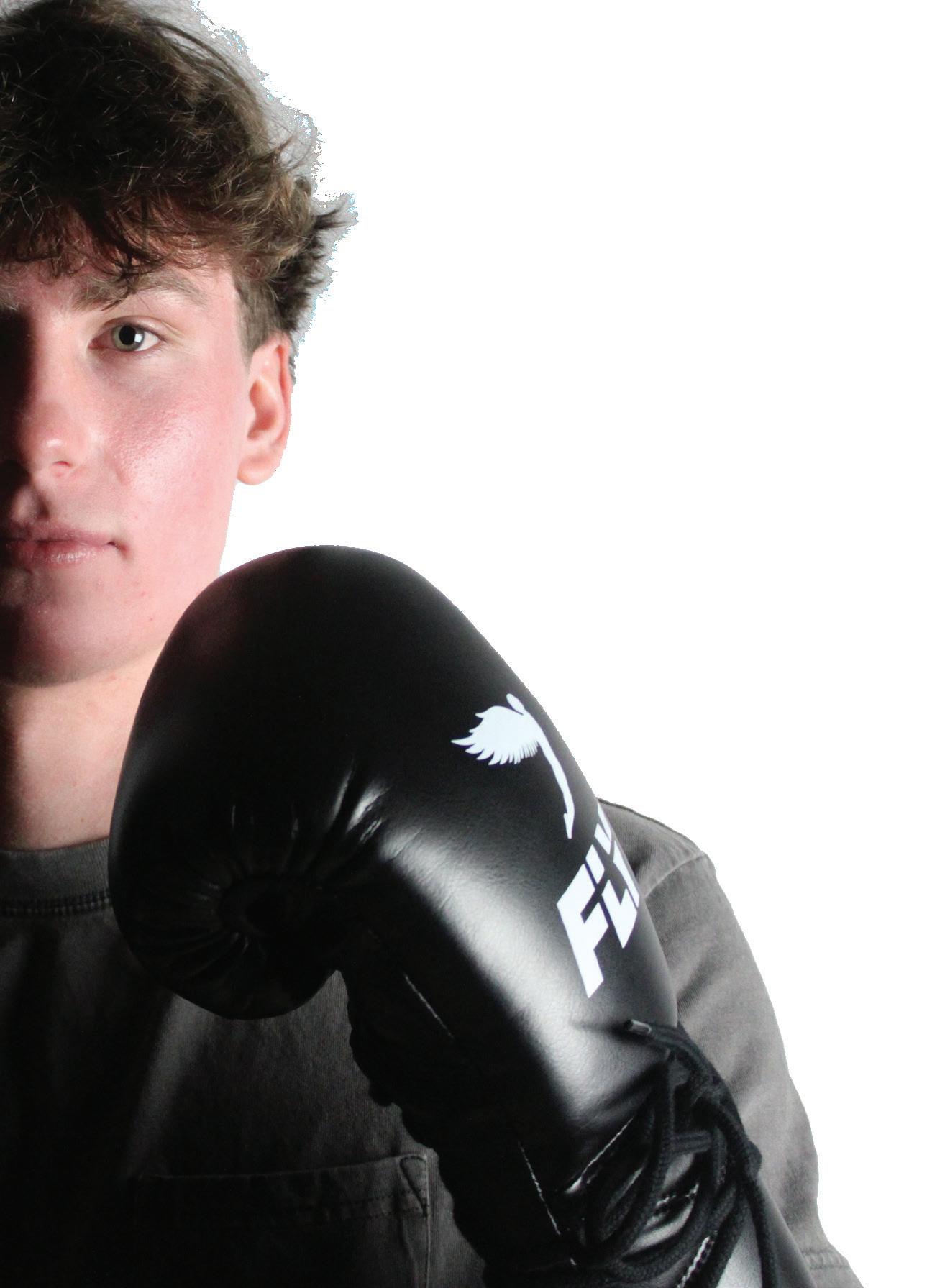
The tournaments are fast-paced, with matches consisting of three rounds of three minutes each. “If you knock some
to-six days a week.”
While the physical side of boxing and MMA is critical, Newman is equally invested in the mental game.
“A lot of people think it’s just about throwing punches, but it’s so much more mental than people realize,” Newman said. “You have to know when to push and when to pull back, when to attack and when to defend. It’s all about strategy, and it’s a huge mental game.”

The ability to read an opponent, adjust in real-time, and make split-second decisions is what sets great fighters apart. This mindset isn’t limited to the ring — it’s a philosophy that extends to all areas of his life, “from school, to [training] sessions, and [even] personal growth, ” Newman said.
As Newman looks ahead to his future, he remains focused on his goals in boxing and MMA. He’s determined to continue improving his skills, but he also recognizes the importance of balance.
“Boxing and MMA are such important parts of my life, but I also want to keep learning and growing outside of the

“Alotofpeople thinkit’sjust aboutthrowing punches,butit’ssomuch more.” —MaxNewman(‘25)
ing through lifting and cardio. Lifting helps improve power, force, endurance and helps prevent injury. Cardio is crucial for stamina and endurance to compete in a match.
“I have a peloton at home so I usually just do a bit on the exercise bike or I’ll just go and go on a run,” Newman said. “For weightlifting, I go to the gym five-
His academic success and commitment to his education show that Newman isn’t just focused on his athletic career; he’s also dedicated to his personal development. Combat sports have provided more than just physical fitness— they’ve taught him valuable life lessons in discipline, focus and perse-
“The mental toughness I’ve gained from boxing and MMA has helped me in every part of my life,” Newman said. “I know that whatever happens, I’ll keep pushing myself... in and out of the ring.”
As Newman prepares for future competitions and continues to grow as a fighter, his journey is just beginning. Whether he pursues a professional career or simply continues to challenge himself, one thing is clear: Newman is carving his own path, one KO at a time.
By CARTER BURNETT and PETER REVENAUGH
Squash, while not properly highlighted at Paly, is a sport that sophomore Conrad Lui has dedicated his life to. Like other athletes, he is required to juggle his demanding squash schedule with his academics.
Sophomore Conrad Lui steps onto the squash court, instantly feeling the thick heat entrapped in the arena. Enclosed by four walls, he prepares for the ensuing battle, a backand-forth exchange lasting up to 90 minutes. As he settles in, he relaxes his nerves, and focuses on his fundamentals. When it’s time to spin his racket for first serve, he is ready for the intense match ahead.
Squash is rarely mentioned as a sport played by Paly students; Paly does not field its own squash team. However, Lui is an exception. Introduced to the sport when he was younger, Lui has stuck with it ever since, and now continues to play on a daily basis.
“Squash is always my favorite part of the day, not only because I enjoy playing it, but it is also a great way to get my mind off of school,” Lui said.
Squash, similar to pickleball, is played by a wide age range; some start playing as early as three-to-four years old, and continue well into senior citizen status. Squash is played on a six-by-ten yard court, where the opponents take turns hitting a rubber ball off of a wall, and utilizes similar rackets to tennis. The rubber ball ultilized is roughly the size of a golf ball, and players switch off hitting the ball against the main wall. The easiest way to win a point is by your opponent hitting the ball out of bounds, or letting the ball bounce twice
after your hit. Another way to win a point is if you get a stroke, which occurs when your opponent is in the way of your swing or if they get in the way of the ball on its way to the wall. You need 11 points to win a game in singles and 15 points in doubles, and the first player to win three games is victorious in the match.
According to the CDC and Wisconsin DHS, while playing squash, the average American will burn 1,035 calories per hour, exceeding the amount of calories burned in popular sports such as soccer and basketball in the same time frame. The high amount of calories burned is due to squash consisting of fast-paced and high-intensity movement, as well as it being played indoors in high temperatures.
“It takes a lot of mental strength to not get aggressive when getting down [in points].” CONRAD LUI‘27
“When I first started playing squash I was surprised with how easily I was out of breath; most people do not understand that squash is a very physically demanding sport,” Lui said.
In addition to the physical challenges, Squash can also be mentally demanding on players, according to Lui.
“Once I start losing points, I tend to play more aggressive, which usually leads to me losing more points,” Lui said. “It takes a lot of mental strength to not get aggressive when getting down, but most
of the time I feel it is the only way I can win the match.”
Squash gained popularity on the east coast due to its emergence from Ivy League universities. The same can not be said in California, leaving Lui having to frequently travel out of state for matches. This travel takes a toll on Lui’s academics and well-being, burdening him with a heavy work load of make-up as signments while play ing in long, exhausting tournaments.
“I often travel to far tour naments, and when I am resting between matches I do homework to catch up, or any work to get me ahead,” Lui said.
The balance of school and travel only gets harder, ac cording to collegiate squash player Gabriel Feinstein.
“Balancing travel and school is definitely diffi cult,” Feinstein said. “I make sure to complete my assignments well in advance if possi ble and communi cate well with my professors. I also do a signifi cant
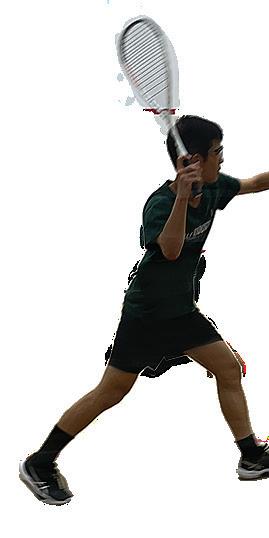
amount of work while I am traveling either on plane or bus.”
career, and was a big factor in elevating my game,” Patel said.
just went on from there.”
Even without the travel, squash demands a significant time commitment from Lui.
“I play four-to-six times a week and even more on holidays, but I generally put about 10 -14 hours a week into squash,” Lui said. This commitment further increases at the collegiate level.
“I play four to six times a week and [play] even more on holidays.” — CONRAD LUI‘27
“I have around eight sessions a week,” Feinstein said. “Overall I probably spend 12 hours a week on court and another 10 hours doing other squash related exercise (recovery, lifting, running).”
Although this intense commitment and traveling schedule can be a contribuing factor of unpopularity amongst Bay Area students, the talent isn’t lacking, with multiple Bay Area kids making the “top 10 players” list in each age group.
With this dedication in mind, many skilled players have to miss class, forcing them to look for other options. One popular path for players is transitioning into a personalized private education with more flexibility. Zane Patel, a formerly ranked number one player in the US, transferred from Henry M. Gunn high school to Saint Francis to pursue his squash career.

“Switching to private school allowed my to focus more on my squash
Due to squash’s absence at Paly, many are unfamiliar with college routes for the sport as well. Although not very popular nationwide, college squash has its own program called the College Squash Association, or the CSA.
Lui did not always think of squash as his path, as he did not know about the sport until he was introduced to it by his uncle when he was 13 years old. Since then Lui has fallen in love with the sport, dedicating almost all of his available time to training, and is hopeful to go to one day play at the collegiate level.
“I got into squash when I was visiting my uncle who lives in L.A., and he offered to play it with me,” Lui said. “I really liked playing [squash] and when I got back home, I asked my dad if I could play more, and
Lui may have gotten into squash a little later in his life, but it has now flourished into one of the most significant parts of his life. Playing squash has forced Lui to learn how to deal with an overpacked schedule and how to overcome obstacles. As Lui continues his squash career, he hopes that squash can grow in popularity in California, as he thinks many would enjoy playing if they were given the op portunity.
“I hope that with squash becoming an Olympic sport it will gain recognition, and be come more accessi ble across the coun try, or at least more accessible locally,” Lui said. “It is very popular for kids on the east coast, so I don’t see why it wouldn’t be popular here.”
“I hope that with squash becoming an Olympic sport it will gain recognition.”
CONRAD LUI‘27
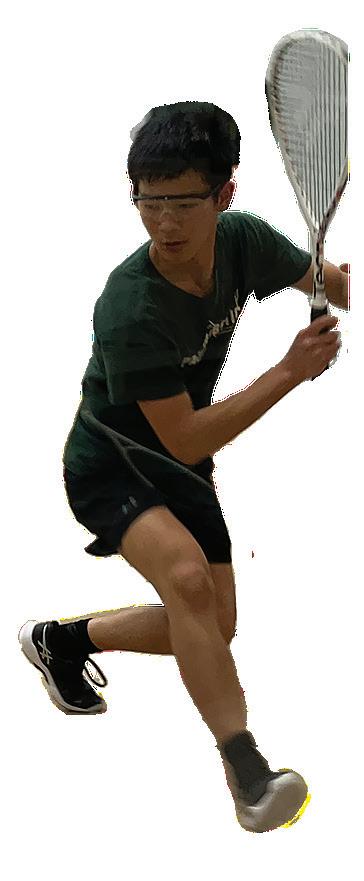
Everything you ever wanted to know about squash...
quash is one of the oldest racket sports, beginning in England during the 1800s. There are three versions of squash: hard-ball singles, soft-ball singles and doubles. Hardball singles is played on the same court as soft-ball singles, but uses the ball of doubles. The soft-ball weighs more and is less bouncy than the hard-ball. Double courts are typcially larger than the singles courts. All three of these are played on a four-wall court with wooden floors. You begin the game from either service box, and have to hit it onto the other side of the court. To serve, you must go over the middle line of the court and stay under the line at the top of the court. All shots after the third can
go from the top line to the tin, which is a metal sheet on the ground floor that rises about two feet. Singles consists of one serve, while you get two serves in doubles.
A point is scored when an opponent lets the ball bounce twice, hits it out of bounds, is in contact with your striking motion or is hit by the ball. To win in singles, you must get 11 points and be ahead by two, and you must win three games to win a match.
In doubles you must win 15 points to win a game; the same three-game system applies as well. The current best players are Egyptian players, as it has been ingrained in their culture since England colonized Egypt. The English colonizers built courts
outside in Egypt, and during the daytime, the heat was too much for the Englishmen, allowing the Egyptian kids to play in the intense heat.
This sparked an interest in squash amongst kids, as it was one of the only sports available for them away from the heat. This widespread culture has stayed in Egypt for 100 years and has created some of the best squash players of all time.
Although the U.S. is not a front-runner at squash, the women's team is nearing the number one slot and the men's team is improving in recent years.
Squash is also gaining popularity worldwide, due to the introduction of Squash to the upcoming 2028 L.A. Olympics.



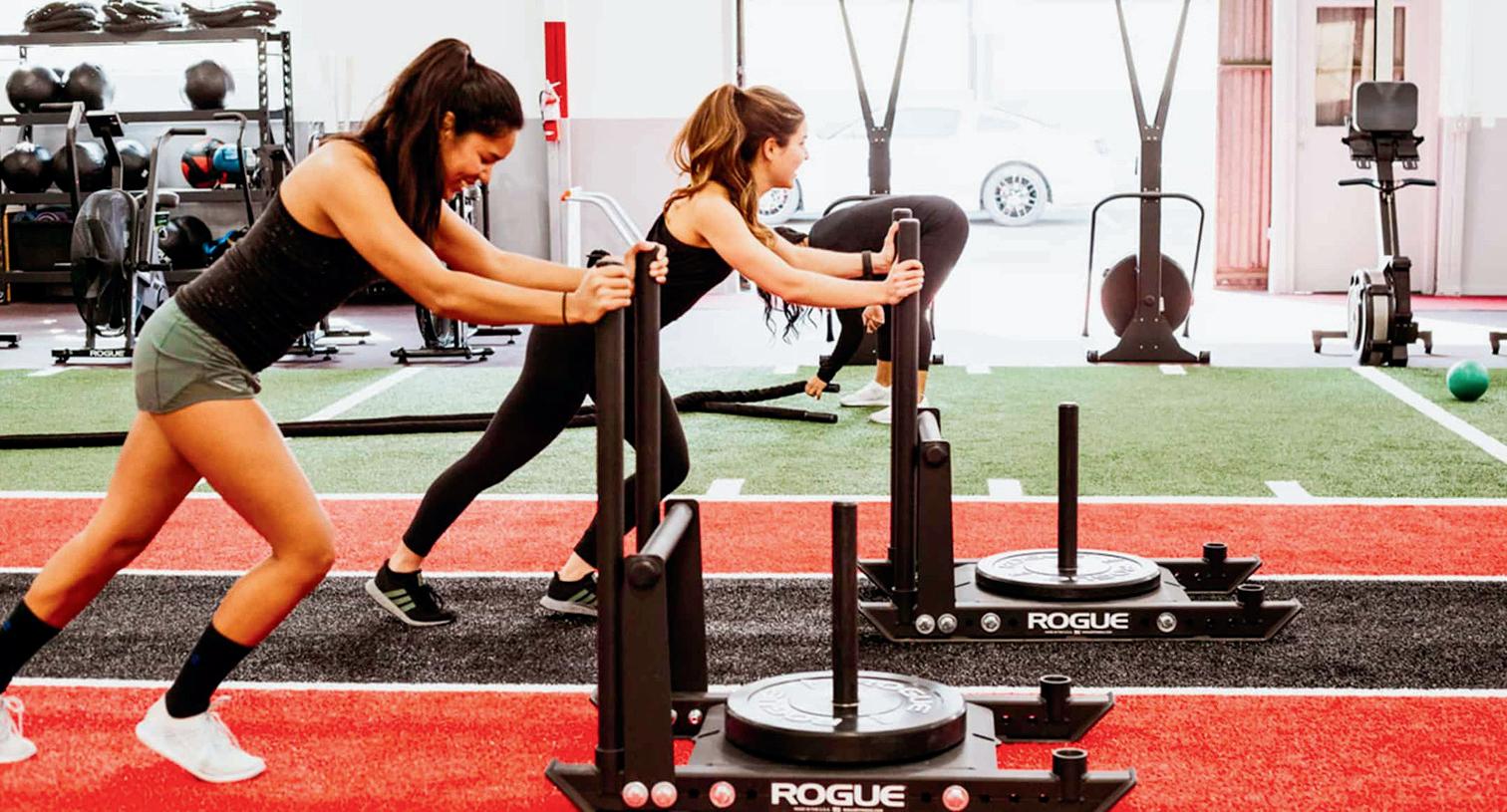


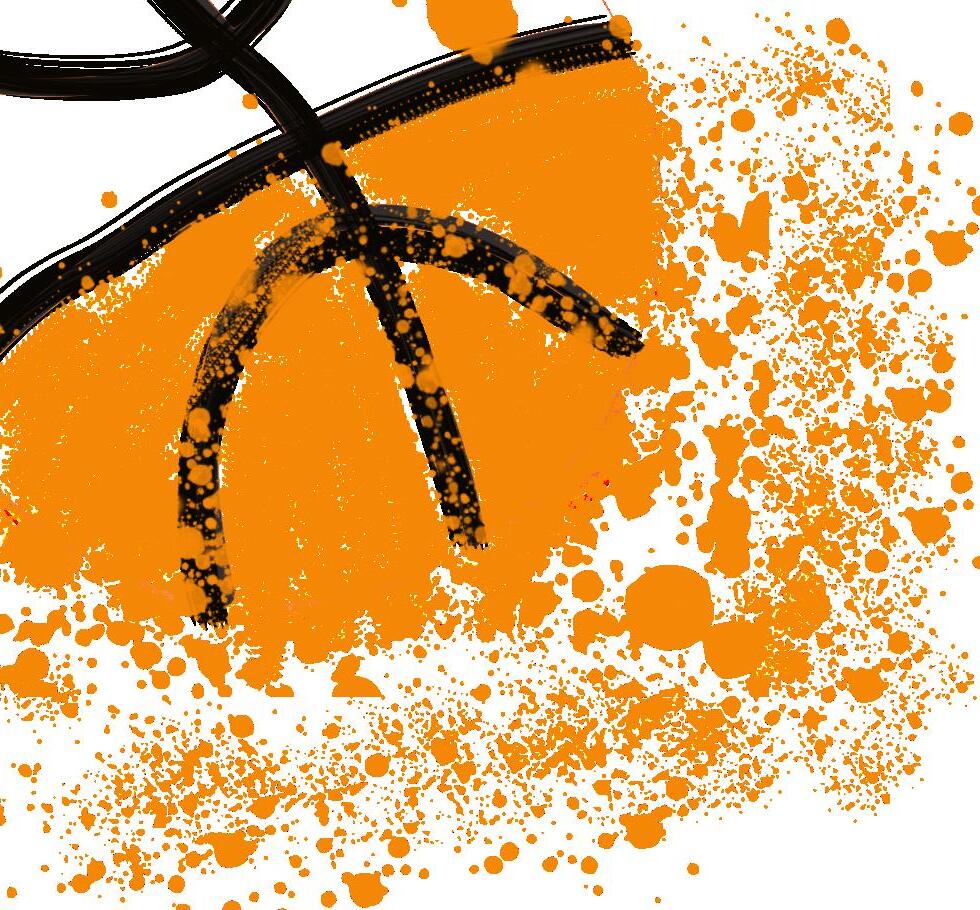
By TYLER CHEUNG
NBA ratings have been significantly declining in recent seasons. The league must consider drastic rule changes to restore excitement. Let’s take a deeper look into the key changes that could revitalize the game.
Game seven of the 2018 NBA Western Conference Finals: the Harden lead Rockets face off against the Curry lead Warriors. The fans are hyped, but they soon realise that every time the ball leaves the player’s hands, it’s from behind the three-point line. Miss after miss, the rockets continue throwing up long range shots. Soon, the graphic shows up on the big screen, the rockets have missed 27 consecutive three-point shots. As the final buzzer goes off, the Warriors win a low scoring game 101-92. The follow ing morning, sports analysts across the nation came to one conclusion: the Rock ets lost because they shot way too many three-point shots. Rule changes have always been a core part of sports. As players and technology develop overtime, it is necessary for rules and regulations to adapt as well. The NBA has implemented many targeted rule changes in recent years, altering small aspects of play that have little-tono effect on the larger flow of the game.
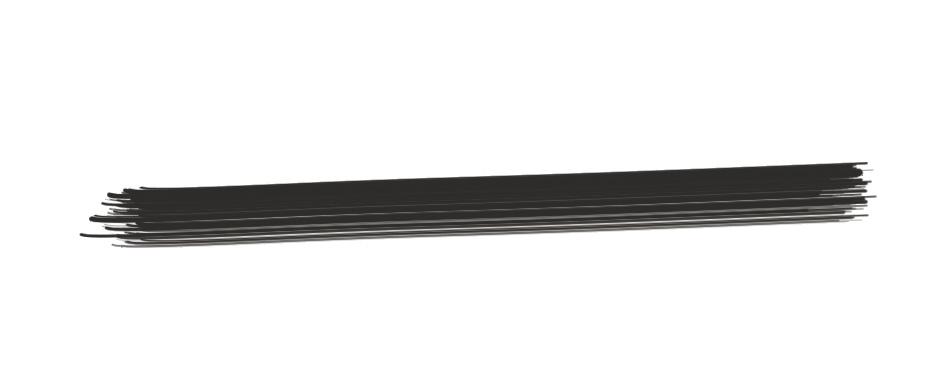
There needs to be major rule changes in the NBA to make it more entertaining for both casual and die hard fans. Other big sports leagues like the NFL and MLB have made recent major changes to their rules that improved viewership experience significantly. For example, the MLB recently confronted their slow play by adding a pitch clock, in addition to removing major defensive shifts and increasing the size of bases.

The most clear problem with the current NBA is the excess amount of threes being tak en every game. Before the threepoint line was added to the NBA in 1979, the game was predominantly dominated by tall and strong players who were good at converting short range shots. The threepoint line was added in an attempt to create body diversity in the game and allow an opportunity for shorter and faster players to make a significant im pact on the game. The present day NBA has the exact opposite problem. Nearly
40 percent of the shots in today’s NBA are behind the three-point arc. Players are turning down easy two-point shots in favor of attempting contested threes. Being a good shooter at all levels has become a necessity. Old school physical basketball has slowly faded away. An increase in shooting skill has made it statistically favorable to shoot more threes. This may be beneficial for teams, but it just isn’t good for the development of the game of basketball. Players who are considered stars are those who are the
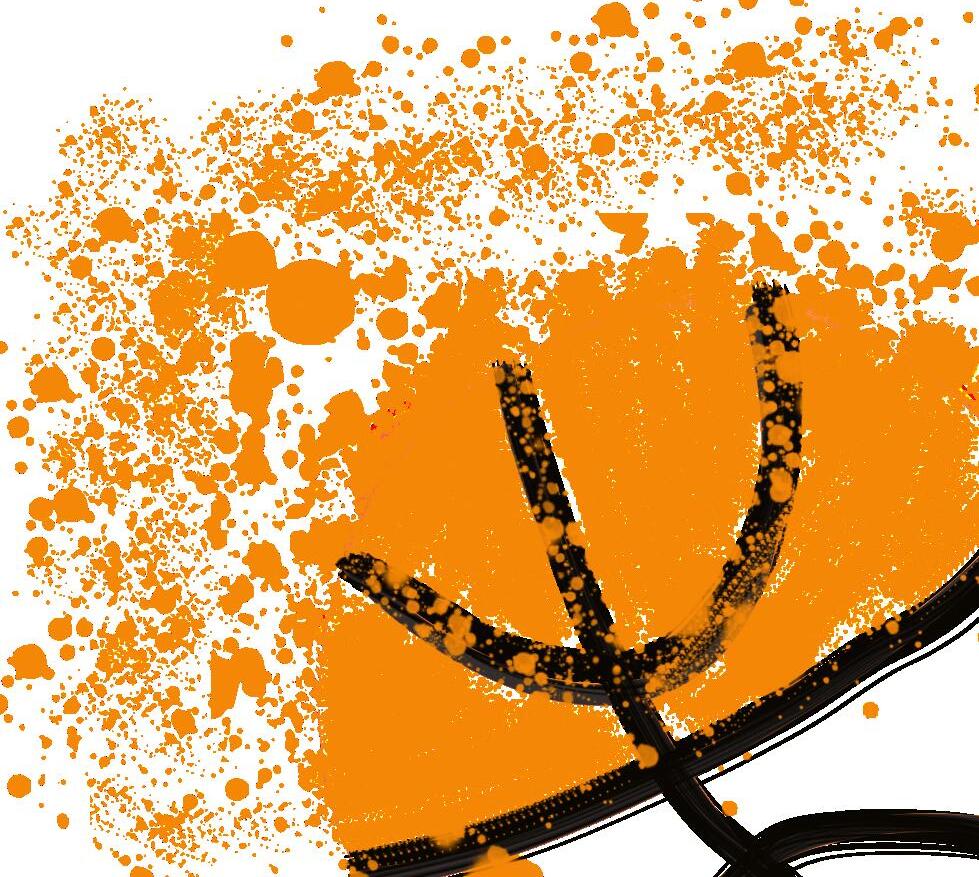

shot will be worth more in comparison to a long range shot than it was previously, shifting the NBA back to a more physical and big-man dominated league. Bad shooters will no longer shoot threes because the risk vs reward will be too high.
This drastic rule change doesn’t have to be immediately implemented into the NBA. There are opportunities to experiment with different styles of a certain sport. For example, the golf industry has developed a unique league called TGL that plays indoors on an extremely large simulator screen. The PGA had been struggling with pace of play, and so the TGL was introduced as an experimental league while still allowing traditional golf to continue. Simulator golf is able to add shot clocks while also eliminating the down time of walking to your ball, increasing the amount of time that viewers are actually watching players hit golf balls. The point is the NBA doesn’t need to immediately enforce extreme rule changes immediately. They can create separate leagues, or change rules in their developmental G League to see if these adjustments could be successful. If some rule changes seem to work overtime, they can be added into the NBA. Another problem in the NBA is load

management. Imagine saving up for weeks to go watch your favorite NBA team, but your excitement dissipates as you see your favorite player sitting on the sideline in sweatpants and a hoodie. Unfortunately, this is the reality for many fans as more and more star players are sitting out of regular season games to rest and avoid injury. The current player par ticipation states that “no more than one star player is unavailable for the same game.” This still allows one star player to sit with out an injury and sends a bad mes sage to fans that some games are less valuable than others. These players are getting paid tens of millions a year, and therefore should be required to play every game they can. Without experiencing a season ending injury, star 76ers player Joel Embid has only played in approximately 60% of his career regular season games. The NBA needs to more strictly enforce these player participation rules, and require star players to play if

they are not injured.


People argue that the 82 game season is the reason NBA games don’t feel important, but the NBA has had many 82 game seasons in the past with significant success. The main thing the NBA needs to incorporate is primetime games. The NFL does this perfectly, having designated games on certain nights like Sunday Night Football. These games are regular season games, but they feel important because they are advertised properly. These primetime games also keep their announcers consistent, which make their voices feel inconically connected to important games. The NBA has specific games that are broadcasted on national TV, but they aren’t given any unique title or advertising scheme.
The NBA is an entertainment product like many others. No matter how well known the NBA is, they still need proper advertising to keep consistent view-
ership. The NBA has been relying on well-established stars like Lebron James, Kevin Durant and Steph Curry to stay relevant in the sporting world. However, the league needs to shift their focus to future stars like Shai Gilgeous-Alexander (SGA) and Victor Wembenyama. This is apparent when last year, in terms of advertising, the NBA cup was given high relevance because Lebron James and the Lakers won it. This year, however, the NBA cup finals didn’t create a lot of advertis ing buzz, even though there were big names like SGA and Giannis Antetok ounmpo playing.
Refs need to allow players to be physical. Basketball is a contact sport, a foul should only be called when there is forcible contact.


The NBA was put in a ratings slump after Mi chael Jordan re tired. Lebron’s inevitable retirement will exponentially detriment the NBA ratings unless the NBA finds a way to make fans excited for the future.
Furthermore, officiating needs to drastically change in the NBA. Currently, the styles of NBA officials heavily favor offensive players. Even when defenders only make slight infractions, the refs usually give the benefit of the doubt to the offense. Though this may result in more points, it also causes there to be a lot of free throws and demotivates defenders.
Though these adjustments may seem extreme, other sports leagues in the past have consistently shown that changing major rules can be beneficial for their sport. The NFL added an extra week to their regular season, the NHL implemented the penalty shootout and college football added an extra eight teams to their playoff. All these changes were initially controversial, but they all began to resonate with fans overtime.
Specifically with the NBA, the introduction of the NBA cup shows that they are willing to make significant changes to the league. They just have to find the right changes that will make the game more entertaining for fans in this modern age. The history of rule changes in sports show that all changes will come with initial doubt, but if executed properly they often result in a net positive for the leagues.
Variations of traditional sports have proven to be successful in the past, most notably, the Big3 league, which is a league started in 2017 that features three-on-three basketball. The game is
unique in that it only uses half the court with the option to shoot four-point shots. The scoring system plays first to 50 with half time being when one team gets 25 points. Having unique scoring systems make games more engaging towards the beginning and end of matches. For example, in tennis, the system of sets allows there to be exciting moments in the match well before it is over. Nobody would watch tennis if it was scored the same way as basketball. The Big3 league also instigates a faster playstyle only rewarding one free throw per shooting foul. When the league was originally announced, many saw it as a joke. They didn’t think this “blacktop” style basketball could be a sustainable league. However, the league has proven to be successful, averaging half a million views per game in addition to featuring former NBA players such as Allen Iverson. The success of this league proves that an unorthodox version of basketball can be appealing to fans. Obviously, changing the entire NBA is not sustainable, but incorporating some of these features may be beneficial for the success of the league.
The time for change in the NBA is now; by addressing these key issues, the league has an opportunity to reconnect their fans and create excitement within the world of basketball. Just as other leagues have adapted to maintain relevance, the NBA needs to embrace innovation and changes to improve its future.
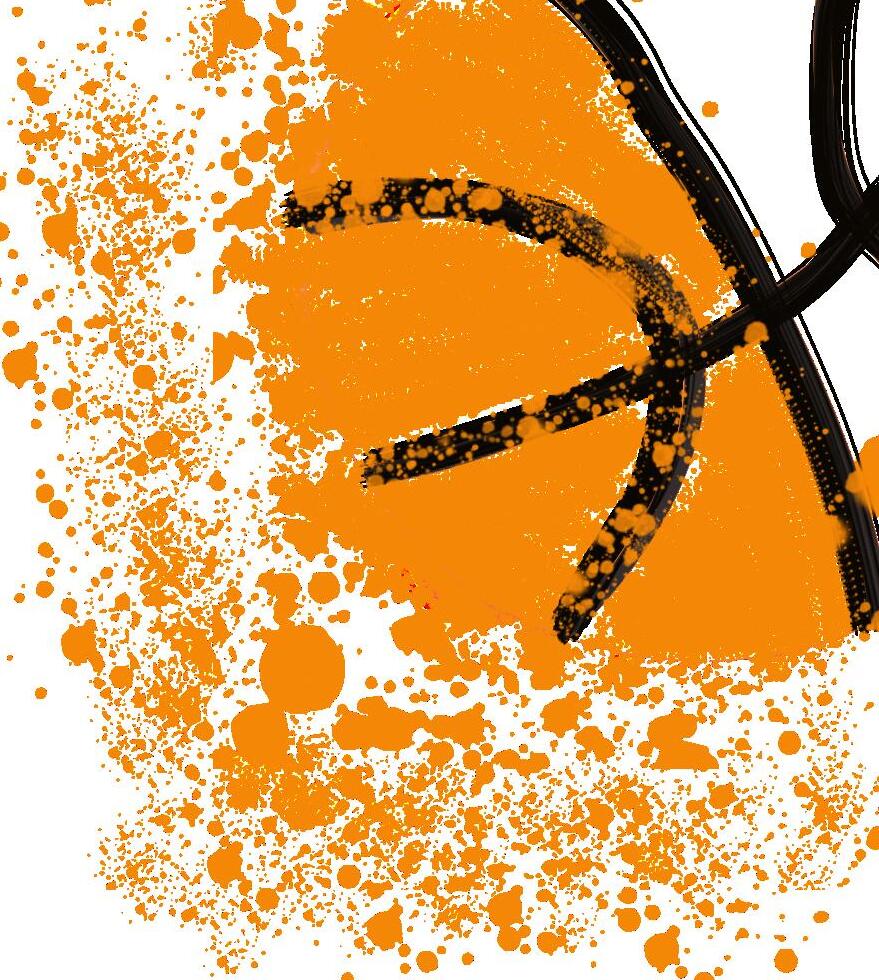
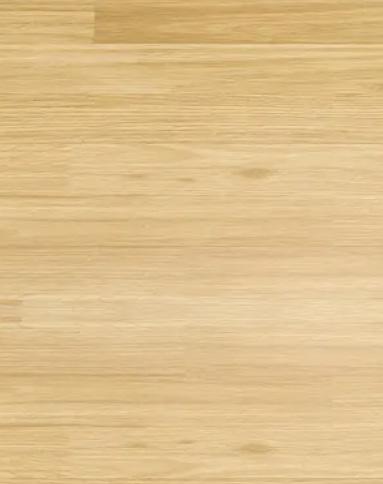
PALO ALTO, CALIFORNIA 94301

